Forecasting of Freight Rates in Large Ore Carrier Shipping Market
VerifiedAdded on 2022/12/21
|54
|14581
|1
AI Summary
This dissertation explores the forecasting of freight rates in the large ore carrier shipping market by analyzing the influential variables of demand and supply. It aims to understand how these variables directly and indirectly affect the freight rate and freight market. The study uses multiple regression models and secondary data analysis to formulate the equation and obtain results. The findings show a positive correlation between global economic environment, seaborne cargo, and building production, while a negative relationship is observed between transport costs, scrapping & losses.
Contribute Materials
Your contribution can guide someone’s learning journey. Share your
documents today.
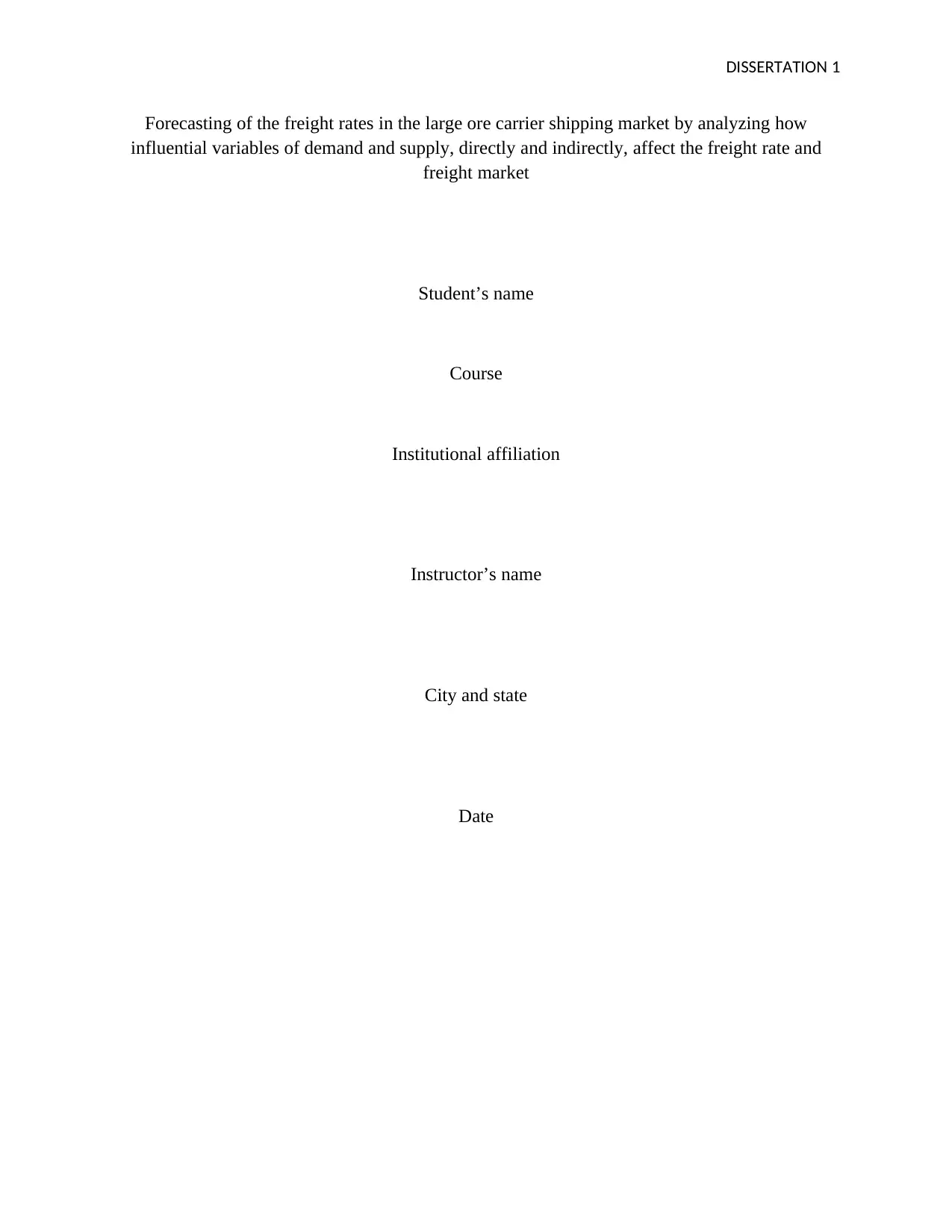
DISSERTATION 1
Forecasting of the freight rates in the large ore carrier shipping market by analyzing how
influential variables of demand and supply, directly and indirectly, affect the freight rate and
freight market
Student’s name
Course
Institutional affiliation
Instructor’s name
City and state
Date
Forecasting of the freight rates in the large ore carrier shipping market by analyzing how
influential variables of demand and supply, directly and indirectly, affect the freight rate and
freight market
Student’s name
Course
Institutional affiliation
Instructor’s name
City and state
Date
Secure Best Marks with AI Grader
Need help grading? Try our AI Grader for instant feedback on your assignments.
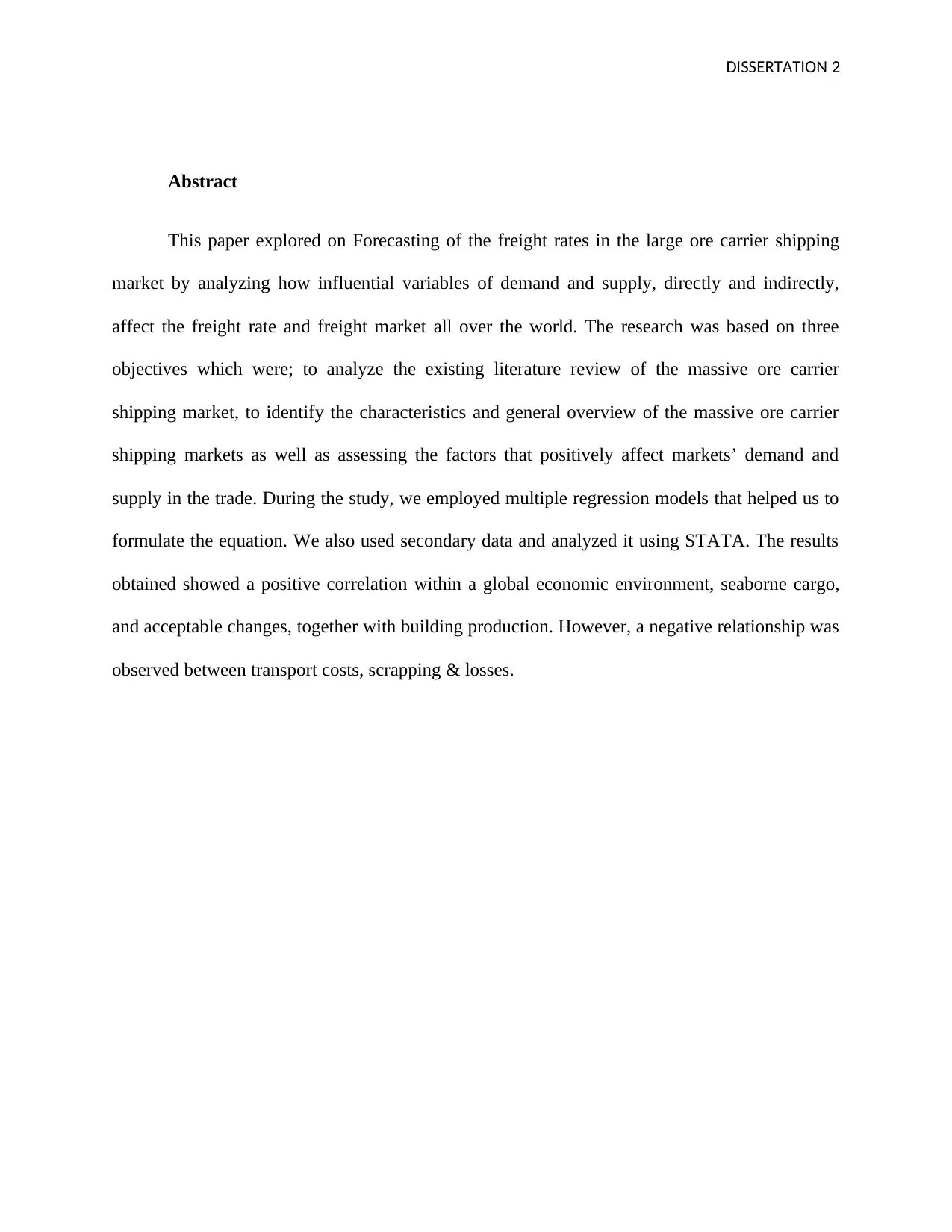
DISSERTATION 2
Abstract
This paper explored on Forecasting of the freight rates in the large ore carrier shipping
market by analyzing how influential variables of demand and supply, directly and indirectly,
affect the freight rate and freight market all over the world. The research was based on three
objectives which were; to analyze the existing literature review of the massive ore carrier
shipping market, to identify the characteristics and general overview of the massive ore carrier
shipping markets as well as assessing the factors that positively affect markets’ demand and
supply in the trade. During the study, we employed multiple regression models that helped us to
formulate the equation. We also used secondary data and analyzed it using STATA. The results
obtained showed a positive correlation within a global economic environment, seaborne cargo,
and acceptable changes, together with building production. However, a negative relationship was
observed between transport costs, scrapping & losses.
Abstract
This paper explored on Forecasting of the freight rates in the large ore carrier shipping
market by analyzing how influential variables of demand and supply, directly and indirectly,
affect the freight rate and freight market all over the world. The research was based on three
objectives which were; to analyze the existing literature review of the massive ore carrier
shipping market, to identify the characteristics and general overview of the massive ore carrier
shipping markets as well as assessing the factors that positively affect markets’ demand and
supply in the trade. During the study, we employed multiple regression models that helped us to
formulate the equation. We also used secondary data and analyzed it using STATA. The results
obtained showed a positive correlation within a global economic environment, seaborne cargo,
and acceptable changes, together with building production. However, a negative relationship was
observed between transport costs, scrapping & losses.
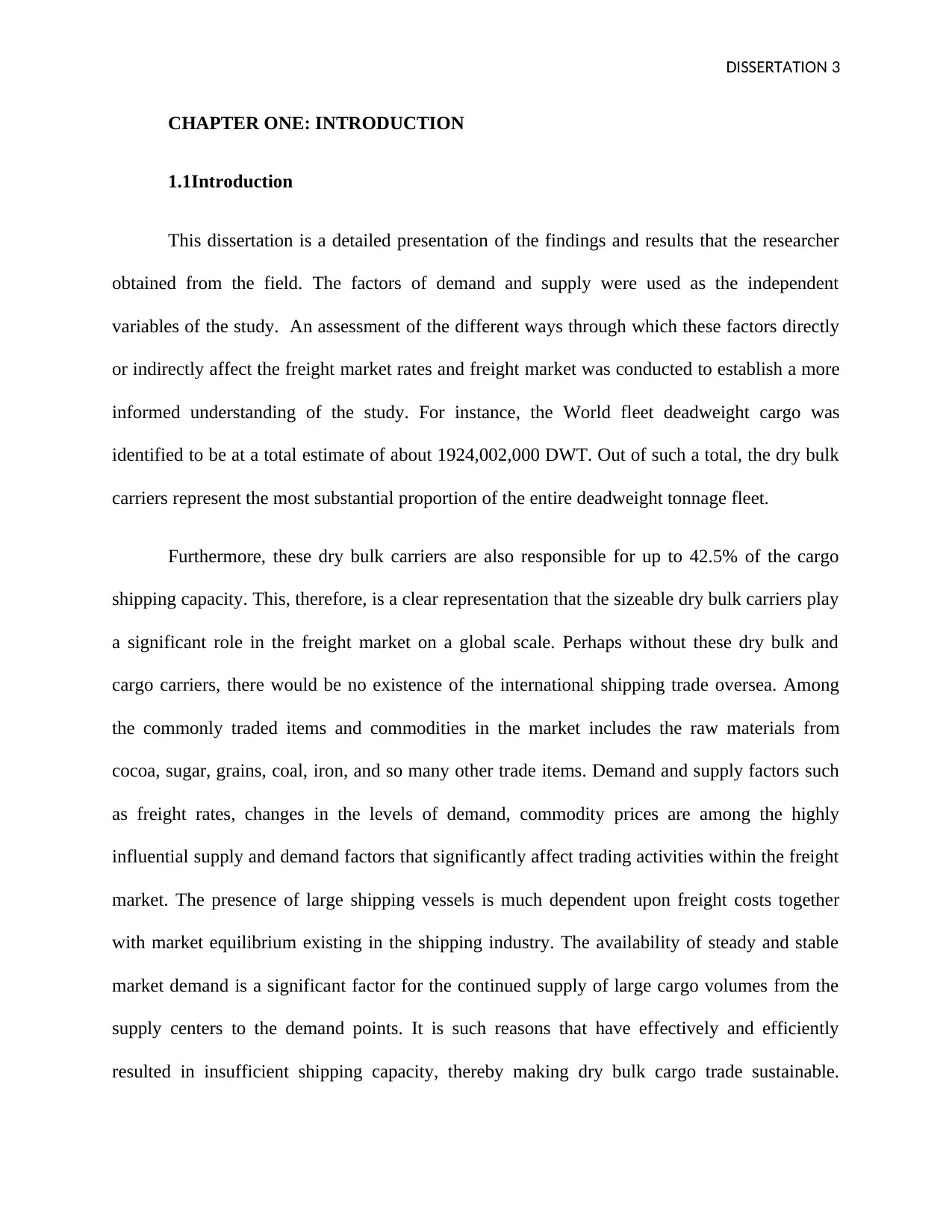
DISSERTATION 3
CHAPTER ONE: INTRODUCTION
1.1Introduction
This dissertation is a detailed presentation of the findings and results that the researcher
obtained from the field. The factors of demand and supply were used as the independent
variables of the study. An assessment of the different ways through which these factors directly
or indirectly affect the freight market rates and freight market was conducted to establish a more
informed understanding of the study. For instance, the World fleet deadweight cargo was
identified to be at a total estimate of about 1924,002,000 DWT. Out of such a total, the dry bulk
carriers represent the most substantial proportion of the entire deadweight tonnage fleet.
Furthermore, these dry bulk carriers are also responsible for up to 42.5% of the cargo
shipping capacity. This, therefore, is a clear representation that the sizeable dry bulk carriers play
a significant role in the freight market on a global scale. Perhaps without these dry bulk and
cargo carriers, there would be no existence of the international shipping trade oversea. Among
the commonly traded items and commodities in the market includes the raw materials from
cocoa, sugar, grains, coal, iron, and so many other trade items. Demand and supply factors such
as freight rates, changes in the levels of demand, commodity prices are among the highly
influential supply and demand factors that significantly affect trading activities within the freight
market. The presence of large shipping vessels is much dependent upon freight costs together
with market equilibrium existing in the shipping industry. The availability of steady and stable
market demand is a significant factor for the continued supply of large cargo volumes from the
supply centers to the demand points. It is such reasons that have effectively and efficiently
resulted in insufficient shipping capacity, thereby making dry bulk cargo trade sustainable.
CHAPTER ONE: INTRODUCTION
1.1Introduction
This dissertation is a detailed presentation of the findings and results that the researcher
obtained from the field. The factors of demand and supply were used as the independent
variables of the study. An assessment of the different ways through which these factors directly
or indirectly affect the freight market rates and freight market was conducted to establish a more
informed understanding of the study. For instance, the World fleet deadweight cargo was
identified to be at a total estimate of about 1924,002,000 DWT. Out of such a total, the dry bulk
carriers represent the most substantial proportion of the entire deadweight tonnage fleet.
Furthermore, these dry bulk carriers are also responsible for up to 42.5% of the cargo
shipping capacity. This, therefore, is a clear representation that the sizeable dry bulk carriers play
a significant role in the freight market on a global scale. Perhaps without these dry bulk and
cargo carriers, there would be no existence of the international shipping trade oversea. Among
the commonly traded items and commodities in the market includes the raw materials from
cocoa, sugar, grains, coal, iron, and so many other trade items. Demand and supply factors such
as freight rates, changes in the levels of demand, commodity prices are among the highly
influential supply and demand factors that significantly affect trading activities within the freight
market. The presence of large shipping vessels is much dependent upon freight costs together
with market equilibrium existing in the shipping industry. The availability of steady and stable
market demand is a significant factor for the continued supply of large cargo volumes from the
supply centers to the demand points. It is such reasons that have effectively and efficiently
resulted in insufficient shipping capacity, thereby making dry bulk cargo trade sustainable.
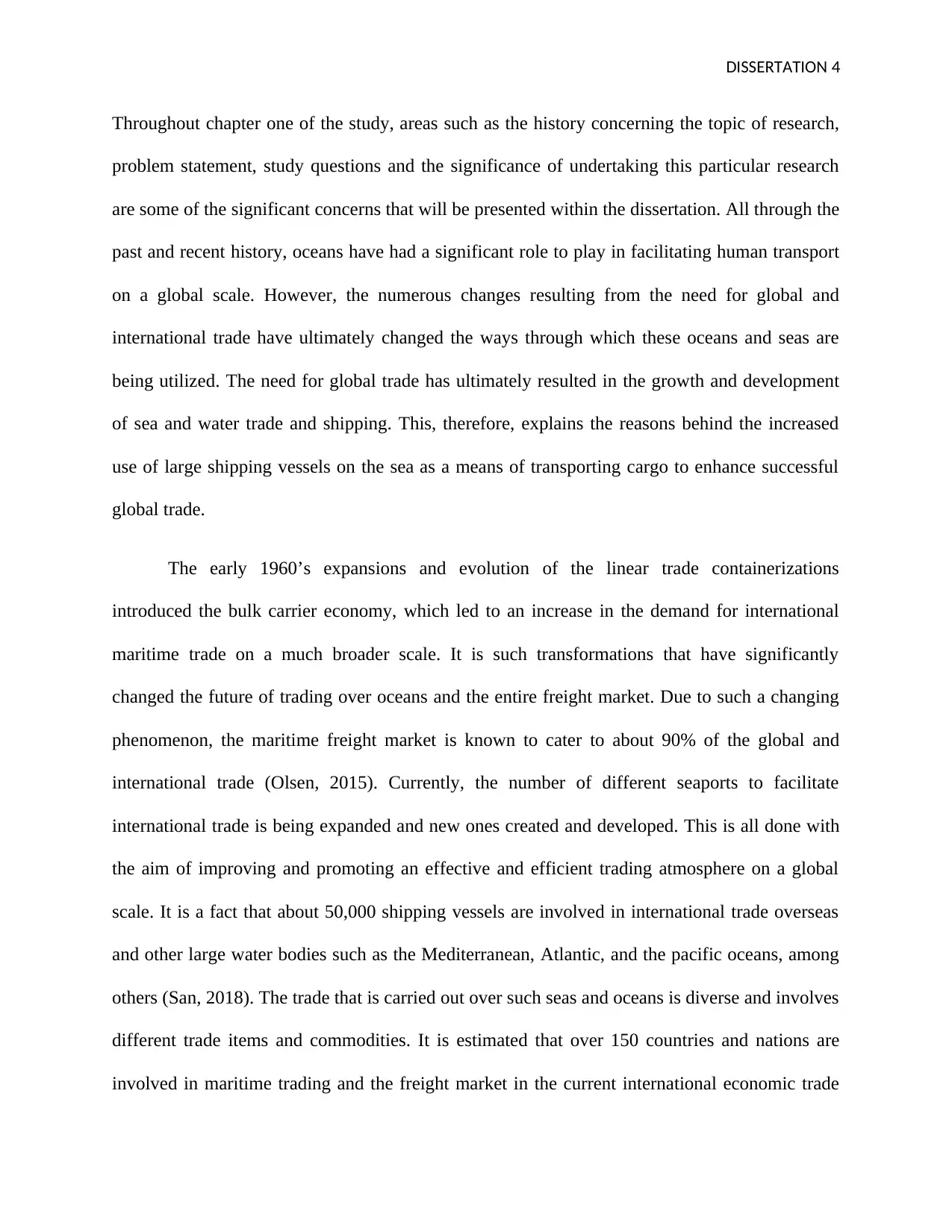
DISSERTATION 4
Throughout chapter one of the study, areas such as the history concerning the topic of research,
problem statement, study questions and the significance of undertaking this particular research
are some of the significant concerns that will be presented within the dissertation. All through the
past and recent history, oceans have had a significant role to play in facilitating human transport
on a global scale. However, the numerous changes resulting from the need for global and
international trade have ultimately changed the ways through which these oceans and seas are
being utilized. The need for global trade has ultimately resulted in the growth and development
of sea and water trade and shipping. This, therefore, explains the reasons behind the increased
use of large shipping vessels on the sea as a means of transporting cargo to enhance successful
global trade.
The early 1960’s expansions and evolution of the linear trade containerizations
introduced the bulk carrier economy, which led to an increase in the demand for international
maritime trade on a much broader scale. It is such transformations that have significantly
changed the future of trading over oceans and the entire freight market. Due to such a changing
phenomenon, the maritime freight market is known to cater to about 90% of the global and
international trade (Olsen, 2015). Currently, the number of different seaports to facilitate
international trade is being expanded and new ones created and developed. This is all done with
the aim of improving and promoting an effective and efficient trading atmosphere on a global
scale. It is a fact that about 50,000 shipping vessels are involved in international trade overseas
and other large water bodies such as the Mediterranean, Atlantic, and the pacific oceans, among
others (San, 2018). The trade that is carried out over such seas and oceans is diverse and involves
different trade items and commodities. It is estimated that over 150 countries and nations are
involved in maritime trading and the freight market in the current international economic trade
Throughout chapter one of the study, areas such as the history concerning the topic of research,
problem statement, study questions and the significance of undertaking this particular research
are some of the significant concerns that will be presented within the dissertation. All through the
past and recent history, oceans have had a significant role to play in facilitating human transport
on a global scale. However, the numerous changes resulting from the need for global and
international trade have ultimately changed the ways through which these oceans and seas are
being utilized. The need for global trade has ultimately resulted in the growth and development
of sea and water trade and shipping. This, therefore, explains the reasons behind the increased
use of large shipping vessels on the sea as a means of transporting cargo to enhance successful
global trade.
The early 1960’s expansions and evolution of the linear trade containerizations
introduced the bulk carrier economy, which led to an increase in the demand for international
maritime trade on a much broader scale. It is such transformations that have significantly
changed the future of trading over oceans and the entire freight market. Due to such a changing
phenomenon, the maritime freight market is known to cater to about 90% of the global and
international trade (Olsen, 2015). Currently, the number of different seaports to facilitate
international trade is being expanded and new ones created and developed. This is all done with
the aim of improving and promoting an effective and efficient trading atmosphere on a global
scale. It is a fact that about 50,000 shipping vessels are involved in international trade overseas
and other large water bodies such as the Mediterranean, Atlantic, and the pacific oceans, among
others (San, 2018). The trade that is carried out over such seas and oceans is diverse and involves
different trade items and commodities. It is estimated that over 150 countries and nations are
involved in maritime trading and the freight market in the current international economic trade
Secure Best Marks with AI Grader
Need help grading? Try our AI Grader for instant feedback on your assignments.
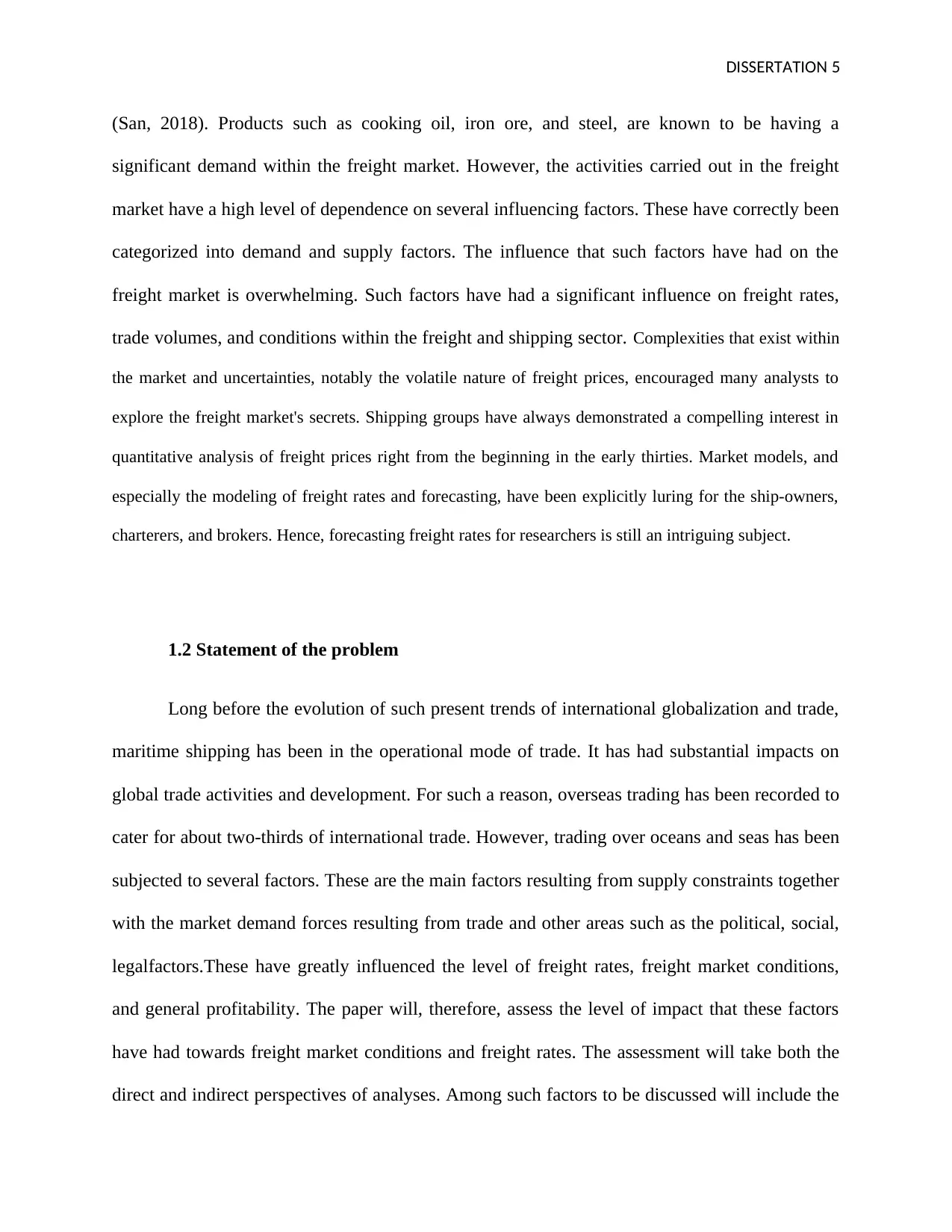
DISSERTATION 5
(San, 2018). Products such as cooking oil, iron ore, and steel, are known to be having a
significant demand within the freight market. However, the activities carried out in the freight
market have a high level of dependence on several influencing factors. These have correctly been
categorized into demand and supply factors. The influence that such factors have had on the
freight market is overwhelming. Such factors have had a significant influence on freight rates,
trade volumes, and conditions within the freight and shipping sector. Complexities that exist within
the market and uncertainties, notably the volatile nature of freight prices, encouraged many analysts to
explore the freight market's secrets. Shipping groups have always demonstrated a compelling interest in
quantitative analysis of freight prices right from the beginning in the early thirties. Market models, and
especially the modeling of freight rates and forecasting, have been explicitly luring for the ship-owners,
charterers, and brokers. Hence, forecasting freight rates for researchers is still an intriguing subject.
1.2 Statement of the problem
Long before the evolution of such present trends of international globalization and trade,
maritime shipping has been in the operational mode of trade. It has had substantial impacts on
global trade activities and development. For such a reason, overseas trading has been recorded to
cater for about two-thirds of international trade. However, trading over oceans and seas has been
subjected to several factors. These are the main factors resulting from supply constraints together
with the market demand forces resulting from trade and other areas such as the political, social,
legalfactors.These have greatly influenced the level of freight rates, freight market conditions,
and general profitability. The paper will, therefore, assess the level of impact that these factors
have had towards freight market conditions and freight rates. The assessment will take both the
direct and indirect perspectives of analyses. Among such factors to be discussed will include the
(San, 2018). Products such as cooking oil, iron ore, and steel, are known to be having a
significant demand within the freight market. However, the activities carried out in the freight
market have a high level of dependence on several influencing factors. These have correctly been
categorized into demand and supply factors. The influence that such factors have had on the
freight market is overwhelming. Such factors have had a significant influence on freight rates,
trade volumes, and conditions within the freight and shipping sector. Complexities that exist within
the market and uncertainties, notably the volatile nature of freight prices, encouraged many analysts to
explore the freight market's secrets. Shipping groups have always demonstrated a compelling interest in
quantitative analysis of freight prices right from the beginning in the early thirties. Market models, and
especially the modeling of freight rates and forecasting, have been explicitly luring for the ship-owners,
charterers, and brokers. Hence, forecasting freight rates for researchers is still an intriguing subject.
1.2 Statement of the problem
Long before the evolution of such present trends of international globalization and trade,
maritime shipping has been in the operational mode of trade. It has had substantial impacts on
global trade activities and development. For such a reason, overseas trading has been recorded to
cater for about two-thirds of international trade. However, trading over oceans and seas has been
subjected to several factors. These are the main factors resulting from supply constraints together
with the market demand forces resulting from trade and other areas such as the political, social,
legalfactors.These have greatly influenced the level of freight rates, freight market conditions,
and general profitability. The paper will, therefore, assess the level of impact that these factors
have had towards freight market conditions and freight rates. The assessment will take both the
direct and indirect perspectives of analyses. Among such factors to be discussed will include the

DISSERTATION 6
supply rates, prices both the demand and supply, especially those concerning the dry bulk
products. Therefore, due to the complexity involved in the freight market, the primary purpose of
this paper will take into consideration the influence that these supply and demand factors have
had on the operations undertaken within the general freight market. Other macro-economic
factors will also be analyzed to generate a reliable and relevant research study.
1.3 Aims of the study
1.3.1 General objective
The main aim of carrying out this study is to analyze the large ore carrier shipping market
and ultimately make predictions and forecasts about shipping rates within the industry. It also
aims at predicting market prices in the large ore carrier shipping market by analyzing how
significant the independent variables of the study, directly and indirectly, affect the freight rate
and freight market. This will be correctly done to assist the different players in the market,
including charters and brokers, to make investments and other decisions in the market.
1.3.2 Specific objectives
Below are the critical study goals the researcher will use
1. The first specific objective of the study was to analyze the existing
information about large ore carrier maritime industry
2. The second specific aim for undertaking this research study was to analyze
the characteristics of the general overview of the massive ore carrier shipping market as
supply rates, prices both the demand and supply, especially those concerning the dry bulk
products. Therefore, due to the complexity involved in the freight market, the primary purpose of
this paper will take into consideration the influence that these supply and demand factors have
had on the operations undertaken within the general freight market. Other macro-economic
factors will also be analyzed to generate a reliable and relevant research study.
1.3 Aims of the study
1.3.1 General objective
The main aim of carrying out this study is to analyze the large ore carrier shipping market
and ultimately make predictions and forecasts about shipping rates within the industry. It also
aims at predicting market prices in the large ore carrier shipping market by analyzing how
significant the independent variables of the study, directly and indirectly, affect the freight rate
and freight market. This will be correctly done to assist the different players in the market,
including charters and brokers, to make investments and other decisions in the market.
1.3.2 Specific objectives
Below are the critical study goals the researcher will use
1. The first specific objective of the study was to analyze the existing
information about large ore carrier maritime industry
2. The second specific aim for undertaking this research study was to analyze
the characteristics of the general overview of the massive ore carrier shipping market as
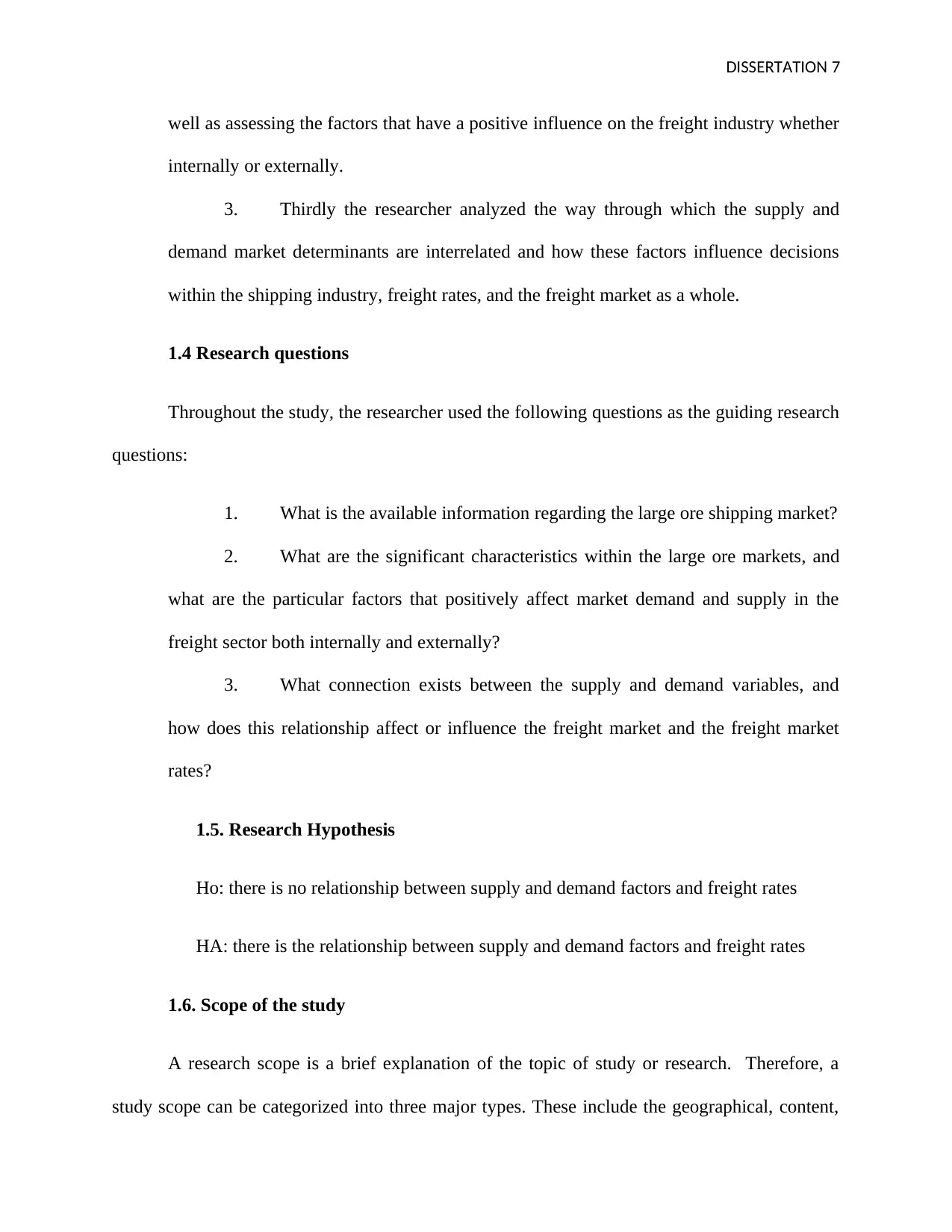
DISSERTATION 7
well as assessing the factors that have a positive influence on the freight industry whether
internally or externally.
3. Thirdly the researcher analyzed the way through which the supply and
demand market determinants are interrelated and how these factors influence decisions
within the shipping industry, freight rates, and the freight market as a whole.
1.4 Research questions
Throughout the study, the researcher used the following questions as the guiding research
questions:
1. What is the available information regarding the large ore shipping market?
2. What are the significant characteristics within the large ore markets, and
what are the particular factors that positively affect market demand and supply in the
freight sector both internally and externally?
3. What connection exists between the supply and demand variables, and
how does this relationship affect or influence the freight market and the freight market
rates?
1.5. Research Hypothesis
Ho: there is no relationship between supply and demand factors and freight rates
HA: there is the relationship between supply and demand factors and freight rates
1.6. Scope of the study
A research scope is a brief explanation of the topic of study or research. Therefore, a
study scope can be categorized into three major types. These include the geographical, content,
well as assessing the factors that have a positive influence on the freight industry whether
internally or externally.
3. Thirdly the researcher analyzed the way through which the supply and
demand market determinants are interrelated and how these factors influence decisions
within the shipping industry, freight rates, and the freight market as a whole.
1.4 Research questions
Throughout the study, the researcher used the following questions as the guiding research
questions:
1. What is the available information regarding the large ore shipping market?
2. What are the significant characteristics within the large ore markets, and
what are the particular factors that positively affect market demand and supply in the
freight sector both internally and externally?
3. What connection exists between the supply and demand variables, and
how does this relationship affect or influence the freight market and the freight market
rates?
1.5. Research Hypothesis
Ho: there is no relationship between supply and demand factors and freight rates
HA: there is the relationship between supply and demand factors and freight rates
1.6. Scope of the study
A research scope is a brief explanation of the topic of study or research. Therefore, a
study scope can be categorized into three major types. These include the geographical, content,
Paraphrase This Document
Need a fresh take? Get an instant paraphrase of this document with our AI Paraphraser
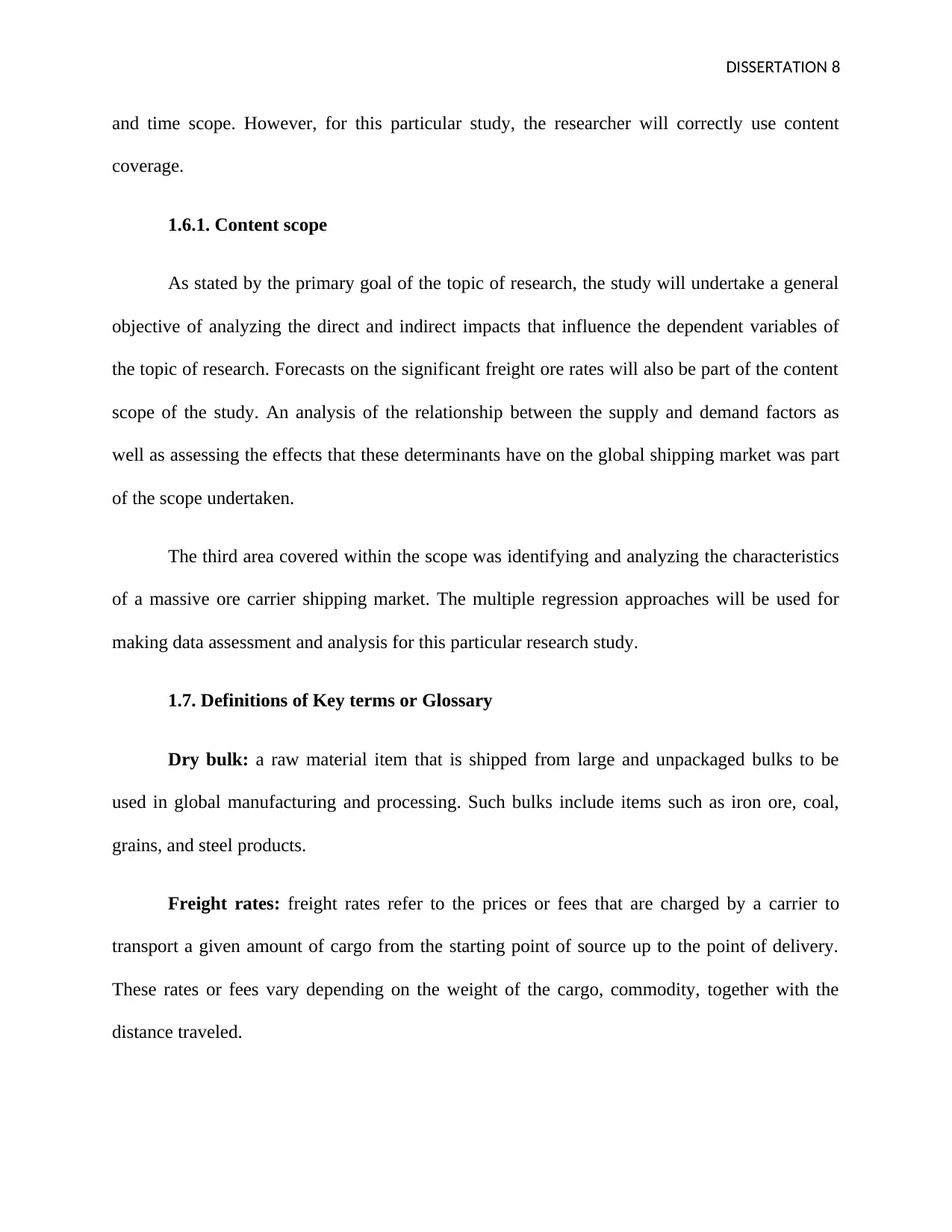
DISSERTATION 8
and time scope. However, for this particular study, the researcher will correctly use content
coverage.
1.6.1. Content scope
As stated by the primary goal of the topic of research, the study will undertake a general
objective of analyzing the direct and indirect impacts that influence the dependent variables of
the topic of research. Forecasts on the significant freight ore rates will also be part of the content
scope of the study. An analysis of the relationship between the supply and demand factors as
well as assessing the effects that these determinants have on the global shipping market was part
of the scope undertaken.
The third area covered within the scope was identifying and analyzing the characteristics
of a massive ore carrier shipping market. The multiple regression approaches will be used for
making data assessment and analysis for this particular research study.
1.7. Definitions of Key terms or Glossary
Dry bulk: a raw material item that is shipped from large and unpackaged bulks to be
used in global manufacturing and processing. Such bulks include items such as iron ore, coal,
grains, and steel products.
Freight rates: freight rates refer to the prices or fees that are charged by a carrier to
transport a given amount of cargo from the starting point of source up to the point of delivery.
These rates or fees vary depending on the weight of the cargo, commodity, together with the
distance traveled.
and time scope. However, for this particular study, the researcher will correctly use content
coverage.
1.6.1. Content scope
As stated by the primary goal of the topic of research, the study will undertake a general
objective of analyzing the direct and indirect impacts that influence the dependent variables of
the topic of research. Forecasts on the significant freight ore rates will also be part of the content
scope of the study. An analysis of the relationship between the supply and demand factors as
well as assessing the effects that these determinants have on the global shipping market was part
of the scope undertaken.
The third area covered within the scope was identifying and analyzing the characteristics
of a massive ore carrier shipping market. The multiple regression approaches will be used for
making data assessment and analysis for this particular research study.
1.7. Definitions of Key terms or Glossary
Dry bulk: a raw material item that is shipped from large and unpackaged bulks to be
used in global manufacturing and processing. Such bulks include items such as iron ore, coal,
grains, and steel products.
Freight rates: freight rates refer to the prices or fees that are charged by a carrier to
transport a given amount of cargo from the starting point of source up to the point of delivery.
These rates or fees vary depending on the weight of the cargo, commodity, together with the
distance traveled.
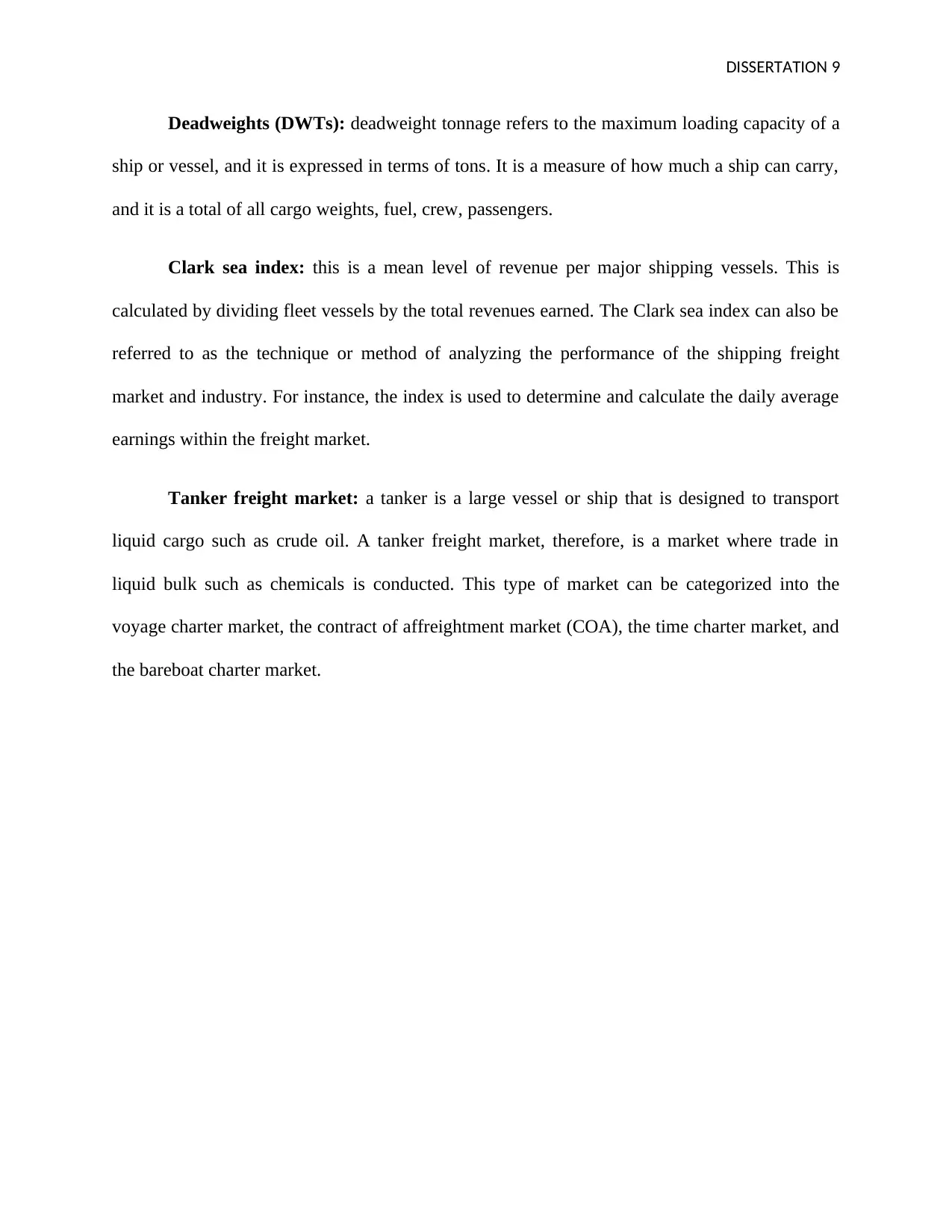
DISSERTATION 9
Deadweights (DWTs): deadweight tonnage refers to the maximum loading capacity of a
ship or vessel, and it is expressed in terms of tons. It is a measure of how much a ship can carry,
and it is a total of all cargo weights, fuel, crew, passengers.
Clark sea index: this is a mean level of revenue per major shipping vessels. This is
calculated by dividing fleet vessels by the total revenues earned. The Clark sea index can also be
referred to as the technique or method of analyzing the performance of the shipping freight
market and industry. For instance, the index is used to determine and calculate the daily average
earnings within the freight market.
Tanker freight market: a tanker is a large vessel or ship that is designed to transport
liquid cargo such as crude oil. A tanker freight market, therefore, is a market where trade in
liquid bulk such as chemicals is conducted. This type of market can be categorized into the
voyage charter market, the contract of affreightment market (COA), the time charter market, and
the bareboat charter market.
Deadweights (DWTs): deadweight tonnage refers to the maximum loading capacity of a
ship or vessel, and it is expressed in terms of tons. It is a measure of how much a ship can carry,
and it is a total of all cargo weights, fuel, crew, passengers.
Clark sea index: this is a mean level of revenue per major shipping vessels. This is
calculated by dividing fleet vessels by the total revenues earned. The Clark sea index can also be
referred to as the technique or method of analyzing the performance of the shipping freight
market and industry. For instance, the index is used to determine and calculate the daily average
earnings within the freight market.
Tanker freight market: a tanker is a large vessel or ship that is designed to transport
liquid cargo such as crude oil. A tanker freight market, therefore, is a market where trade in
liquid bulk such as chemicals is conducted. This type of market can be categorized into the
voyage charter market, the contract of affreightment market (COA), the time charter market, and
the bareboat charter market.
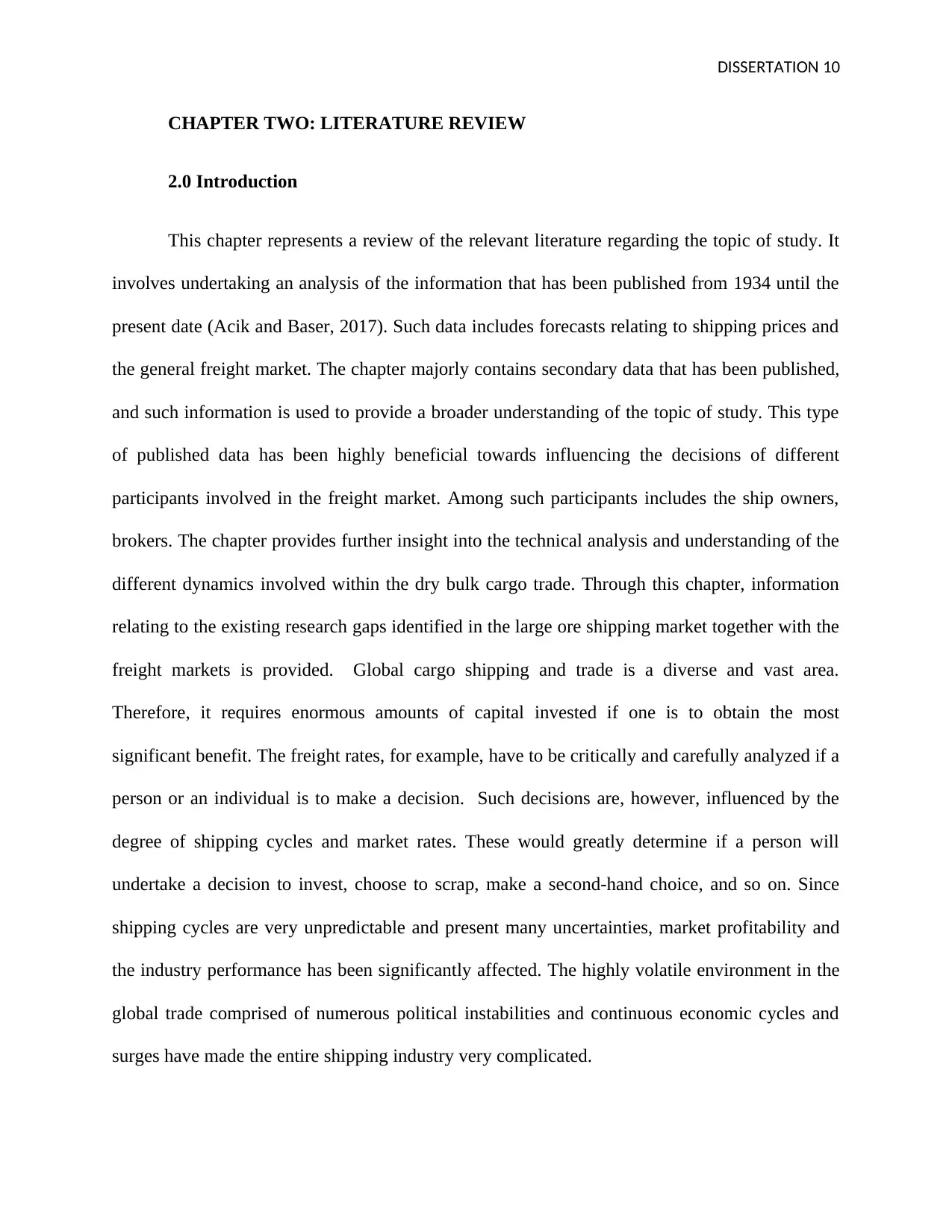
DISSERTATION 10
CHAPTER TWO: LITERATURE REVIEW
2.0 Introduction
This chapter represents a review of the relevant literature regarding the topic of study. It
involves undertaking an analysis of the information that has been published from 1934 until the
present date (Acik and Baser, 2017). Such data includes forecasts relating to shipping prices and
the general freight market. The chapter majorly contains secondary data that has been published,
and such information is used to provide a broader understanding of the topic of study. This type
of published data has been highly beneficial towards influencing the decisions of different
participants involved in the freight market. Among such participants includes the ship owners,
brokers. The chapter provides further insight into the technical analysis and understanding of the
different dynamics involved within the dry bulk cargo trade. Through this chapter, information
relating to the existing research gaps identified in the large ore shipping market together with the
freight markets is provided. Global cargo shipping and trade is a diverse and vast area.
Therefore, it requires enormous amounts of capital invested if one is to obtain the most
significant benefit. The freight rates, for example, have to be critically and carefully analyzed if a
person or an individual is to make a decision. Such decisions are, however, influenced by the
degree of shipping cycles and market rates. These would greatly determine if a person will
undertake a decision to invest, choose to scrap, make a second-hand choice, and so on. Since
shipping cycles are very unpredictable and present many uncertainties, market profitability and
the industry performance has been significantly affected. The highly volatile environment in the
global trade comprised of numerous political instabilities and continuous economic cycles and
surges have made the entire shipping industry very complicated.
CHAPTER TWO: LITERATURE REVIEW
2.0 Introduction
This chapter represents a review of the relevant literature regarding the topic of study. It
involves undertaking an analysis of the information that has been published from 1934 until the
present date (Acik and Baser, 2017). Such data includes forecasts relating to shipping prices and
the general freight market. The chapter majorly contains secondary data that has been published,
and such information is used to provide a broader understanding of the topic of study. This type
of published data has been highly beneficial towards influencing the decisions of different
participants involved in the freight market. Among such participants includes the ship owners,
brokers. The chapter provides further insight into the technical analysis and understanding of the
different dynamics involved within the dry bulk cargo trade. Through this chapter, information
relating to the existing research gaps identified in the large ore shipping market together with the
freight markets is provided. Global cargo shipping and trade is a diverse and vast area.
Therefore, it requires enormous amounts of capital invested if one is to obtain the most
significant benefit. The freight rates, for example, have to be critically and carefully analyzed if a
person or an individual is to make a decision. Such decisions are, however, influenced by the
degree of shipping cycles and market rates. These would greatly determine if a person will
undertake a decision to invest, choose to scrap, make a second-hand choice, and so on. Since
shipping cycles are very unpredictable and present many uncertainties, market profitability and
the industry performance has been significantly affected. The highly volatile environment in the
global trade comprised of numerous political instabilities and continuous economic cycles and
surges have made the entire shipping industry very complicated.
Secure Best Marks with AI Grader
Need help grading? Try our AI Grader for instant feedback on your assignments.

DISSERTATION 11
This chapter will, therefore, present information that is relevant to the topic of study.
Information will be explained while strictly referring to the previous significant aspects such as
research questions, as well as focusing on the dependent and independent variables.
2.1 review of the massive ore shipping market
The Shipping industry plays a significant role in global and international trade and
general economic performance. However, much as a certain percentage of international trade is
carried out over air, road, and railway. The most significant portion is carried out over the water
using the large shipping vessels and ships. Some of the reasons for such dominance identified
included the relatively low costs associated with shipping by sea or oceans. The increasing
demand for international trade in a variety of goods and commodities is yet another reason for
the growing trend. Besides the 2016 period when the shipping market experienced hard-hitting
declines, there has been an overall improvement throughout the following years. For example,
the Clark Sea Index of 2017 showed an average earning of about $10,767 per day. (Hellenic
Shipping News, 2018). However, this was also estimated to be 8% below from the 2008
American financial crisis. On the positive side, bulk carriers, together with the container markets,
we're forecasted to have increased in performance. For instance, both the large bulk carriers and
the container markets had estimated earnings of around 77% and 25% respectively within the
2017year of income. The tanker earnings, on the other hand, were valued to have fallen and
declined by up to 35% during the same year of 2017 (Jugovic et al., 2015).
To further elaborate on the positive trend of the ore shipping market, it is also notable
that seaborne trade had grown by up to 3.9% during 2017. This was reported to be the, fastest
growth in the freight market. Oversea volumes were summed up to about 11.6 billion tons, and
This chapter will, therefore, present information that is relevant to the topic of study.
Information will be explained while strictly referring to the previous significant aspects such as
research questions, as well as focusing on the dependent and independent variables.
2.1 review of the massive ore shipping market
The Shipping industry plays a significant role in global and international trade and
general economic performance. However, much as a certain percentage of international trade is
carried out over air, road, and railway. The most significant portion is carried out over the water
using the large shipping vessels and ships. Some of the reasons for such dominance identified
included the relatively low costs associated with shipping by sea or oceans. The increasing
demand for international trade in a variety of goods and commodities is yet another reason for
the growing trend. Besides the 2016 period when the shipping market experienced hard-hitting
declines, there has been an overall improvement throughout the following years. For example,
the Clark Sea Index of 2017 showed an average earning of about $10,767 per day. (Hellenic
Shipping News, 2018). However, this was also estimated to be 8% below from the 2008
American financial crisis. On the positive side, bulk carriers, together with the container markets,
we're forecasted to have increased in performance. For instance, both the large bulk carriers and
the container markets had estimated earnings of around 77% and 25% respectively within the
2017year of income. The tanker earnings, on the other hand, were valued to have fallen and
declined by up to 35% during the same year of 2017 (Jugovic et al., 2015).
To further elaborate on the positive trend of the ore shipping market, it is also notable
that seaborne trade had grown by up to 3.9% during 2017. This was reported to be the, fastest
growth in the freight market. Oversea volumes were summed up to about 11.6 billion tons, and
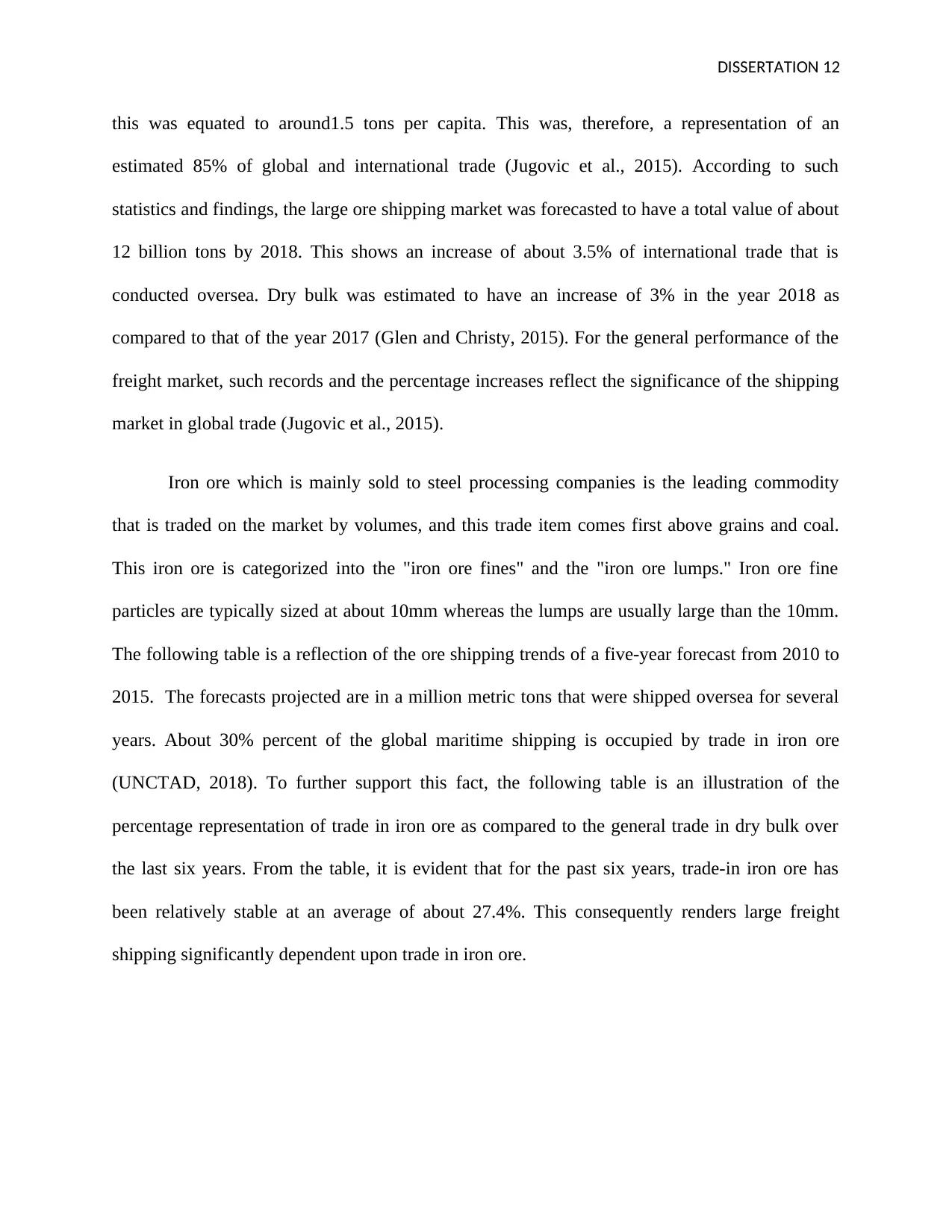
DISSERTATION 12
this was equated to around1.5 tons per capita. This was, therefore, a representation of an
estimated 85% of global and international trade (Jugovic et al., 2015). According to such
statistics and findings, the large ore shipping market was forecasted to have a total value of about
12 billion tons by 2018. This shows an increase of about 3.5% of international trade that is
conducted oversea. Dry bulk was estimated to have an increase of 3% in the year 2018 as
compared to that of the year 2017 (Glen and Christy, 2015). For the general performance of the
freight market, such records and the percentage increases reflect the significance of the shipping
market in global trade (Jugovic et al., 2015).
Iron ore which is mainly sold to steel processing companies is the leading commodity
that is traded on the market by volumes, and this trade item comes first above grains and coal.
This iron ore is categorized into the "iron ore fines" and the "iron ore lumps." Iron ore fine
particles are typically sized at about 10mm whereas the lumps are usually large than the 10mm.
The following table is a reflection of the ore shipping trends of a five-year forecast from 2010 to
2015. The forecasts projected are in a million metric tons that were shipped oversea for several
years. About 30% percent of the global maritime shipping is occupied by trade in iron ore
(UNCTAD, 2018). To further support this fact, the following table is an illustration of the
percentage representation of trade in iron ore as compared to the general trade in dry bulk over
the last six years. From the table, it is evident that for the past six years, trade-in iron ore has
been relatively stable at an average of about 27.4%. This consequently renders large freight
shipping significantly dependent upon trade in iron ore.
this was equated to around1.5 tons per capita. This was, therefore, a representation of an
estimated 85% of global and international trade (Jugovic et al., 2015). According to such
statistics and findings, the large ore shipping market was forecasted to have a total value of about
12 billion tons by 2018. This shows an increase of about 3.5% of international trade that is
conducted oversea. Dry bulk was estimated to have an increase of 3% in the year 2018 as
compared to that of the year 2017 (Glen and Christy, 2015). For the general performance of the
freight market, such records and the percentage increases reflect the significance of the shipping
market in global trade (Jugovic et al., 2015).
Iron ore which is mainly sold to steel processing companies is the leading commodity
that is traded on the market by volumes, and this trade item comes first above grains and coal.
This iron ore is categorized into the "iron ore fines" and the "iron ore lumps." Iron ore fine
particles are typically sized at about 10mm whereas the lumps are usually large than the 10mm.
The following table is a reflection of the ore shipping trends of a five-year forecast from 2010 to
2015. The forecasts projected are in a million metric tons that were shipped oversea for several
years. About 30% percent of the global maritime shipping is occupied by trade in iron ore
(UNCTAD, 2018). To further support this fact, the following table is an illustration of the
percentage representation of trade in iron ore as compared to the general trade in dry bulk over
the last six years. From the table, it is evident that for the past six years, trade-in iron ore has
been relatively stable at an average of about 27.4%. This consequently renders large freight
shipping significantly dependent upon trade in iron ore.
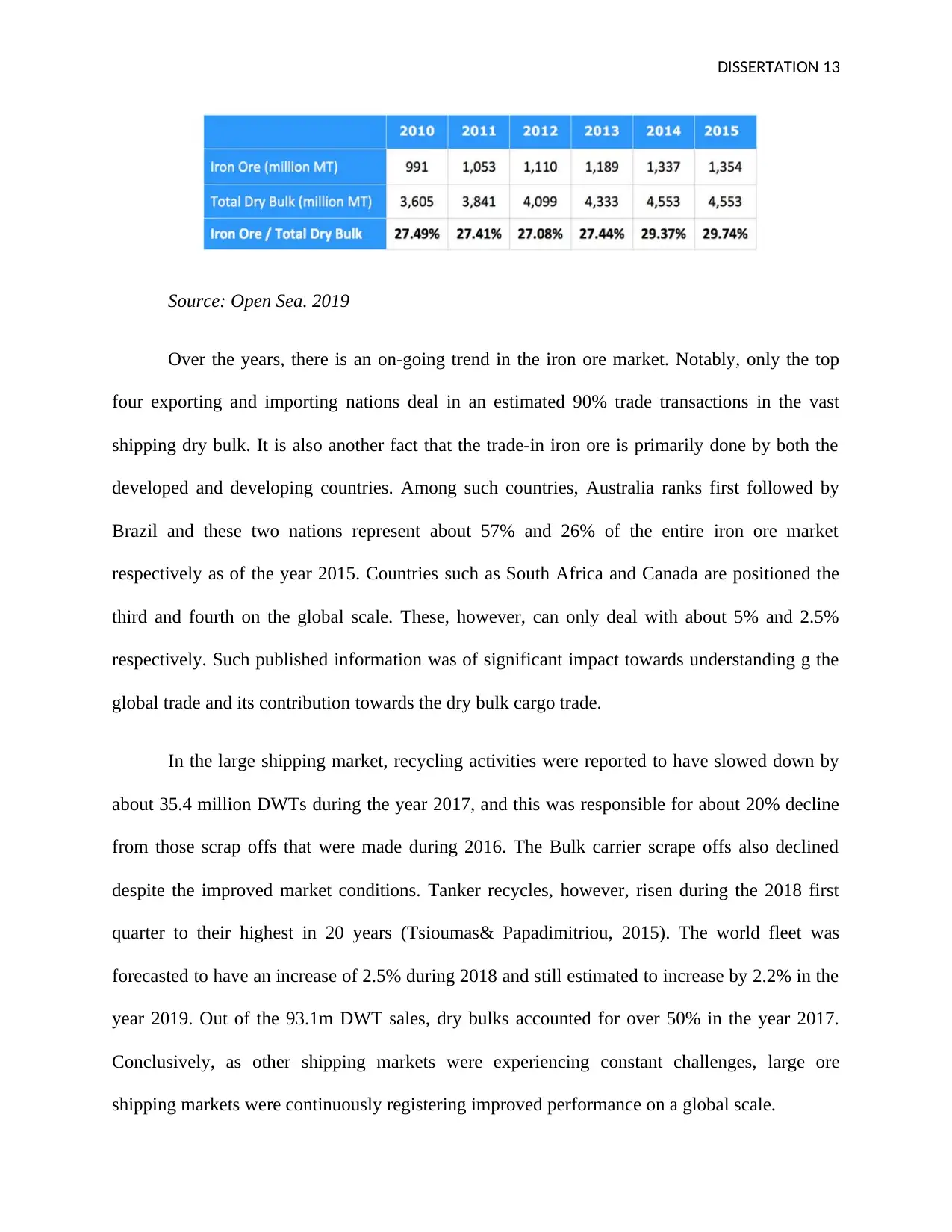
DISSERTATION 13
Source: Open Sea. 2019
Over the years, there is an on-going trend in the iron ore market. Notably, only the top
four exporting and importing nations deal in an estimated 90% trade transactions in the vast
shipping dry bulk. It is also another fact that the trade-in iron ore is primarily done by both the
developed and developing countries. Among such countries, Australia ranks first followed by
Brazil and these two nations represent about 57% and 26% of the entire iron ore market
respectively as of the year 2015. Countries such as South Africa and Canada are positioned the
third and fourth on the global scale. These, however, can only deal with about 5% and 2.5%
respectively. Such published information was of significant impact towards understanding g the
global trade and its contribution towards the dry bulk cargo trade.
In the large shipping market, recycling activities were reported to have slowed down by
about 35.4 million DWTs during the year 2017, and this was responsible for about 20% decline
from those scrap offs that were made during 2016. The Bulk carrier scrape offs also declined
despite the improved market conditions. Tanker recycles, however, risen during the 2018 first
quarter to their highest in 20 years (Tsioumas& Papadimitriou, 2015). The world fleet was
forecasted to have an increase of 2.5% during 2018 and still estimated to increase by 2.2% in the
year 2019. Out of the 93.1m DWT sales, dry bulks accounted for over 50% in the year 2017.
Conclusively, as other shipping markets were experiencing constant challenges, large ore
shipping markets were continuously registering improved performance on a global scale.
Source: Open Sea. 2019
Over the years, there is an on-going trend in the iron ore market. Notably, only the top
four exporting and importing nations deal in an estimated 90% trade transactions in the vast
shipping dry bulk. It is also another fact that the trade-in iron ore is primarily done by both the
developed and developing countries. Among such countries, Australia ranks first followed by
Brazil and these two nations represent about 57% and 26% of the entire iron ore market
respectively as of the year 2015. Countries such as South Africa and Canada are positioned the
third and fourth on the global scale. These, however, can only deal with about 5% and 2.5%
respectively. Such published information was of significant impact towards understanding g the
global trade and its contribution towards the dry bulk cargo trade.
In the large shipping market, recycling activities were reported to have slowed down by
about 35.4 million DWTs during the year 2017, and this was responsible for about 20% decline
from those scrap offs that were made during 2016. The Bulk carrier scrape offs also declined
despite the improved market conditions. Tanker recycles, however, risen during the 2018 first
quarter to their highest in 20 years (Tsioumas& Papadimitriou, 2015). The world fleet was
forecasted to have an increase of 2.5% during 2018 and still estimated to increase by 2.2% in the
year 2019. Out of the 93.1m DWT sales, dry bulks accounted for over 50% in the year 2017.
Conclusively, as other shipping markets were experiencing constant challenges, large ore
shipping markets were continuously registering improved performance on a global scale.
Paraphrase This Document
Need a fresh take? Get an instant paraphrase of this document with our AI Paraphraser
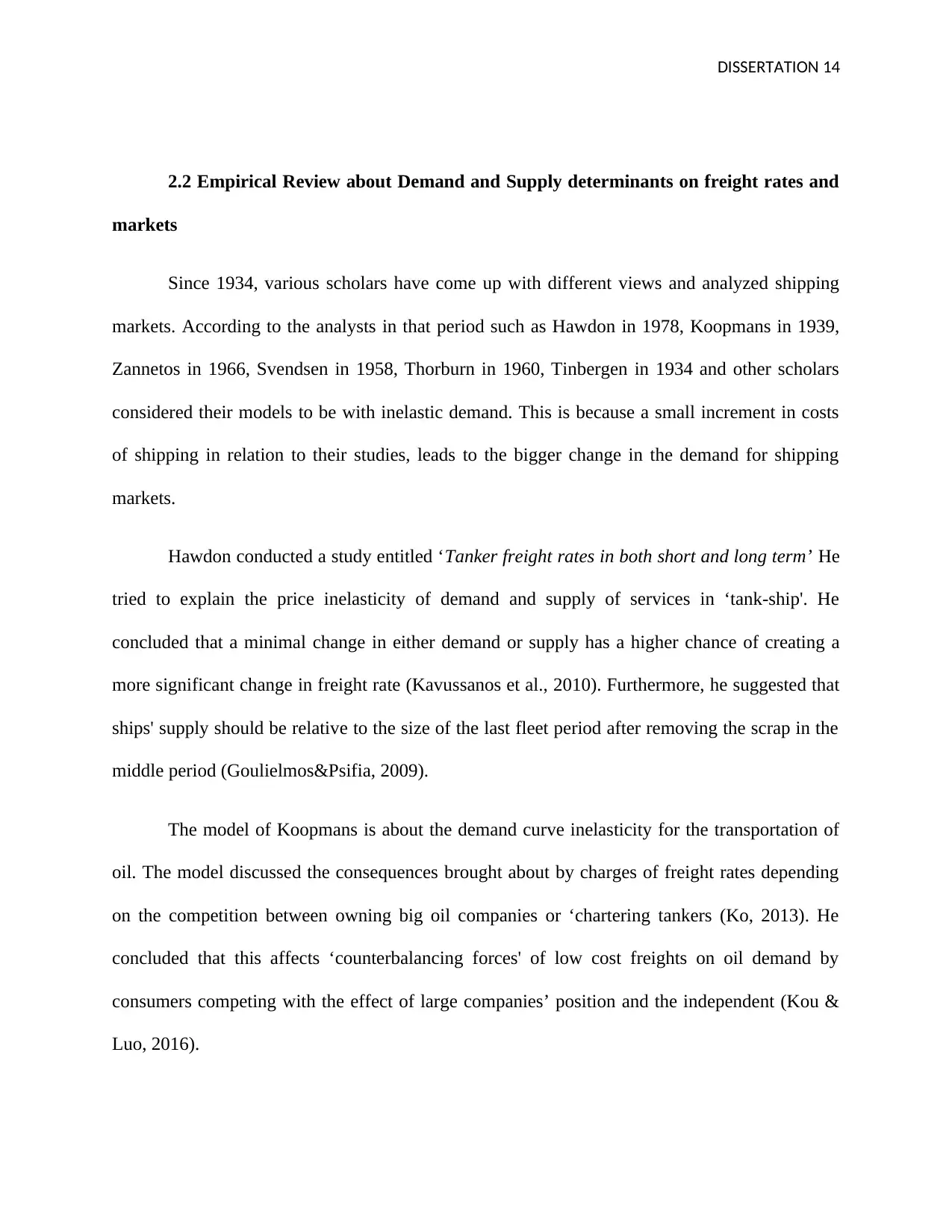
DISSERTATION 14
2.2 Empirical Review about Demand and Supply determinants on freight rates and
markets
Since 1934, various scholars have come up with different views and analyzed shipping
markets. According to the analysts in that period such as Hawdon in 1978, Koopmans in 1939,
Zannetos in 1966, Svendsen in 1958, Thorburn in 1960, Tinbergen in 1934 and other scholars
considered their models to be with inelastic demand. This is because a small increment in costs
of shipping in relation to their studies, leads to the bigger change in the demand for shipping
markets.
Hawdon conducted a study entitled ‘Tanker freight rates in both short and long term’ He
tried to explain the price inelasticity of demand and supply of services in ‘tank-ship'. He
concluded that a minimal change in either demand or supply has a higher chance of creating a
more significant change in freight rate (Kavussanos et al., 2010). Furthermore, he suggested that
ships' supply should be relative to the size of the last fleet period after removing the scrap in the
middle period (Goulielmos&Psifia, 2009).
The model of Koopmans is about the demand curve inelasticity for the transportation of
oil. The model discussed the consequences brought about by charges of freight rates depending
on the competition between owning big oil companies or ‘chartering tankers (Ko, 2013). He
concluded that this affects ‘counterbalancing forces' of low cost freights on oil demand by
consumers competing with the effect of large companies’ position and the independent (Kou &
Luo, 2016).
2.2 Empirical Review about Demand and Supply determinants on freight rates and
markets
Since 1934, various scholars have come up with different views and analyzed shipping
markets. According to the analysts in that period such as Hawdon in 1978, Koopmans in 1939,
Zannetos in 1966, Svendsen in 1958, Thorburn in 1960, Tinbergen in 1934 and other scholars
considered their models to be with inelastic demand. This is because a small increment in costs
of shipping in relation to their studies, leads to the bigger change in the demand for shipping
markets.
Hawdon conducted a study entitled ‘Tanker freight rates in both short and long term’ He
tried to explain the price inelasticity of demand and supply of services in ‘tank-ship'. He
concluded that a minimal change in either demand or supply has a higher chance of creating a
more significant change in freight rate (Kavussanos et al., 2010). Furthermore, he suggested that
ships' supply should be relative to the size of the last fleet period after removing the scrap in the
middle period (Goulielmos&Psifia, 2009).
The model of Koopmans is about the demand curve inelasticity for the transportation of
oil. The model discussed the consequences brought about by charges of freight rates depending
on the competition between owning big oil companies or ‘chartering tankers (Ko, 2013). He
concluded that this affects ‘counterbalancing forces' of low cost freights on oil demand by
consumers competing with the effect of large companies’ position and the independent (Kou &
Luo, 2016).
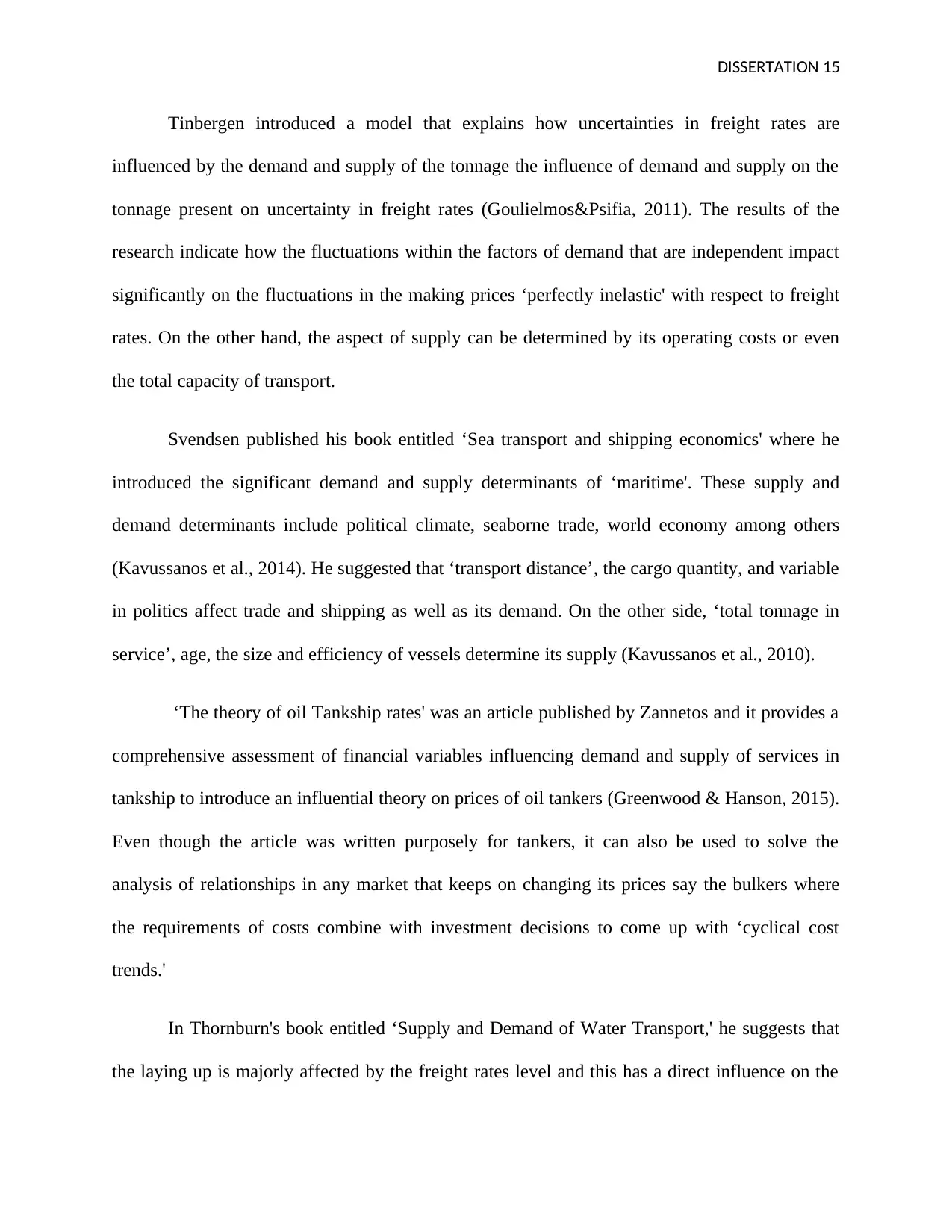
DISSERTATION 15
Tinbergen introduced a model that explains how uncertainties in freight rates are
influenced by the demand and supply of the tonnage the influence of demand and supply on the
tonnage present on uncertainty in freight rates (Goulielmos&Psifia, 2011). The results of the
research indicate how the fluctuations within the factors of demand that are independent impact
significantly on the fluctuations in the making prices ‘perfectly inelastic' with respect to freight
rates. On the other hand, the aspect of supply can be determined by its operating costs or even
the total capacity of transport.
Svendsen published his book entitled ‘Sea transport and shipping economics' where he
introduced the significant demand and supply determinants of ‘maritime'. These supply and
demand determinants include political climate, seaborne trade, world economy among others
(Kavussanos et al., 2014). He suggested that ‘transport distance’, the cargo quantity, and variable
in politics affect trade and shipping as well as its demand. On the other side, ‘total tonnage in
service’, age, the size and efficiency of vessels determine its supply (Kavussanos et al., 2010).
‘The theory of oil Tankship rates' was an article published by Zannetos and it provides a
comprehensive assessment of financial variables influencing demand and supply of services in
tankship to introduce an influential theory on prices of oil tankers (Greenwood & Hanson, 2015).
Even though the article was written purposely for tankers, it can also be used to solve the
analysis of relationships in any market that keeps on changing its prices say the bulkers where
the requirements of costs combine with investment decisions to come up with ‘cyclical cost
trends.'
In Thornburn's book entitled ‘Supply and Demand of Water Transport,' he suggests that
the laying up is majorly affected by the freight rates level and this has a direct influence on the
Tinbergen introduced a model that explains how uncertainties in freight rates are
influenced by the demand and supply of the tonnage the influence of demand and supply on the
tonnage present on uncertainty in freight rates (Goulielmos&Psifia, 2011). The results of the
research indicate how the fluctuations within the factors of demand that are independent impact
significantly on the fluctuations in the making prices ‘perfectly inelastic' with respect to freight
rates. On the other hand, the aspect of supply can be determined by its operating costs or even
the total capacity of transport.
Svendsen published his book entitled ‘Sea transport and shipping economics' where he
introduced the significant demand and supply determinants of ‘maritime'. These supply and
demand determinants include political climate, seaborne trade, world economy among others
(Kavussanos et al., 2014). He suggested that ‘transport distance’, the cargo quantity, and variable
in politics affect trade and shipping as well as its demand. On the other side, ‘total tonnage in
service’, age, the size and efficiency of vessels determine its supply (Kavussanos et al., 2010).
‘The theory of oil Tankship rates' was an article published by Zannetos and it provides a
comprehensive assessment of financial variables influencing demand and supply of services in
tankship to introduce an influential theory on prices of oil tankers (Greenwood & Hanson, 2015).
Even though the article was written purposely for tankers, it can also be used to solve the
analysis of relationships in any market that keeps on changing its prices say the bulkers where
the requirements of costs combine with investment decisions to come up with ‘cyclical cost
trends.'
In Thornburn's book entitled ‘Supply and Demand of Water Transport,' he suggests that
the laying up is majorly affected by the freight rates level and this has a direct influence on the
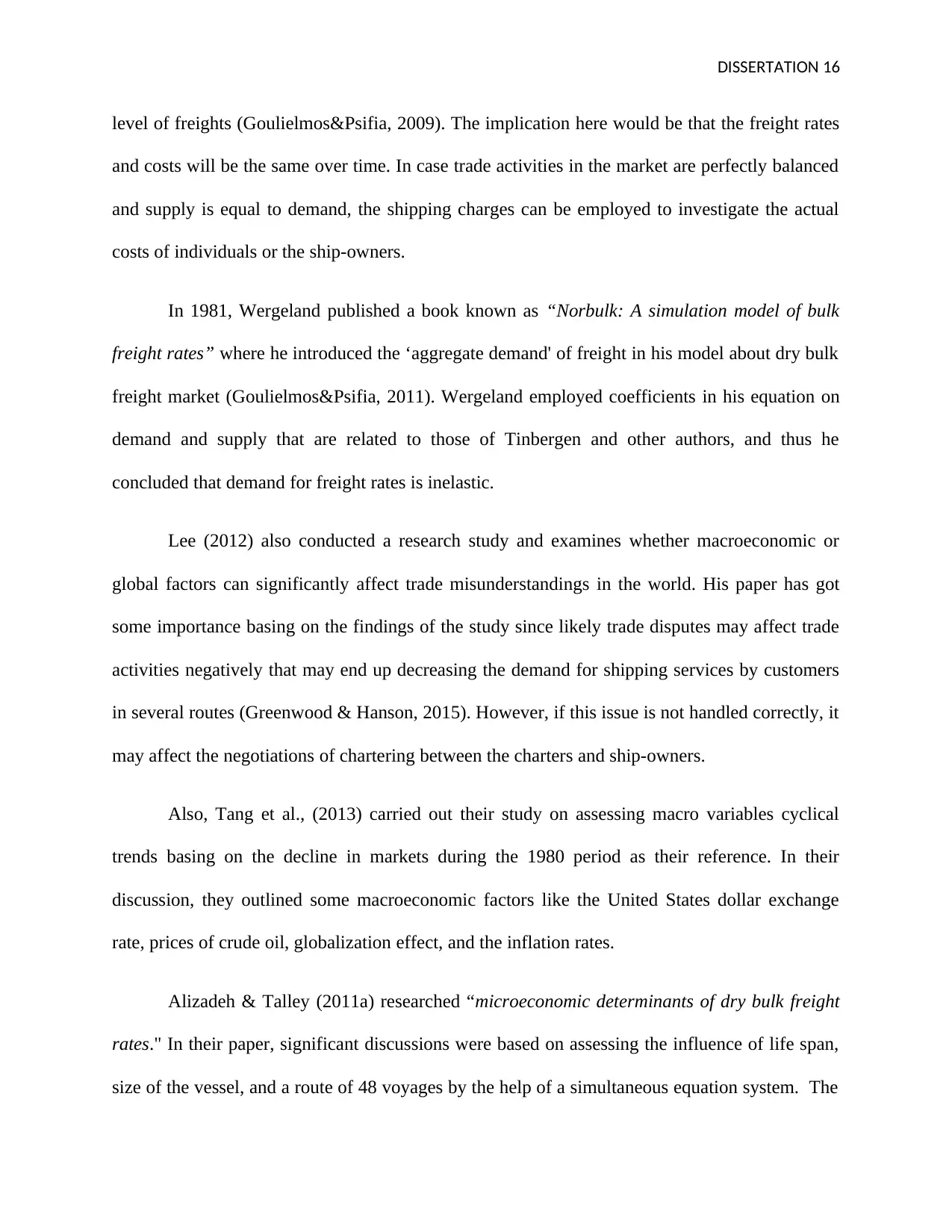
DISSERTATION 16
level of freights (Goulielmos&Psifia, 2009). The implication here would be that the freight rates
and costs will be the same over time. In case trade activities in the market are perfectly balanced
and supply is equal to demand, the shipping charges can be employed to investigate the actual
costs of individuals or the ship-owners.
In 1981, Wergeland published a book known as “Norbulk: A simulation model of bulk
freight rates” where he introduced the ‘aggregate demand' of freight in his model about dry bulk
freight market (Goulielmos&Psifia, 2011). Wergeland employed coefficients in his equation on
demand and supply that are related to those of Tinbergen and other authors, and thus he
concluded that demand for freight rates is inelastic.
Lee (2012) also conducted a research study and examines whether macroeconomic or
global factors can significantly affect trade misunderstandings in the world. His paper has got
some importance basing on the findings of the study since likely trade disputes may affect trade
activities negatively that may end up decreasing the demand for shipping services by customers
in several routes (Greenwood & Hanson, 2015). However, if this issue is not handled correctly, it
may affect the negotiations of chartering between the charters and ship-owners.
Also, Tang et al., (2013) carried out their study on assessing macro variables cyclical
trends basing on the decline in markets during the 1980 period as their reference. In their
discussion, they outlined some macroeconomic factors like the United States dollar exchange
rate, prices of crude oil, globalization effect, and the inflation rates.
Alizadeh & Talley (2011a) researched “microeconomic determinants of dry bulk freight
rates." In their paper, significant discussions were based on assessing the influence of life span,
size of the vessel, and a route of 48 voyages by the help of a simultaneous equation system. The
level of freights (Goulielmos&Psifia, 2009). The implication here would be that the freight rates
and costs will be the same over time. In case trade activities in the market are perfectly balanced
and supply is equal to demand, the shipping charges can be employed to investigate the actual
costs of individuals or the ship-owners.
In 1981, Wergeland published a book known as “Norbulk: A simulation model of bulk
freight rates” where he introduced the ‘aggregate demand' of freight in his model about dry bulk
freight market (Goulielmos&Psifia, 2011). Wergeland employed coefficients in his equation on
demand and supply that are related to those of Tinbergen and other authors, and thus he
concluded that demand for freight rates is inelastic.
Lee (2012) also conducted a research study and examines whether macroeconomic or
global factors can significantly affect trade misunderstandings in the world. His paper has got
some importance basing on the findings of the study since likely trade disputes may affect trade
activities negatively that may end up decreasing the demand for shipping services by customers
in several routes (Greenwood & Hanson, 2015). However, if this issue is not handled correctly, it
may affect the negotiations of chartering between the charters and ship-owners.
Also, Tang et al., (2013) carried out their study on assessing macro variables cyclical
trends basing on the decline in markets during the 1980 period as their reference. In their
discussion, they outlined some macroeconomic factors like the United States dollar exchange
rate, prices of crude oil, globalization effect, and the inflation rates.
Alizadeh & Talley (2011a) researched “microeconomic determinants of dry bulk freight
rates." In their paper, significant discussions were based on assessing the influence of life span,
size of the vessel, and a route of 48 voyages by the help of a simultaneous equation system. The
Secure Best Marks with AI Grader
Need help grading? Try our AI Grader for instant feedback on your assignments.
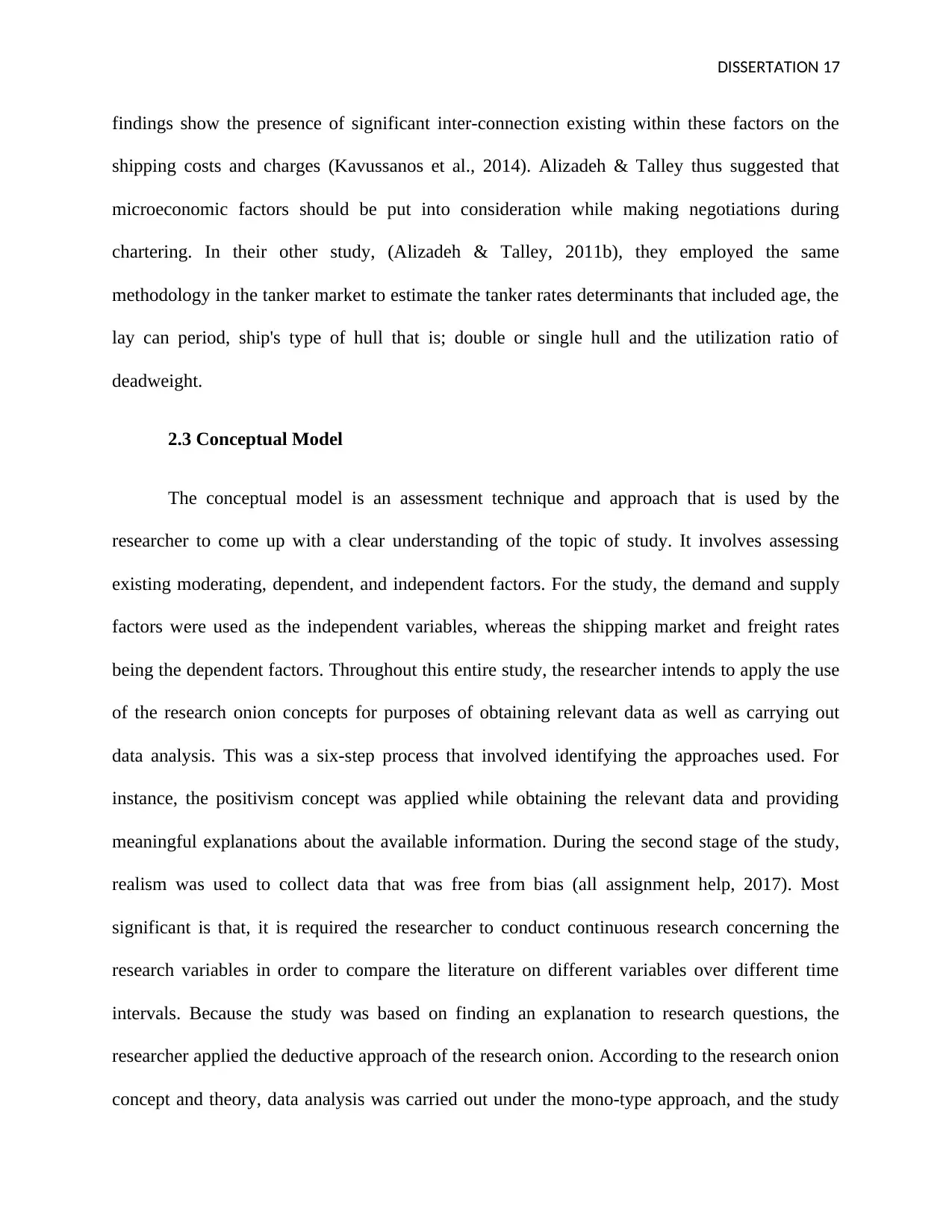
DISSERTATION 17
findings show the presence of significant inter-connection existing within these factors on the
shipping costs and charges (Kavussanos et al., 2014). Alizadeh & Talley thus suggested that
microeconomic factors should be put into consideration while making negotiations during
chartering. In their other study, (Alizadeh & Talley, 2011b), they employed the same
methodology in the tanker market to estimate the tanker rates determinants that included age, the
lay can period, ship's type of hull that is; double or single hull and the utilization ratio of
deadweight.
2.3 Conceptual Model
The conceptual model is an assessment technique and approach that is used by the
researcher to come up with a clear understanding of the topic of study. It involves assessing
existing moderating, dependent, and independent factors. For the study, the demand and supply
factors were used as the independent variables, whereas the shipping market and freight rates
being the dependent factors. Throughout this entire study, the researcher intends to apply the use
of the research onion concepts for purposes of obtaining relevant data as well as carrying out
data analysis. This was a six-step process that involved identifying the approaches used. For
instance, the positivism concept was applied while obtaining the relevant data and providing
meaningful explanations about the available information. During the second stage of the study,
realism was used to collect data that was free from bias (all assignment help, 2017). Most
significant is that, it is required the researcher to conduct continuous research concerning the
research variables in order to compare the literature on different variables over different time
intervals. Because the study was based on finding an explanation to research questions, the
researcher applied the deductive approach of the research onion. According to the research onion
concept and theory, data analysis was carried out under the mono-type approach, and the study
findings show the presence of significant inter-connection existing within these factors on the
shipping costs and charges (Kavussanos et al., 2014). Alizadeh & Talley thus suggested that
microeconomic factors should be put into consideration while making negotiations during
chartering. In their other study, (Alizadeh & Talley, 2011b), they employed the same
methodology in the tanker market to estimate the tanker rates determinants that included age, the
lay can period, ship's type of hull that is; double or single hull and the utilization ratio of
deadweight.
2.3 Conceptual Model
The conceptual model is an assessment technique and approach that is used by the
researcher to come up with a clear understanding of the topic of study. It involves assessing
existing moderating, dependent, and independent factors. For the study, the demand and supply
factors were used as the independent variables, whereas the shipping market and freight rates
being the dependent factors. Throughout this entire study, the researcher intends to apply the use
of the research onion concepts for purposes of obtaining relevant data as well as carrying out
data analysis. This was a six-step process that involved identifying the approaches used. For
instance, the positivism concept was applied while obtaining the relevant data and providing
meaningful explanations about the available information. During the second stage of the study,
realism was used to collect data that was free from bias (all assignment help, 2017). Most
significant is that, it is required the researcher to conduct continuous research concerning the
research variables in order to compare the literature on different variables over different time
intervals. Because the study was based on finding an explanation to research questions, the
researcher applied the deductive approach of the research onion. According to the research onion
concept and theory, data analysis was carried out under the mono-type approach, and the study
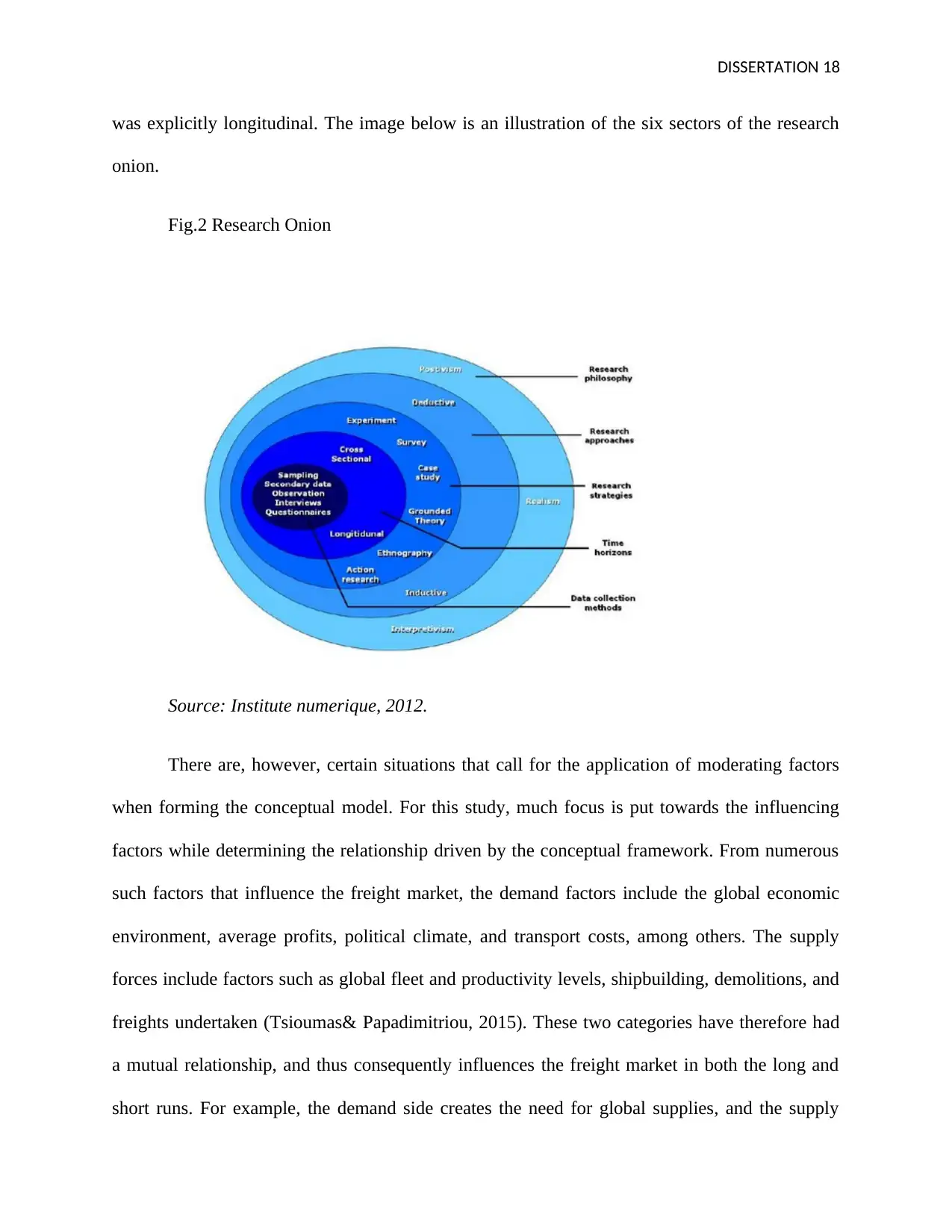
DISSERTATION 18
was explicitly longitudinal. The image below is an illustration of the six sectors of the research
onion.
Fig.2 Research Onion
Source: Institute numerique, 2012.
There are, however, certain situations that call for the application of moderating factors
when forming the conceptual model. For this study, much focus is put towards the influencing
factors while determining the relationship driven by the conceptual framework. From numerous
such factors that influence the freight market, the demand factors include the global economic
environment, average profits, political climate, and transport costs, among others. The supply
forces include factors such as global fleet and productivity levels, shipbuilding, demolitions, and
freights undertaken (Tsioumas& Papadimitriou, 2015). These two categories have therefore had
a mutual relationship, and thus consequently influences the freight market in both the long and
short runs. For example, the demand side creates the need for global supplies, and the supply
was explicitly longitudinal. The image below is an illustration of the six sectors of the research
onion.
Fig.2 Research Onion
Source: Institute numerique, 2012.
There are, however, certain situations that call for the application of moderating factors
when forming the conceptual model. For this study, much focus is put towards the influencing
factors while determining the relationship driven by the conceptual framework. From numerous
such factors that influence the freight market, the demand factors include the global economic
environment, average profits, political climate, and transport costs, among others. The supply
forces include factors such as global fleet and productivity levels, shipbuilding, demolitions, and
freights undertaken (Tsioumas& Papadimitriou, 2015). These two categories have therefore had
a mutual relationship, and thus consequently influences the freight market in both the long and
short runs. For example, the demand side creates the need for global supplies, and the supply
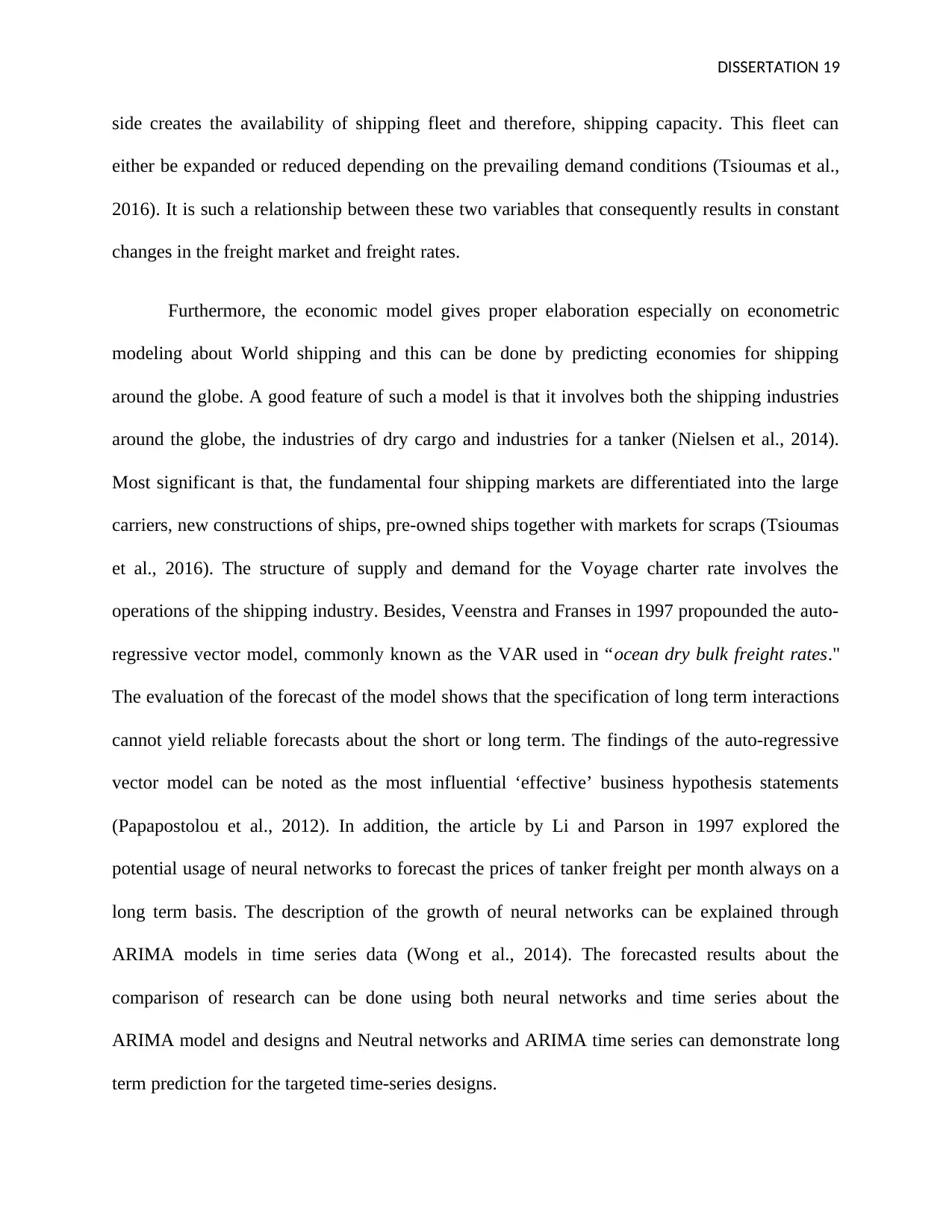
DISSERTATION 19
side creates the availability of shipping fleet and therefore, shipping capacity. This fleet can
either be expanded or reduced depending on the prevailing demand conditions (Tsioumas et al.,
2016). It is such a relationship between these two variables that consequently results in constant
changes in the freight market and freight rates.
Furthermore, the economic model gives proper elaboration especially on econometric
modeling about World shipping and this can be done by predicting economies for shipping
around the globe. A good feature of such a model is that it involves both the shipping industries
around the globe, the industries of dry cargo and industries for a tanker (Nielsen et al., 2014).
Most significant is that, the fundamental four shipping markets are differentiated into the large
carriers, new constructions of ships, pre-owned ships together with markets for scraps (Tsioumas
et al., 2016). The structure of supply and demand for the Voyage charter rate involves the
operations of the shipping industry. Besides, Veenstra and Franses in 1997 propounded the auto-
regressive vector model, commonly known as the VAR used in “ocean dry bulk freight rates."
The evaluation of the forecast of the model shows that the specification of long term interactions
cannot yield reliable forecasts about the short or long term. The findings of the auto-regressive
vector model can be noted as the most influential ‘effective’ business hypothesis statements
(Papapostolou et al., 2012). In addition, the article by Li and Parson in 1997 explored the
potential usage of neural networks to forecast the prices of tanker freight per month always on a
long term basis. The description of the growth of neural networks can be explained through
ARIMA models in time series data (Wong et al., 2014). The forecasted results about the
comparison of research can be done using both neural networks and time series about the
ARIMA model and designs and Neutral networks and ARIMA time series can demonstrate long
term prediction for the targeted time-series designs.
side creates the availability of shipping fleet and therefore, shipping capacity. This fleet can
either be expanded or reduced depending on the prevailing demand conditions (Tsioumas et al.,
2016). It is such a relationship between these two variables that consequently results in constant
changes in the freight market and freight rates.
Furthermore, the economic model gives proper elaboration especially on econometric
modeling about World shipping and this can be done by predicting economies for shipping
around the globe. A good feature of such a model is that it involves both the shipping industries
around the globe, the industries of dry cargo and industries for a tanker (Nielsen et al., 2014).
Most significant is that, the fundamental four shipping markets are differentiated into the large
carriers, new constructions of ships, pre-owned ships together with markets for scraps (Tsioumas
et al., 2016). The structure of supply and demand for the Voyage charter rate involves the
operations of the shipping industry. Besides, Veenstra and Franses in 1997 propounded the auto-
regressive vector model, commonly known as the VAR used in “ocean dry bulk freight rates."
The evaluation of the forecast of the model shows that the specification of long term interactions
cannot yield reliable forecasts about the short or long term. The findings of the auto-regressive
vector model can be noted as the most influential ‘effective’ business hypothesis statements
(Papapostolou et al., 2012). In addition, the article by Li and Parson in 1997 explored the
potential usage of neural networks to forecast the prices of tanker freight per month always on a
long term basis. The description of the growth of neural networks can be explained through
ARIMA models in time series data (Wong et al., 2014). The forecasted results about the
comparison of research can be done using both neural networks and time series about the
ARIMA model and designs and Neutral networks and ARIMA time series can demonstrate long
term prediction for the targeted time-series designs.
Paraphrase This Document
Need a fresh take? Get an instant paraphrase of this document with our AI Paraphraser
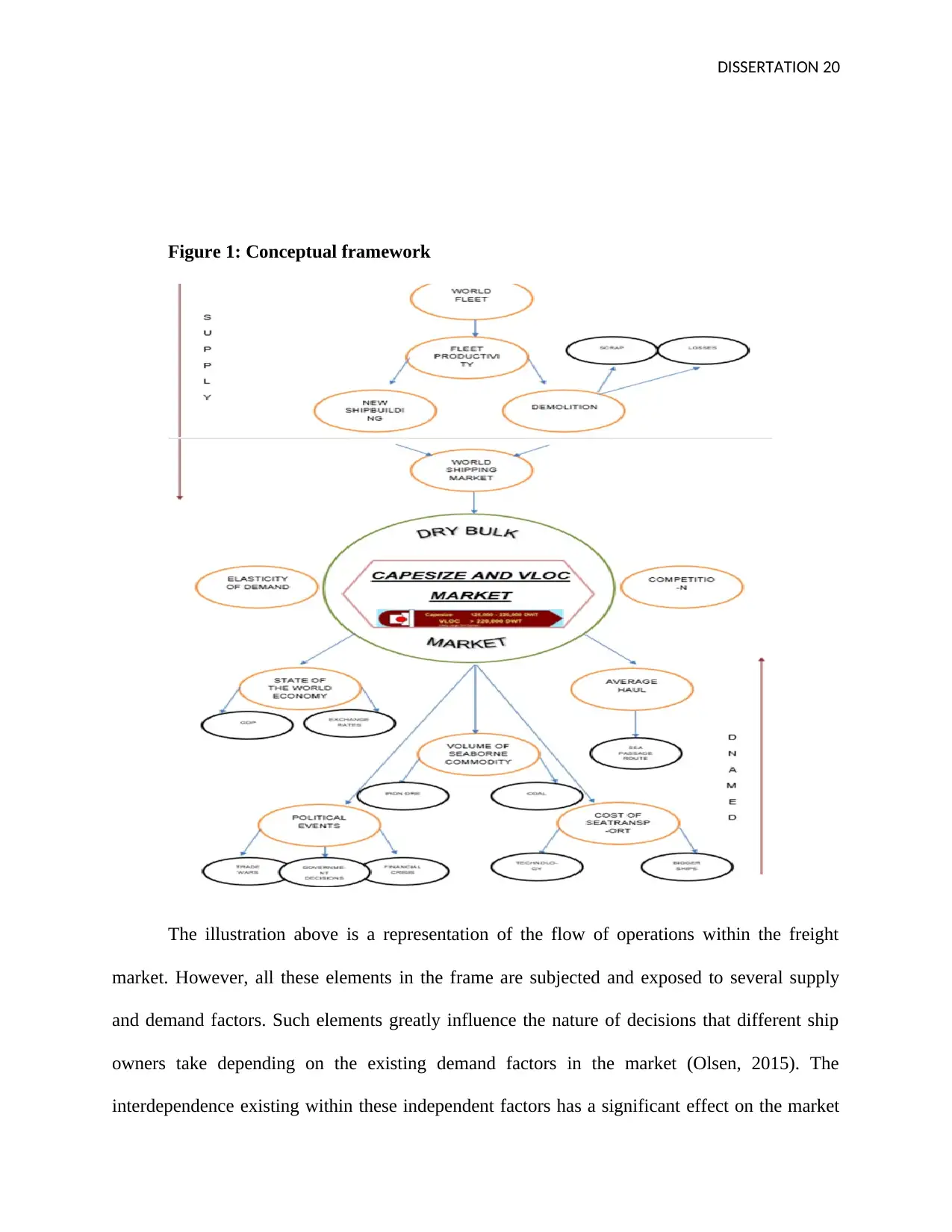
DISSERTATION 20
Figure 1: Conceptual framework
The illustration above is a representation of the flow of operations within the freight
market. However, all these elements in the frame are subjected and exposed to several supply
and demand factors. Such elements greatly influence the nature of decisions that different ship
owners take depending on the existing demand factors in the market (Olsen, 2015). The
interdependence existing within these independent factors has a significant effect on the market
Figure 1: Conceptual framework
The illustration above is a representation of the flow of operations within the freight
market. However, all these elements in the frame are subjected and exposed to several supply
and demand factors. Such elements greatly influence the nature of decisions that different ship
owners take depending on the existing demand factors in the market (Olsen, 2015). The
interdependence existing within these independent factors has a significant effect on the market
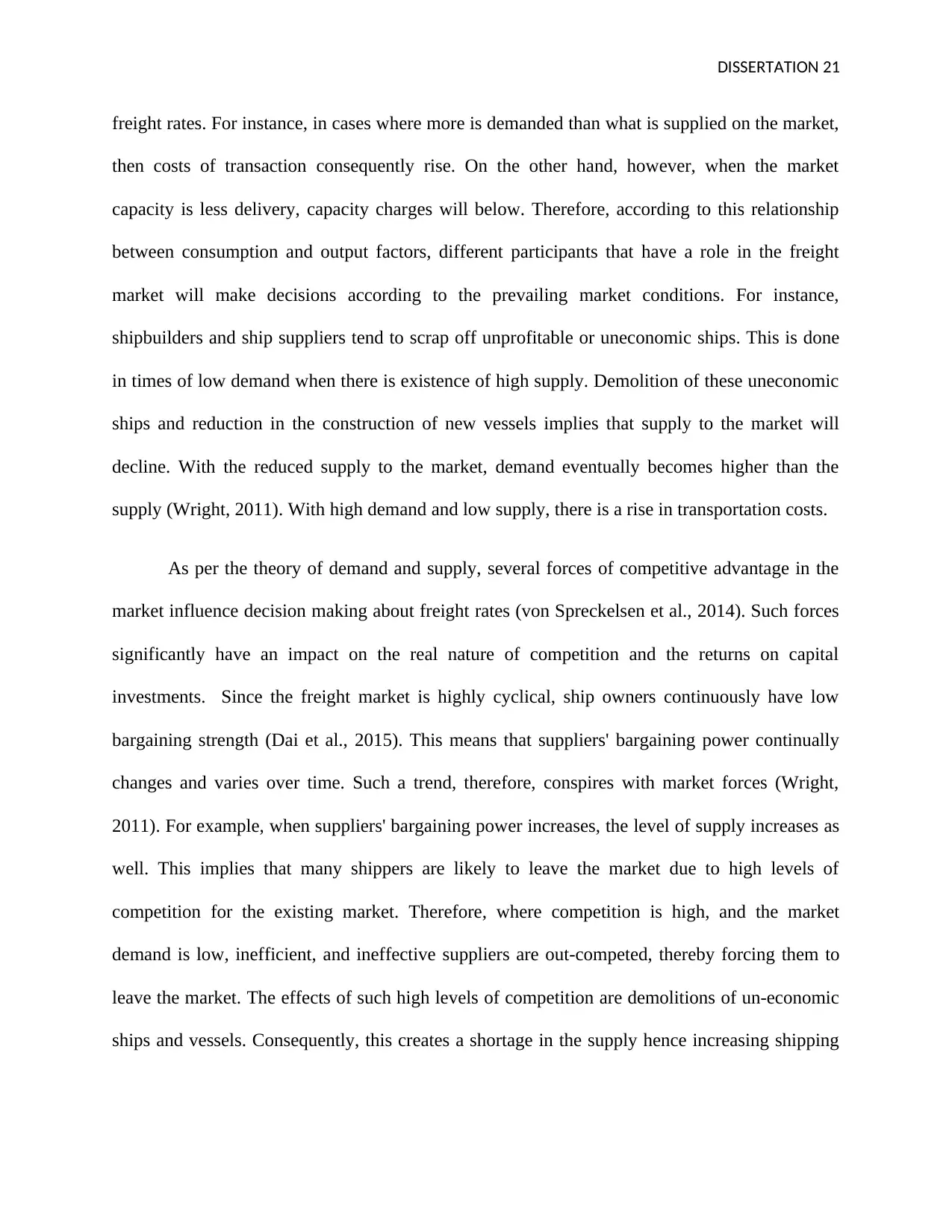
DISSERTATION 21
freight rates. For instance, in cases where more is demanded than what is supplied on the market,
then costs of transaction consequently rise. On the other hand, however, when the market
capacity is less delivery, capacity charges will below. Therefore, according to this relationship
between consumption and output factors, different participants that have a role in the freight
market will make decisions according to the prevailing market conditions. For instance,
shipbuilders and ship suppliers tend to scrap off unprofitable or uneconomic ships. This is done
in times of low demand when there is existence of high supply. Demolition of these uneconomic
ships and reduction in the construction of new vessels implies that supply to the market will
decline. With the reduced supply to the market, demand eventually becomes higher than the
supply (Wright, 2011). With high demand and low supply, there is a rise in transportation costs.
As per the theory of demand and supply, several forces of competitive advantage in the
market influence decision making about freight rates (von Spreckelsen et al., 2014). Such forces
significantly have an impact on the real nature of competition and the returns on capital
investments. Since the freight market is highly cyclical, ship owners continuously have low
bargaining strength (Dai et al., 2015). This means that suppliers' bargaining power continually
changes and varies over time. Such a trend, therefore, conspires with market forces (Wright,
2011). For example, when suppliers' bargaining power increases, the level of supply increases as
well. This implies that many shippers are likely to leave the market due to high levels of
competition for the existing market. Therefore, where competition is high, and the market
demand is low, inefficient, and ineffective suppliers are out-competed, thereby forcing them to
leave the market. The effects of such high levels of competition are demolitions of un-economic
ships and vessels. Consequently, this creates a shortage in the supply hence increasing shipping
freight rates. For instance, in cases where more is demanded than what is supplied on the market,
then costs of transaction consequently rise. On the other hand, however, when the market
capacity is less delivery, capacity charges will below. Therefore, according to this relationship
between consumption and output factors, different participants that have a role in the freight
market will make decisions according to the prevailing market conditions. For instance,
shipbuilders and ship suppliers tend to scrap off unprofitable or uneconomic ships. This is done
in times of low demand when there is existence of high supply. Demolition of these uneconomic
ships and reduction in the construction of new vessels implies that supply to the market will
decline. With the reduced supply to the market, demand eventually becomes higher than the
supply (Wright, 2011). With high demand and low supply, there is a rise in transportation costs.
As per the theory of demand and supply, several forces of competitive advantage in the
market influence decision making about freight rates (von Spreckelsen et al., 2014). Such forces
significantly have an impact on the real nature of competition and the returns on capital
investments. Since the freight market is highly cyclical, ship owners continuously have low
bargaining strength (Dai et al., 2015). This means that suppliers' bargaining power continually
changes and varies over time. Such a trend, therefore, conspires with market forces (Wright,
2011). For example, when suppliers' bargaining power increases, the level of supply increases as
well. This implies that many shippers are likely to leave the market due to high levels of
competition for the existing market. Therefore, where competition is high, and the market
demand is low, inefficient, and ineffective suppliers are out-competed, thereby forcing them to
leave the market. The effects of such high levels of competition are demolitions of un-economic
ships and vessels. Consequently, this creates a shortage in the supply hence increasing shipping
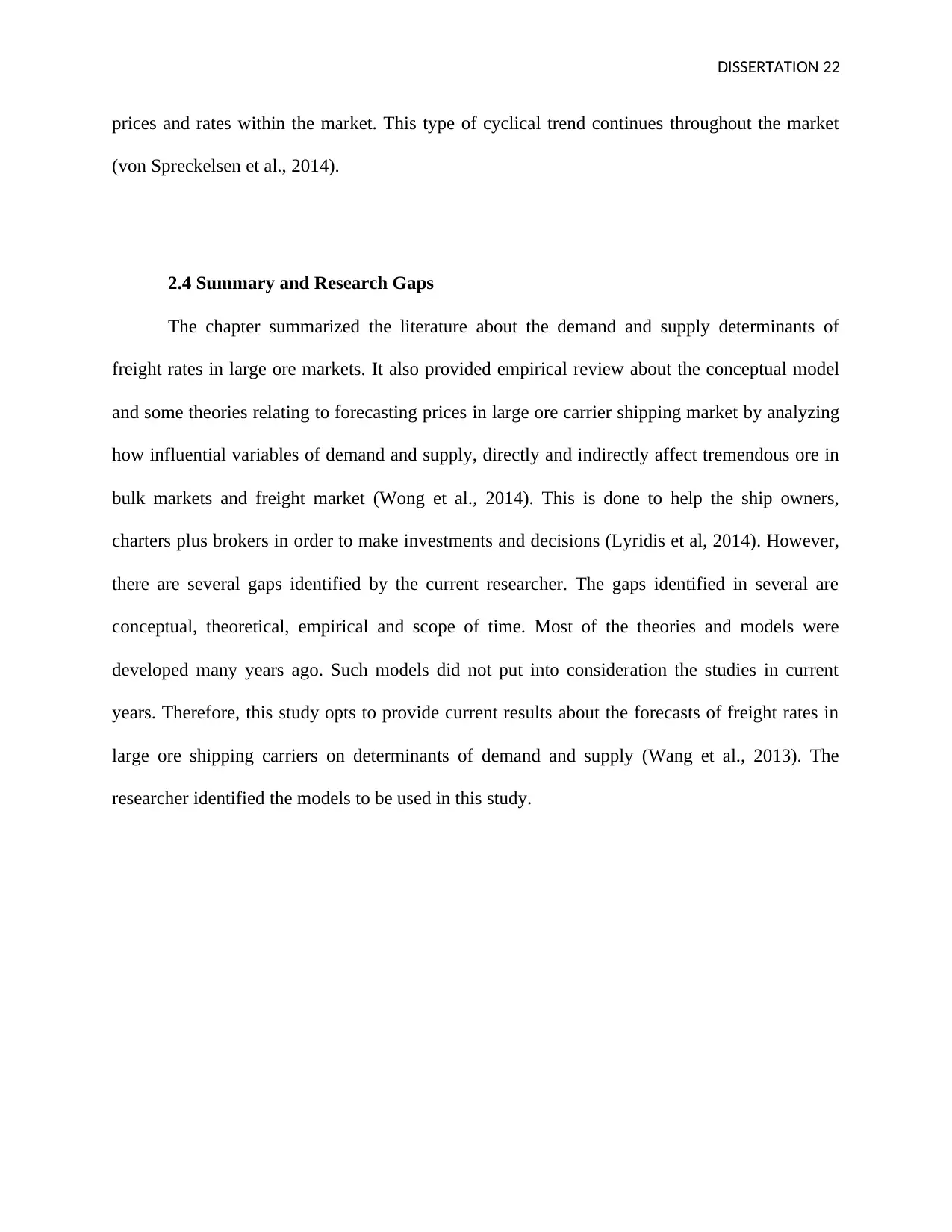
DISSERTATION 22
prices and rates within the market. This type of cyclical trend continues throughout the market
(von Spreckelsen et al., 2014).
2.4 Summary and Research Gaps
The chapter summarized the literature about the demand and supply determinants of
freight rates in large ore markets. It also provided empirical review about the conceptual model
and some theories relating to forecasting prices in large ore carrier shipping market by analyzing
how influential variables of demand and supply, directly and indirectly affect tremendous ore in
bulk markets and freight market (Wong et al., 2014). This is done to help the ship owners,
charters plus brokers in order to make investments and decisions (Lyridis et al, 2014). However,
there are several gaps identified by the current researcher. The gaps identified in several are
conceptual, theoretical, empirical and scope of time. Most of the theories and models were
developed many years ago. Such models did not put into consideration the studies in current
years. Therefore, this study opts to provide current results about the forecasts of freight rates in
large ore shipping carriers on determinants of demand and supply (Wang et al., 2013). The
researcher identified the models to be used in this study.
prices and rates within the market. This type of cyclical trend continues throughout the market
(von Spreckelsen et al., 2014).
2.4 Summary and Research Gaps
The chapter summarized the literature about the demand and supply determinants of
freight rates in large ore markets. It also provided empirical review about the conceptual model
and some theories relating to forecasting prices in large ore carrier shipping market by analyzing
how influential variables of demand and supply, directly and indirectly affect tremendous ore in
bulk markets and freight market (Wong et al., 2014). This is done to help the ship owners,
charters plus brokers in order to make investments and decisions (Lyridis et al, 2014). However,
there are several gaps identified by the current researcher. The gaps identified in several are
conceptual, theoretical, empirical and scope of time. Most of the theories and models were
developed many years ago. Such models did not put into consideration the studies in current
years. Therefore, this study opts to provide current results about the forecasts of freight rates in
large ore shipping carriers on determinants of demand and supply (Wang et al., 2013). The
researcher identified the models to be used in this study.
Secure Best Marks with AI Grader
Need help grading? Try our AI Grader for instant feedback on your assignments.

DISSERTATION 23
Chapter Three: Methodology
3.0 Introduction
In this study, the chapter presents the ‘research design,' model specification, data, and
data issues. The chapter expounds on the various econometric tests and statistical tests such as
normality tests (P-P plots and Shapiro Wilkson's tests), Stationarity tests (Augmented Dickey-
Fuller test), and Linearity tests. The linearity test includes multiple regression analyses and
Durbin Watson's test about the variables in the study.
3.1Research Design
The study used a correlation research design which involves ‘quantitative' research and
qualitative research. However, according to this study, a quantitative approach was used. The
approach involves selecting data from the specified sources in order to run data analysis in
accordance with the research questions. With data that is quantitative in nature, analysis is done
through presenting graphical, tabular, and statistical diagrams or a summary of results' tools.
This study is considered to be positivist research since it aims at discovering and explaining the
trends and directions of variables in the study. In addition, quantitative data can be used to test
the relevance of the theories and literature review in relation to the objectives of the study.
3.2 Sources of Data
The data about freight rates and the determinants of demand and supply of large iron ore carrier
shipping markets are attained from secondary sources. The data used in the analysis were
retrieved from sources like Bloomberg and World Bank terminals (Batrinca&Cojanu, 2014). In
order to get the data about the prices of the global trade of ore, Science and Innovation
Chapter Three: Methodology
3.0 Introduction
In this study, the chapter presents the ‘research design,' model specification, data, and
data issues. The chapter expounds on the various econometric tests and statistical tests such as
normality tests (P-P plots and Shapiro Wilkson's tests), Stationarity tests (Augmented Dickey-
Fuller test), and Linearity tests. The linearity test includes multiple regression analyses and
Durbin Watson's test about the variables in the study.
3.1Research Design
The study used a correlation research design which involves ‘quantitative' research and
qualitative research. However, according to this study, a quantitative approach was used. The
approach involves selecting data from the specified sources in order to run data analysis in
accordance with the research questions. With data that is quantitative in nature, analysis is done
through presenting graphical, tabular, and statistical diagrams or a summary of results' tools.
This study is considered to be positivist research since it aims at discovering and explaining the
trends and directions of variables in the study. In addition, quantitative data can be used to test
the relevance of the theories and literature review in relation to the objectives of the study.
3.2 Sources of Data
The data about freight rates and the determinants of demand and supply of large iron ore carrier
shipping markets are attained from secondary sources. The data used in the analysis were
retrieved from sources like Bloomberg and World Bank terminals (Batrinca&Cojanu, 2014). In
order to get the data about the prices of the global trade of ore, Science and Innovation
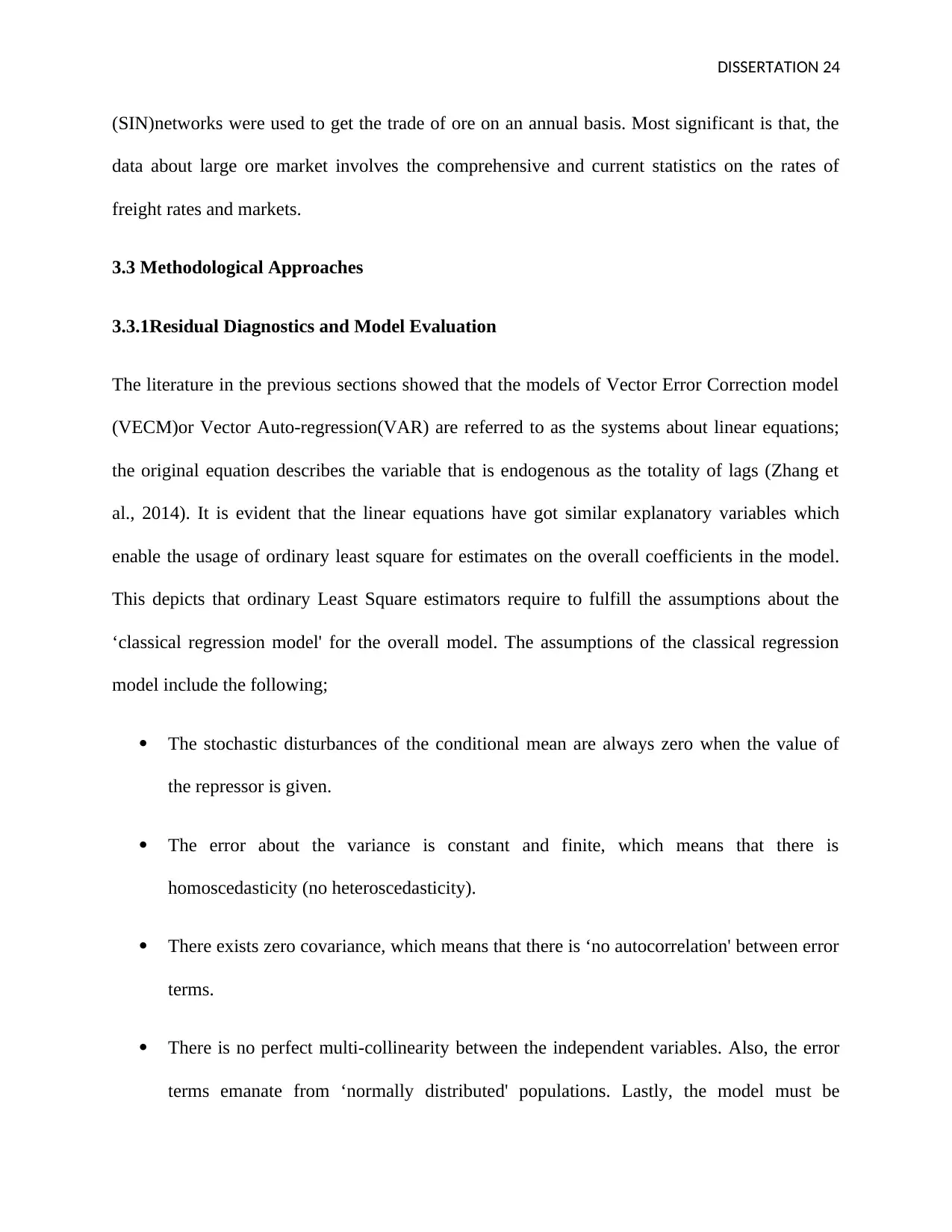
DISSERTATION 24
(SIN)networks were used to get the trade of ore on an annual basis. Most significant is that, the
data about large ore market involves the comprehensive and current statistics on the rates of
freight rates and markets.
3.3 Methodological Approaches
3.3.1Residual Diagnostics and Model Evaluation
The literature in the previous sections showed that the models of Vector Error Correction model
(VECM)or Vector Auto-regression(VAR) are referred to as the systems about linear equations;
the original equation describes the variable that is endogenous as the totality of lags (Zhang et
al., 2014). It is evident that the linear equations have got similar explanatory variables which
enable the usage of ordinary least square for estimates on the overall coefficients in the model.
This depicts that ordinary Least Square estimators require to fulfill the assumptions about the
‘classical regression model' for the overall model. The assumptions of the classical regression
model include the following;
The stochastic disturbances of the conditional mean are always zero when the value of
the repressor is given.
The error about the variance is constant and finite, which means that there is
homoscedasticity (no heteroscedasticity).
There exists zero covariance, which means that there is ‘no autocorrelation' between error
terms.
There is no perfect multi-collinearity between the independent variables. Also, the error
terms emanate from ‘normally distributed' populations. Lastly, the model must be
(SIN)networks were used to get the trade of ore on an annual basis. Most significant is that, the
data about large ore market involves the comprehensive and current statistics on the rates of
freight rates and markets.
3.3 Methodological Approaches
3.3.1Residual Diagnostics and Model Evaluation
The literature in the previous sections showed that the models of Vector Error Correction model
(VECM)or Vector Auto-regression(VAR) are referred to as the systems about linear equations;
the original equation describes the variable that is endogenous as the totality of lags (Zhang et
al., 2014). It is evident that the linear equations have got similar explanatory variables which
enable the usage of ordinary least square for estimates on the overall coefficients in the model.
This depicts that ordinary Least Square estimators require to fulfill the assumptions about the
‘classical regression model' for the overall model. The assumptions of the classical regression
model include the following;
The stochastic disturbances of the conditional mean are always zero when the value of
the repressor is given.
The error about the variance is constant and finite, which means that there is
homoscedasticity (no heteroscedasticity).
There exists zero covariance, which means that there is ‘no autocorrelation' between error
terms.
There is no perfect multi-collinearity between the independent variables. Also, the error
terms emanate from ‘normally distributed' populations. Lastly, the model must be

DISSERTATION 25
correctly specified in order to produce reliable results. This, therefore, provides the
choice of variables that are a correct and reliable model in order to avoid errors (Zhang et
al., 2014).
3.2.2 Correlation analysis
Analysis of correlation acts as a ‘statistical tool’ that explains the relationship between the
variables say (x and y) that are used as data. To get the correlation coefficient, we get the
covariance and divide it by the standard deviation of the variables. Covariance in this case refers
to the situation when the variables in the study ae ‘linearly correlated’. The correlation
coefficient is given as -1 ≤ r ≤ 1: where r = the ‘correlation coefficient’ lies in between -1 and 1.
After solving for r and the correlation coefficient is negative one (-1), then we understand that
the linear relationship for the two variables is a negative. However, in case the correlation
coefficient is equal to positive one (+1) then the relationship between the variable is perfect
positive (Batrinca&Cojanu, 2014). On the other hand, in case the correlation coefficient is zero
(0) it shows the linear relationship there does not exist. It is realized that, after interpreting the
correlation coefficient, we can be able to identify the degree of linear relationship that is found
between the two variables (Papapostolou, et al, 2014). However, in situations where the
correlation coefficient number is not 1, 0 or -1, then it can be interpreted as the relationship by
telling the degree for which the two variables are related and nothing else (Ozer & Cetin, 2012).
Furthermore, the correlation coefficient analysis is criticized by not providing the idea about the
rise of the relationship since correlation between two variables does not indicate whether the
variables have or they do not have a cause relationship (Papapostolou, et al, 2014). It is only the
experimental method that helps us to identify whether correlation is the same as a cause-effect
relationship between variables.
correctly specified in order to produce reliable results. This, therefore, provides the
choice of variables that are a correct and reliable model in order to avoid errors (Zhang et
al., 2014).
3.2.2 Correlation analysis
Analysis of correlation acts as a ‘statistical tool’ that explains the relationship between the
variables say (x and y) that are used as data. To get the correlation coefficient, we get the
covariance and divide it by the standard deviation of the variables. Covariance in this case refers
to the situation when the variables in the study ae ‘linearly correlated’. The correlation
coefficient is given as -1 ≤ r ≤ 1: where r = the ‘correlation coefficient’ lies in between -1 and 1.
After solving for r and the correlation coefficient is negative one (-1), then we understand that
the linear relationship for the two variables is a negative. However, in case the correlation
coefficient is equal to positive one (+1) then the relationship between the variable is perfect
positive (Batrinca&Cojanu, 2014). On the other hand, in case the correlation coefficient is zero
(0) it shows the linear relationship there does not exist. It is realized that, after interpreting the
correlation coefficient, we can be able to identify the degree of linear relationship that is found
between the two variables (Papapostolou, et al, 2014). However, in situations where the
correlation coefficient number is not 1, 0 or -1, then it can be interpreted as the relationship by
telling the degree for which the two variables are related and nothing else (Ozer & Cetin, 2012).
Furthermore, the correlation coefficient analysis is criticized by not providing the idea about the
rise of the relationship since correlation between two variables does not indicate whether the
variables have or they do not have a cause relationship (Papapostolou, et al, 2014). It is only the
experimental method that helps us to identify whether correlation is the same as a cause-effect
relationship between variables.
Paraphrase This Document
Need a fresh take? Get an instant paraphrase of this document with our AI Paraphraser
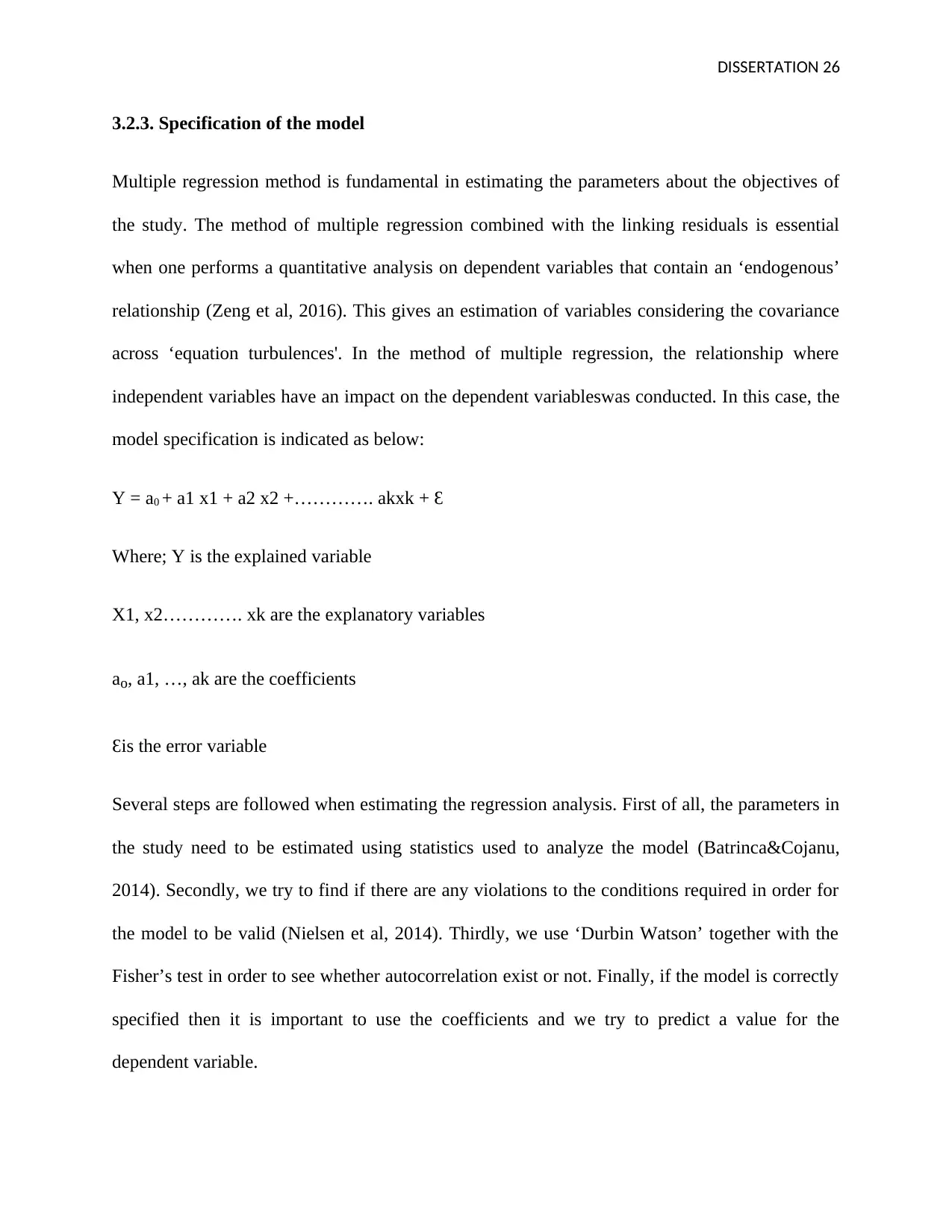
DISSERTATION 26
3.2.3. Specification of the model
Multiple regression method is fundamental in estimating the parameters about the objectives of
the study. The method of multiple regression combined with the linking residuals is essential
when one performs a quantitative analysis on dependent variables that contain an ‘endogenous’
relationship (Zeng et al, 2016). This gives an estimation of variables considering the covariance
across ‘equation turbulences'. In the method of multiple regression, the relationship where
independent variables have an impact on the dependent variableswas conducted. In this case, the
model specification is indicated as below:
Y = a0 + a1 x1 + a2 x2 +…………. akxk + Ɛ
Where; Y is the explained variable
X1, x2…………. xk are the explanatory variables
ao, a1, …, ak are the coefficients
Ɛis the error variable
Several steps are followed when estimating the regression analysis. First of all, the parameters in
the study need to be estimated using statistics used to analyze the model (Batrinca&Cojanu,
2014). Secondly, we try to find if there are any violations to the conditions required in order for
the model to be valid (Nielsen et al, 2014). Thirdly, we use ‘Durbin Watson’ together with the
Fisher’s test in order to see whether autocorrelation exist or not. Finally, if the model is correctly
specified then it is important to use the coefficients and we try to predict a value for the
dependent variable.
3.2.3. Specification of the model
Multiple regression method is fundamental in estimating the parameters about the objectives of
the study. The method of multiple regression combined with the linking residuals is essential
when one performs a quantitative analysis on dependent variables that contain an ‘endogenous’
relationship (Zeng et al, 2016). This gives an estimation of variables considering the covariance
across ‘equation turbulences'. In the method of multiple regression, the relationship where
independent variables have an impact on the dependent variableswas conducted. In this case, the
model specification is indicated as below:
Y = a0 + a1 x1 + a2 x2 +…………. akxk + Ɛ
Where; Y is the explained variable
X1, x2…………. xk are the explanatory variables
ao, a1, …, ak are the coefficients
Ɛis the error variable
Several steps are followed when estimating the regression analysis. First of all, the parameters in
the study need to be estimated using statistics used to analyze the model (Batrinca&Cojanu,
2014). Secondly, we try to find if there are any violations to the conditions required in order for
the model to be valid (Nielsen et al, 2014). Thirdly, we use ‘Durbin Watson’ together with the
Fisher’s test in order to see whether autocorrelation exist or not. Finally, if the model is correctly
specified then it is important to use the coefficients and we try to predict a value for the
dependent variable.
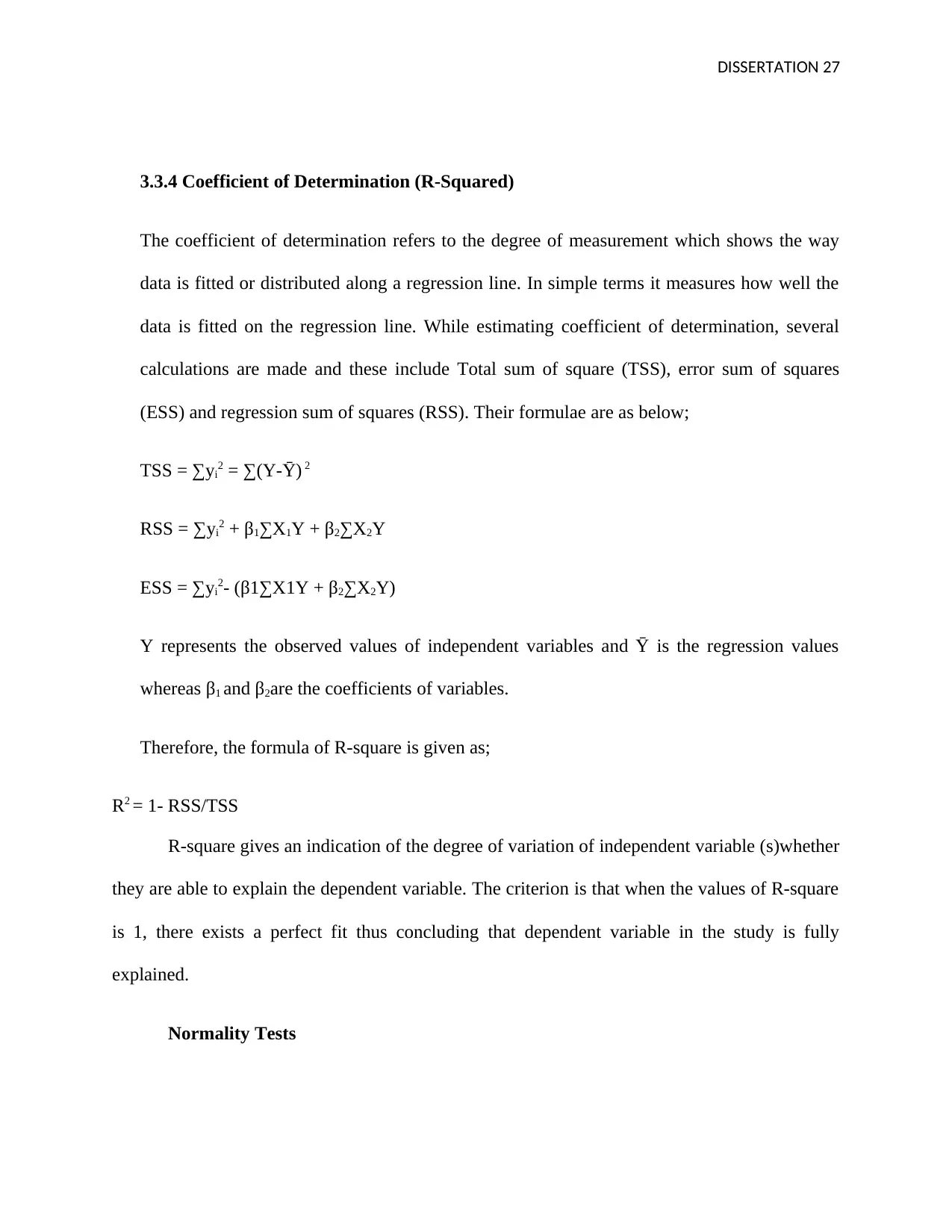
DISSERTATION 27
3.3.4 Coefficient of Determination (R-Squared)
The coefficient of determination refers to the degree of measurement which shows the way
data is fitted or distributed along a regression line. In simple terms it measures how well the
data is fitted on the regression line. While estimating coefficient of determination, several
calculations are made and these include Total sum of square (TSS), error sum of squares
(ESS) and regression sum of squares (RSS). Their formulae are as below;
TSS = ∑yi2 = ∑(Y-Ῡ) 2
RSS = ∑yi2 + β1∑X1Y + β2∑X2Y
ESS = ∑yi2- (β1∑X1Y + β2∑X2Y)
Y represents the observed values of independent variables and Ῡ is the regression values
whereas β1 and β2are the coefficients of variables.
Therefore, the formula of R-square is given as;
R2 = 1- RSS/TSS
R-square gives an indication of the degree of variation of independent variable (s)whether
they are able to explain the dependent variable. The criterion is that when the values of R-square
is 1, there exists a perfect fit thus concluding that dependent variable in the study is fully
explained.
Normality Tests
3.3.4 Coefficient of Determination (R-Squared)
The coefficient of determination refers to the degree of measurement which shows the way
data is fitted or distributed along a regression line. In simple terms it measures how well the
data is fitted on the regression line. While estimating coefficient of determination, several
calculations are made and these include Total sum of square (TSS), error sum of squares
(ESS) and regression sum of squares (RSS). Their formulae are as below;
TSS = ∑yi2 = ∑(Y-Ῡ) 2
RSS = ∑yi2 + β1∑X1Y + β2∑X2Y
ESS = ∑yi2- (β1∑X1Y + β2∑X2Y)
Y represents the observed values of independent variables and Ῡ is the regression values
whereas β1 and β2are the coefficients of variables.
Therefore, the formula of R-square is given as;
R2 = 1- RSS/TSS
R-square gives an indication of the degree of variation of independent variable (s)whether
they are able to explain the dependent variable. The criterion is that when the values of R-square
is 1, there exists a perfect fit thus concluding that dependent variable in the study is fully
explained.
Normality Tests
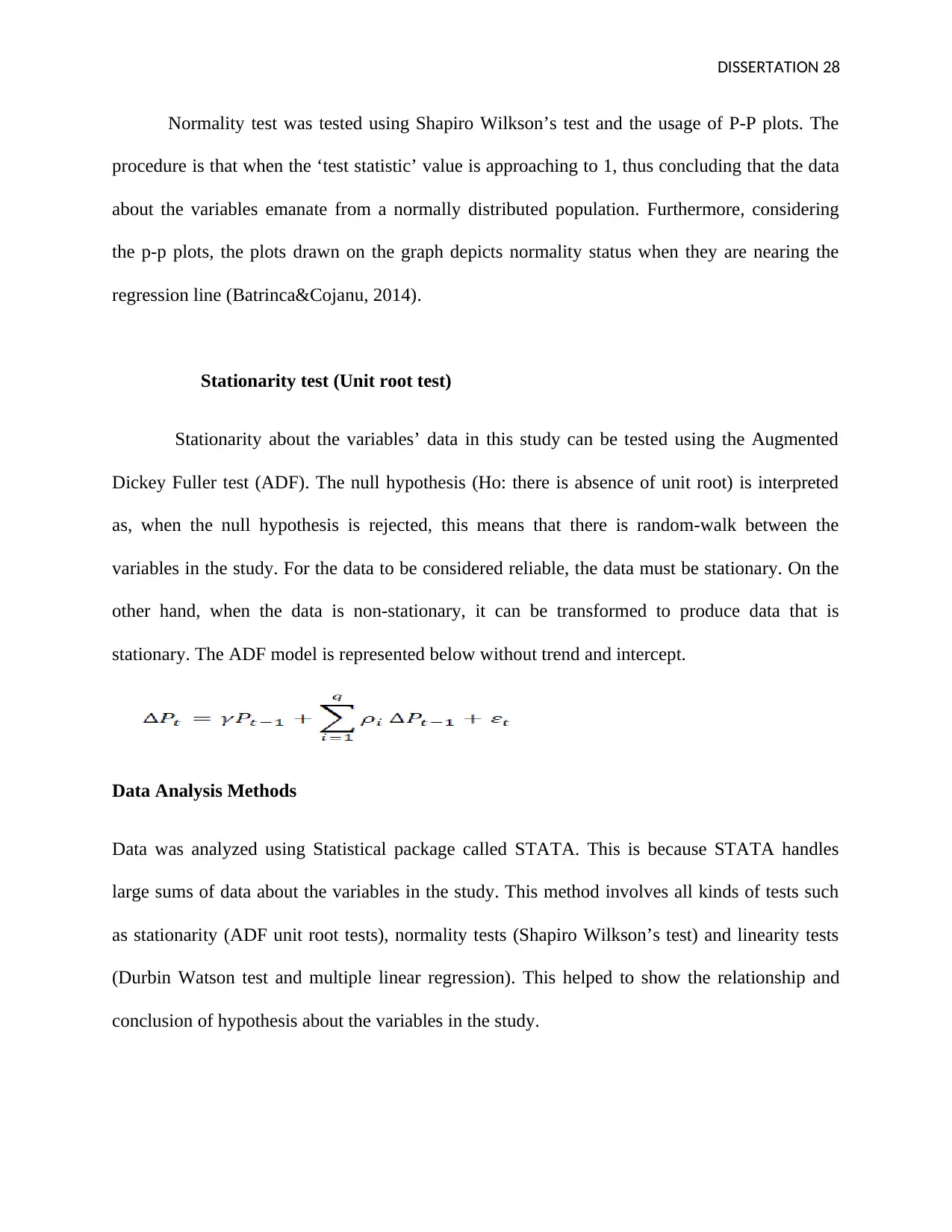
DISSERTATION 28
Normality test was tested using Shapiro Wilkson’s test and the usage of P-P plots. The
procedure is that when the ‘test statistic’ value is approaching to 1, thus concluding that the data
about the variables emanate from a normally distributed population. Furthermore, considering
the p-p plots, the plots drawn on the graph depicts normality status when they are nearing the
regression line (Batrinca&Cojanu, 2014).
Stationarity test (Unit root test)
Stationarity about the variables’ data in this study can be tested using the Augmented
Dickey Fuller test (ADF). The null hypothesis (Ho: there is absence of unit root) is interpreted
as, when the null hypothesis is rejected, this means that there is random-walk between the
variables in the study. For the data to be considered reliable, the data must be stationary. On the
other hand, when the data is non-stationary, it can be transformed to produce data that is
stationary. The ADF model is represented below without trend and intercept.
Data Analysis Methods
Data was analyzed using Statistical package called STATA. This is because STATA handles
large sums of data about the variables in the study. This method involves all kinds of tests such
as stationarity (ADF unit root tests), normality tests (Shapiro Wilkson’s test) and linearity tests
(Durbin Watson test and multiple linear regression). This helped to show the relationship and
conclusion of hypothesis about the variables in the study.
Normality test was tested using Shapiro Wilkson’s test and the usage of P-P plots. The
procedure is that when the ‘test statistic’ value is approaching to 1, thus concluding that the data
about the variables emanate from a normally distributed population. Furthermore, considering
the p-p plots, the plots drawn on the graph depicts normality status when they are nearing the
regression line (Batrinca&Cojanu, 2014).
Stationarity test (Unit root test)
Stationarity about the variables’ data in this study can be tested using the Augmented
Dickey Fuller test (ADF). The null hypothesis (Ho: there is absence of unit root) is interpreted
as, when the null hypothesis is rejected, this means that there is random-walk between the
variables in the study. For the data to be considered reliable, the data must be stationary. On the
other hand, when the data is non-stationary, it can be transformed to produce data that is
stationary. The ADF model is represented below without trend and intercept.
Data Analysis Methods
Data was analyzed using Statistical package called STATA. This is because STATA handles
large sums of data about the variables in the study. This method involves all kinds of tests such
as stationarity (ADF unit root tests), normality tests (Shapiro Wilkson’s test) and linearity tests
(Durbin Watson test and multiple linear regression). This helped to show the relationship and
conclusion of hypothesis about the variables in the study.
Secure Best Marks with AI Grader
Need help grading? Try our AI Grader for instant feedback on your assignments.
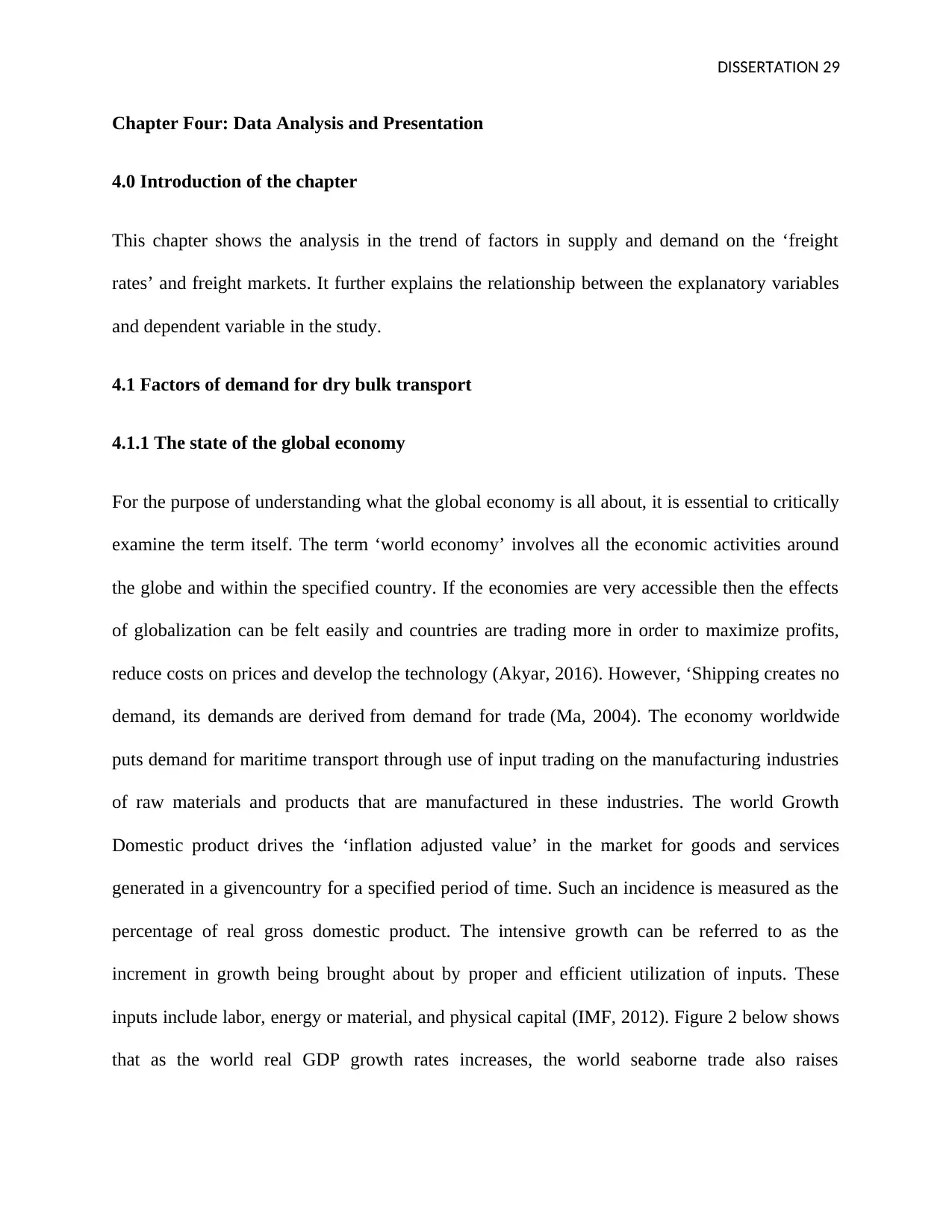
DISSERTATION 29
Chapter Four: Data Analysis and Presentation
4.0 Introduction of the chapter
This chapter shows the analysis in the trend of factors in supply and demand on the ‘freight
rates’ and freight markets. It further explains the relationship between the explanatory variables
and dependent variable in the study.
4.1 Factors of demand for dry bulk transport
4.1.1 The state of the global economy
For the purpose of understanding what the global economy is all about, it is essential to critically
examine the term itself. The term ‘world economy’ involves all the economic activities around
the globe and within the specified country. If the economies are very accessible then the effects
of globalization can be felt easily and countries are trading more in order to maximize profits,
reduce costs on prices and develop the technology (Akyar, 2016). However, ‘Shipping creates no
demand, its demands are derived from demand for trade (Ma, 2004). The economy worldwide
puts demand for maritime transport through use of input trading on the manufacturing industries
of raw materials and products that are manufactured in these industries. The world Growth
Domestic product drives the ‘inflation adjusted value’ in the market for goods and services
generated in a givencountry for a specified period of time. Such an incidence is measured as the
percentage of real gross domestic product. The intensive growth can be referred to as the
increment in growth being brought about by proper and efficient utilization of inputs. These
inputs include labor, energy or material, and physical capital (IMF, 2012). Figure 2 below shows
that as the world real GDP growth rates increases, the world seaborne trade also raises
Chapter Four: Data Analysis and Presentation
4.0 Introduction of the chapter
This chapter shows the analysis in the trend of factors in supply and demand on the ‘freight
rates’ and freight markets. It further explains the relationship between the explanatory variables
and dependent variable in the study.
4.1 Factors of demand for dry bulk transport
4.1.1 The state of the global economy
For the purpose of understanding what the global economy is all about, it is essential to critically
examine the term itself. The term ‘world economy’ involves all the economic activities around
the globe and within the specified country. If the economies are very accessible then the effects
of globalization can be felt easily and countries are trading more in order to maximize profits,
reduce costs on prices and develop the technology (Akyar, 2016). However, ‘Shipping creates no
demand, its demands are derived from demand for trade (Ma, 2004). The economy worldwide
puts demand for maritime transport through use of input trading on the manufacturing industries
of raw materials and products that are manufactured in these industries. The world Growth
Domestic product drives the ‘inflation adjusted value’ in the market for goods and services
generated in a givencountry for a specified period of time. Such an incidence is measured as the
percentage of real gross domestic product. The intensive growth can be referred to as the
increment in growth being brought about by proper and efficient utilization of inputs. These
inputs include labor, energy or material, and physical capital (IMF, 2012). Figure 2 below shows
that as the world real GDP growth rates increases, the world seaborne trade also raises
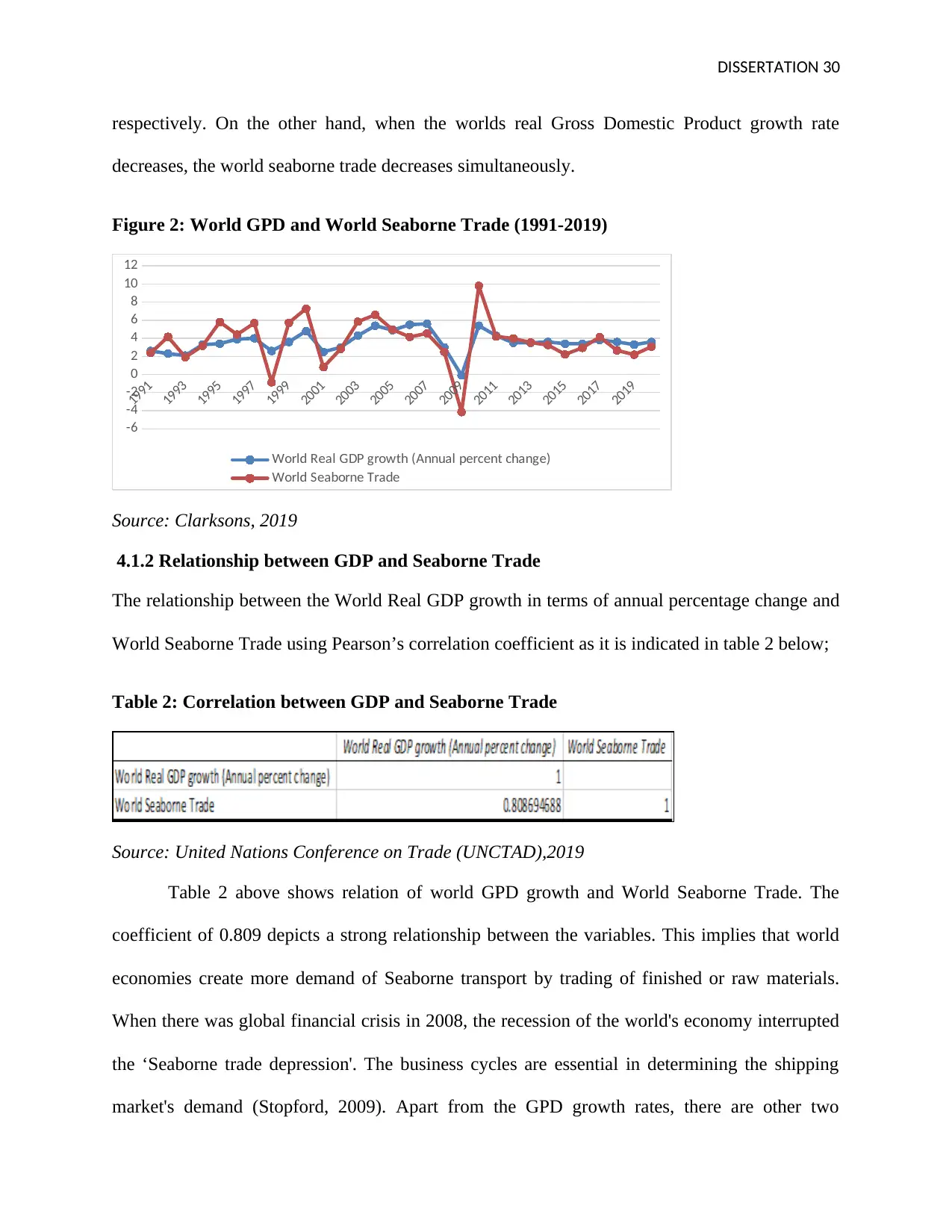
DISSERTATION 30
respectively. On the other hand, when the worlds real Gross Domestic Product growth rate
decreases, the world seaborne trade decreases simultaneously.
Figure 2: World GPD and World Seaborne Trade (1991-2019)
1991
1993
1995
1997
1999
2001
2003
2005
2007
2009
2011
2013
2015
2017
2019
-6
-4
-2
0
2
4
6
8
10
12
World Real GDP growth (Annual percent change)
World Seaborne Trade
Source: Clarksons, 2019
4.1.2 Relationship between GDP and Seaborne Trade
The relationship between the World Real GDP growth in terms of annual percentage change and
World Seaborne Trade using Pearson’s correlation coefficient as it is indicated in table 2 below;
Table 2: Correlation between GDP and Seaborne Trade
Source: United Nations Conference on Trade (UNCTAD),2019
Table 2 above shows relation of world GPD growth and World Seaborne Trade. The
coefficient of 0.809 depicts a strong relationship between the variables. This implies that world
economies create more demand of Seaborne transport by trading of finished or raw materials.
When there was global financial crisis in 2008, the recession of the world's economy interrupted
the ‘Seaborne trade depression'. The business cycles are essential in determining the shipping
market's demand (Stopford, 2009). Apart from the GPD growth rates, there are other two
respectively. On the other hand, when the worlds real Gross Domestic Product growth rate
decreases, the world seaborne trade decreases simultaneously.
Figure 2: World GPD and World Seaborne Trade (1991-2019)
1991
1993
1995
1997
1999
2001
2003
2005
2007
2009
2011
2013
2015
2017
2019
-6
-4
-2
0
2
4
6
8
10
12
World Real GDP growth (Annual percent change)
World Seaborne Trade
Source: Clarksons, 2019
4.1.2 Relationship between GDP and Seaborne Trade
The relationship between the World Real GDP growth in terms of annual percentage change and
World Seaborne Trade using Pearson’s correlation coefficient as it is indicated in table 2 below;
Table 2: Correlation between GDP and Seaborne Trade
Source: United Nations Conference on Trade (UNCTAD),2019
Table 2 above shows relation of world GPD growth and World Seaborne Trade. The
coefficient of 0.809 depicts a strong relationship between the variables. This implies that world
economies create more demand of Seaborne transport by trading of finished or raw materials.
When there was global financial crisis in 2008, the recession of the world's economy interrupted
the ‘Seaborne trade depression'. The business cycles are essential in determining the shipping
market's demand (Stopford, 2009). Apart from the GPD growth rates, there are other two
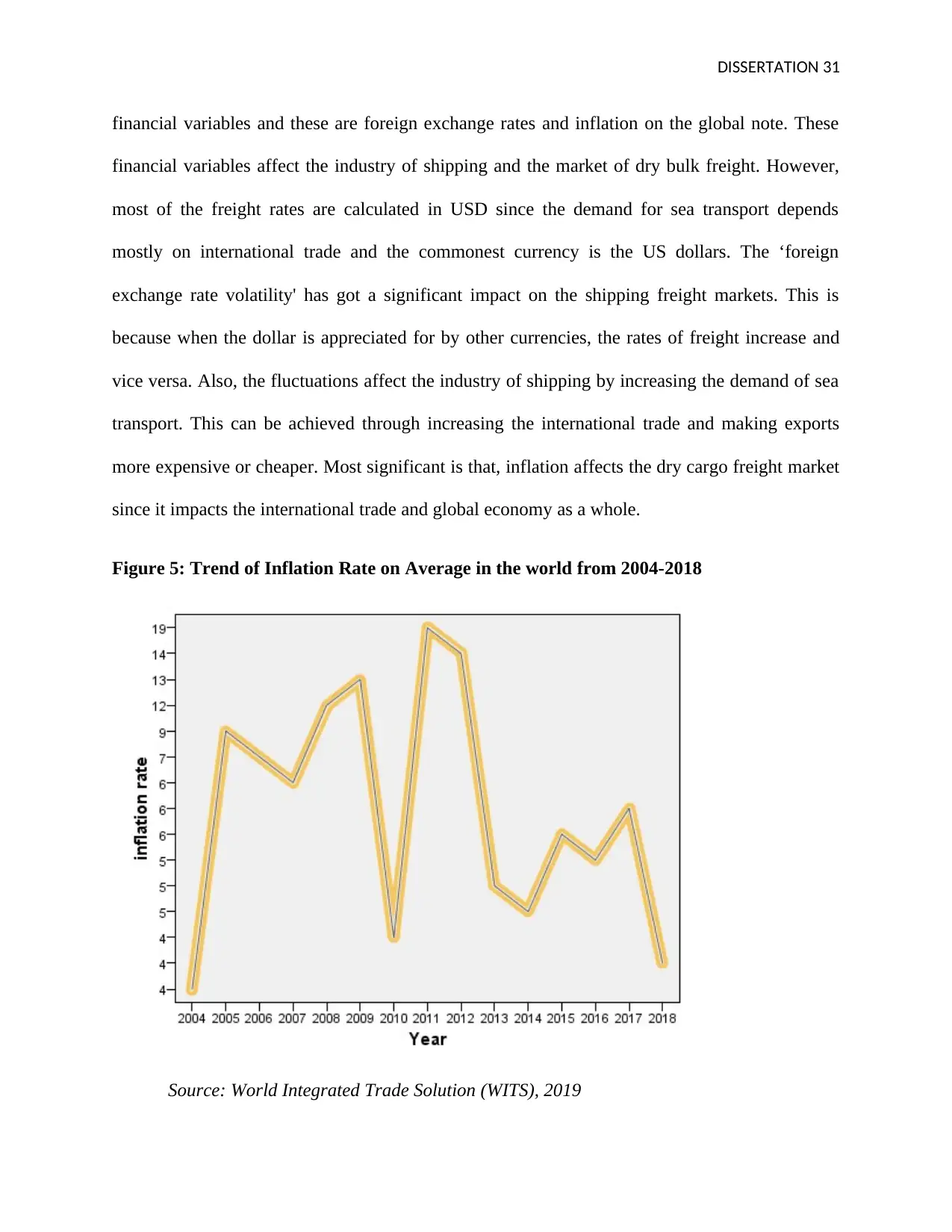
DISSERTATION 31
financial variables and these are foreign exchange rates and inflation on the global note. These
financial variables affect the industry of shipping and the market of dry bulk freight. However,
most of the freight rates are calculated in USD since the demand for sea transport depends
mostly on international trade and the commonest currency is the US dollars. The ‘foreign
exchange rate volatility' has got a significant impact on the shipping freight markets. This is
because when the dollar is appreciated for by other currencies, the rates of freight increase and
vice versa. Also, the fluctuations affect the industry of shipping by increasing the demand of sea
transport. This can be achieved through increasing the international trade and making exports
more expensive or cheaper. Most significant is that, inflation affects the dry cargo freight market
since it impacts the international trade and global economy as a whole.
Figure 5: Trend of Inflation Rate on Average in the world from 2004-2018
Source: World Integrated Trade Solution (WITS), 2019
financial variables and these are foreign exchange rates and inflation on the global note. These
financial variables affect the industry of shipping and the market of dry bulk freight. However,
most of the freight rates are calculated in USD since the demand for sea transport depends
mostly on international trade and the commonest currency is the US dollars. The ‘foreign
exchange rate volatility' has got a significant impact on the shipping freight markets. This is
because when the dollar is appreciated for by other currencies, the rates of freight increase and
vice versa. Also, the fluctuations affect the industry of shipping by increasing the demand of sea
transport. This can be achieved through increasing the international trade and making exports
more expensive or cheaper. Most significant is that, inflation affects the dry cargo freight market
since it impacts the international trade and global economy as a whole.
Figure 5: Trend of Inflation Rate on Average in the world from 2004-2018
Source: World Integrated Trade Solution (WITS), 2019
Paraphrase This Document
Need a fresh take? Get an instant paraphrase of this document with our AI Paraphraser
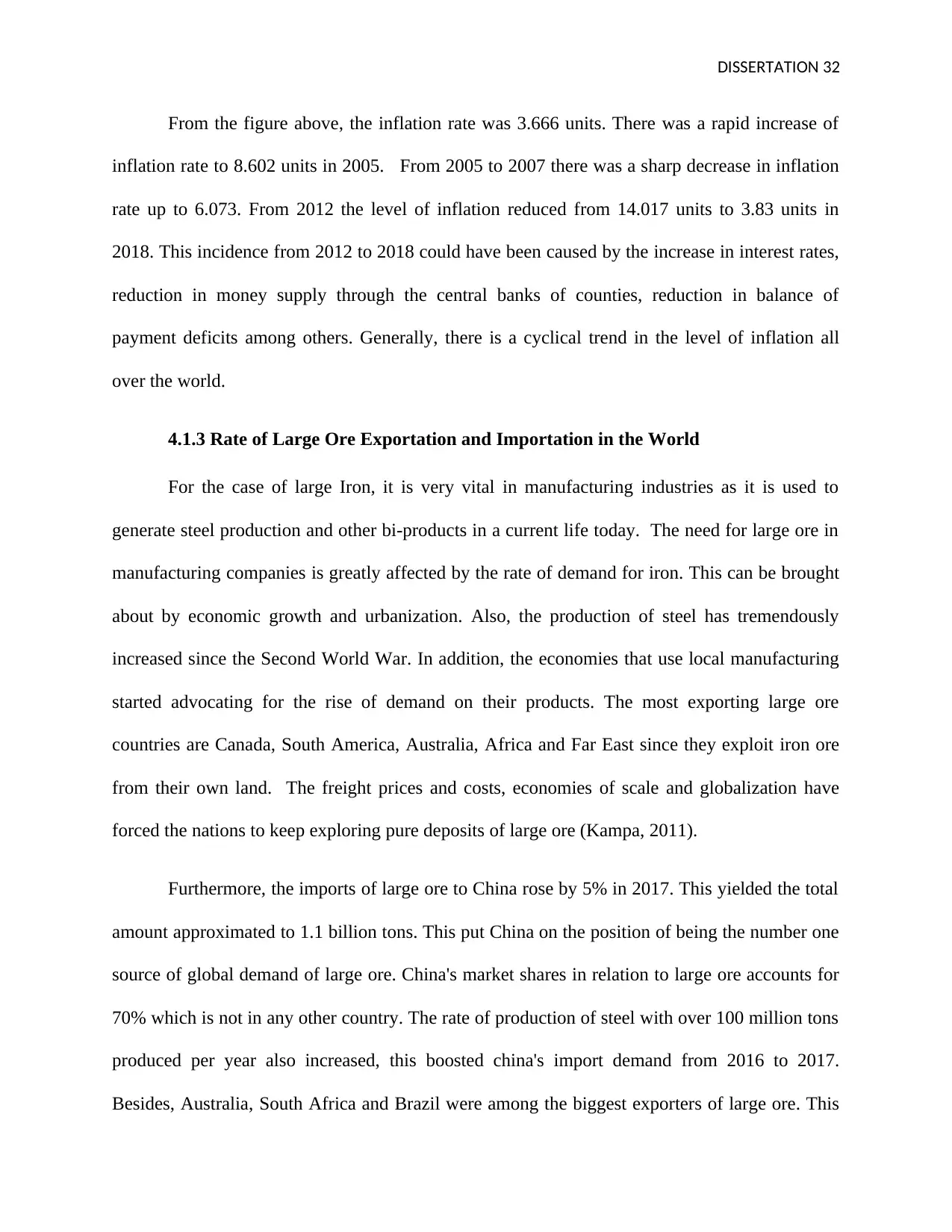
DISSERTATION 32
From the figure above, the inflation rate was 3.666 units. There was a rapid increase of
inflation rate to 8.602 units in 2005. From 2005 to 2007 there was a sharp decrease in inflation
rate up to 6.073. From 2012 the level of inflation reduced from 14.017 units to 3.83 units in
2018. This incidence from 2012 to 2018 could have been caused by the increase in interest rates,
reduction in money supply through the central banks of counties, reduction in balance of
payment deficits among others. Generally, there is a cyclical trend in the level of inflation all
over the world.
4.1.3 Rate of Large Ore Exportation and Importation in the World
For the case of large Iron, it is very vital in manufacturing industries as it is used to
generate steel production and other bi-products in a current life today. The need for large ore in
manufacturing companies is greatly affected by the rate of demand for iron. This can be brought
about by economic growth and urbanization. Also, the production of steel has tremendously
increased since the Second World War. In addition, the economies that use local manufacturing
started advocating for the rise of demand on their products. The most exporting large ore
countries are Canada, South America, Australia, Africa and Far East since they exploit iron ore
from their own land. The freight prices and costs, economies of scale and globalization have
forced the nations to keep exploring pure deposits of large ore (Kampa, 2011).
Furthermore, the imports of large ore to China rose by 5% in 2017. This yielded the total
amount approximated to 1.1 billion tons. This put China on the position of being the number one
source of global demand of large ore. China's market shares in relation to large ore accounts for
70% which is not in any other country. The rate of production of steel with over 100 million tons
produced per year also increased, this boosted china's import demand from 2016 to 2017.
Besides, Australia, South Africa and Brazil were among the biggest exporters of large ore. This
From the figure above, the inflation rate was 3.666 units. There was a rapid increase of
inflation rate to 8.602 units in 2005. From 2005 to 2007 there was a sharp decrease in inflation
rate up to 6.073. From 2012 the level of inflation reduced from 14.017 units to 3.83 units in
2018. This incidence from 2012 to 2018 could have been caused by the increase in interest rates,
reduction in money supply through the central banks of counties, reduction in balance of
payment deficits among others. Generally, there is a cyclical trend in the level of inflation all
over the world.
4.1.3 Rate of Large Ore Exportation and Importation in the World
For the case of large Iron, it is very vital in manufacturing industries as it is used to
generate steel production and other bi-products in a current life today. The need for large ore in
manufacturing companies is greatly affected by the rate of demand for iron. This can be brought
about by economic growth and urbanization. Also, the production of steel has tremendously
increased since the Second World War. In addition, the economies that use local manufacturing
started advocating for the rise of demand on their products. The most exporting large ore
countries are Canada, South America, Australia, Africa and Far East since they exploit iron ore
from their own land. The freight prices and costs, economies of scale and globalization have
forced the nations to keep exploring pure deposits of large ore (Kampa, 2011).
Furthermore, the imports of large ore to China rose by 5% in 2017. This yielded the total
amount approximated to 1.1 billion tons. This put China on the position of being the number one
source of global demand of large ore. China's market shares in relation to large ore accounts for
70% which is not in any other country. The rate of production of steel with over 100 million tons
produced per year also increased, this boosted china's import demand from 2016 to 2017.
Besides, Australia, South Africa and Brazil were among the biggest exporters of large ore. This
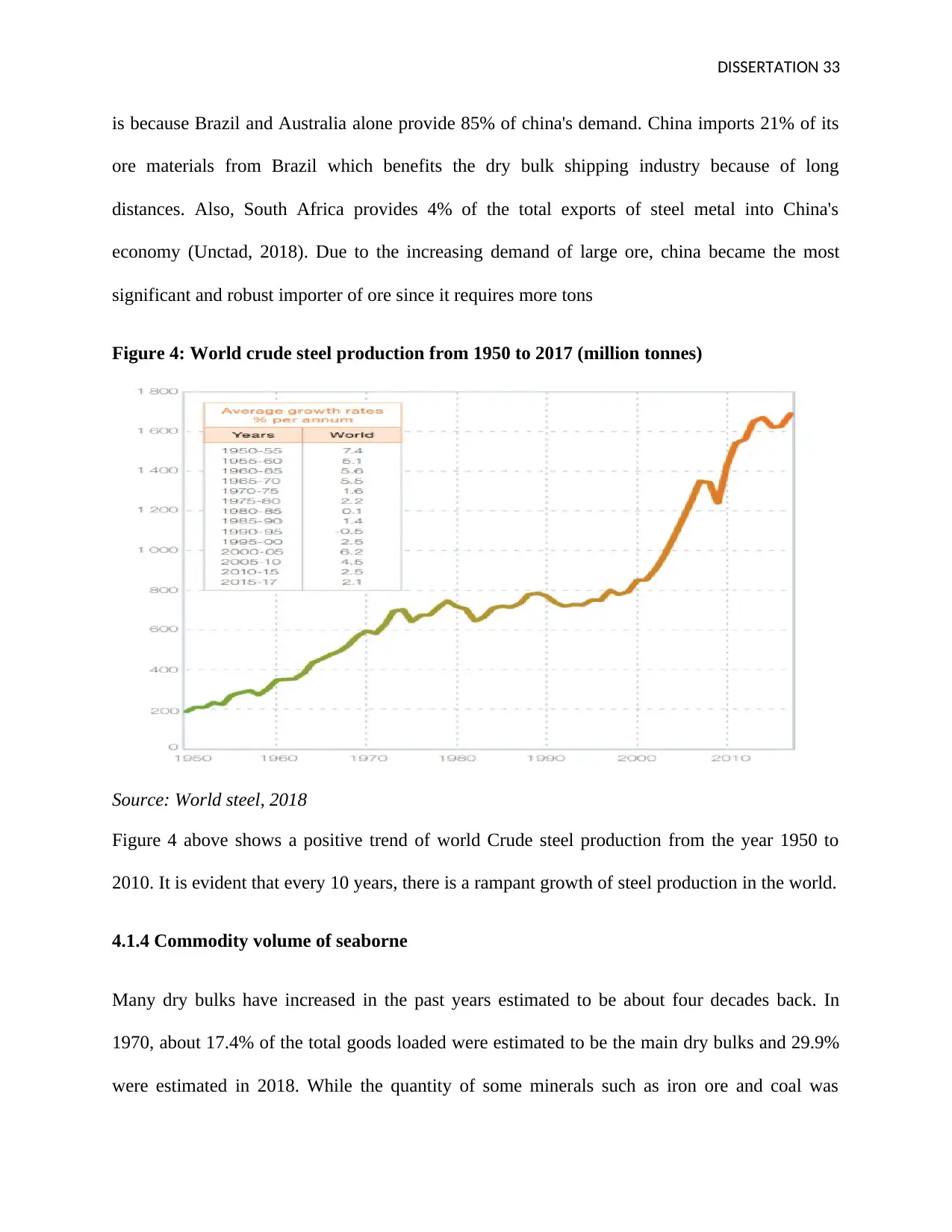
DISSERTATION 33
is because Brazil and Australia alone provide 85% of china's demand. China imports 21% of its
ore materials from Brazil which benefits the dry bulk shipping industry because of long
distances. Also, South Africa provides 4% of the total exports of steel metal into China's
economy (Unctad, 2018). Due to the increasing demand of large ore, china became the most
significant and robust importer of ore since it requires more tons
Figure 4: World crude steel production from 1950 to 2017 (million tonnes)
Source: World steel, 2018
Figure 4 above shows a positive trend of world Crude steel production from the year 1950 to
2010. It is evident that every 10 years, there is a rampant growth of steel production in the world.
4.1.4 Commodity volume of seaborne
Many dry bulks have increased in the past years estimated to be about four decades back. In
1970, about 17.4% of the total goods loaded were estimated to be the main dry bulks and 29.9%
were estimated in 2018. While the quantity of some minerals such as iron ore and coal was
is because Brazil and Australia alone provide 85% of china's demand. China imports 21% of its
ore materials from Brazil which benefits the dry bulk shipping industry because of long
distances. Also, South Africa provides 4% of the total exports of steel metal into China's
economy (Unctad, 2018). Due to the increasing demand of large ore, china became the most
significant and robust importer of ore since it requires more tons
Figure 4: World crude steel production from 1950 to 2017 (million tonnes)
Source: World steel, 2018
Figure 4 above shows a positive trend of world Crude steel production from the year 1950 to
2010. It is evident that every 10 years, there is a rampant growth of steel production in the world.
4.1.4 Commodity volume of seaborne
Many dry bulks have increased in the past years estimated to be about four decades back. In
1970, about 17.4% of the total goods loaded were estimated to be the main dry bulks and 29.9%
were estimated in 2018. While the quantity of some minerals such as iron ore and coal was
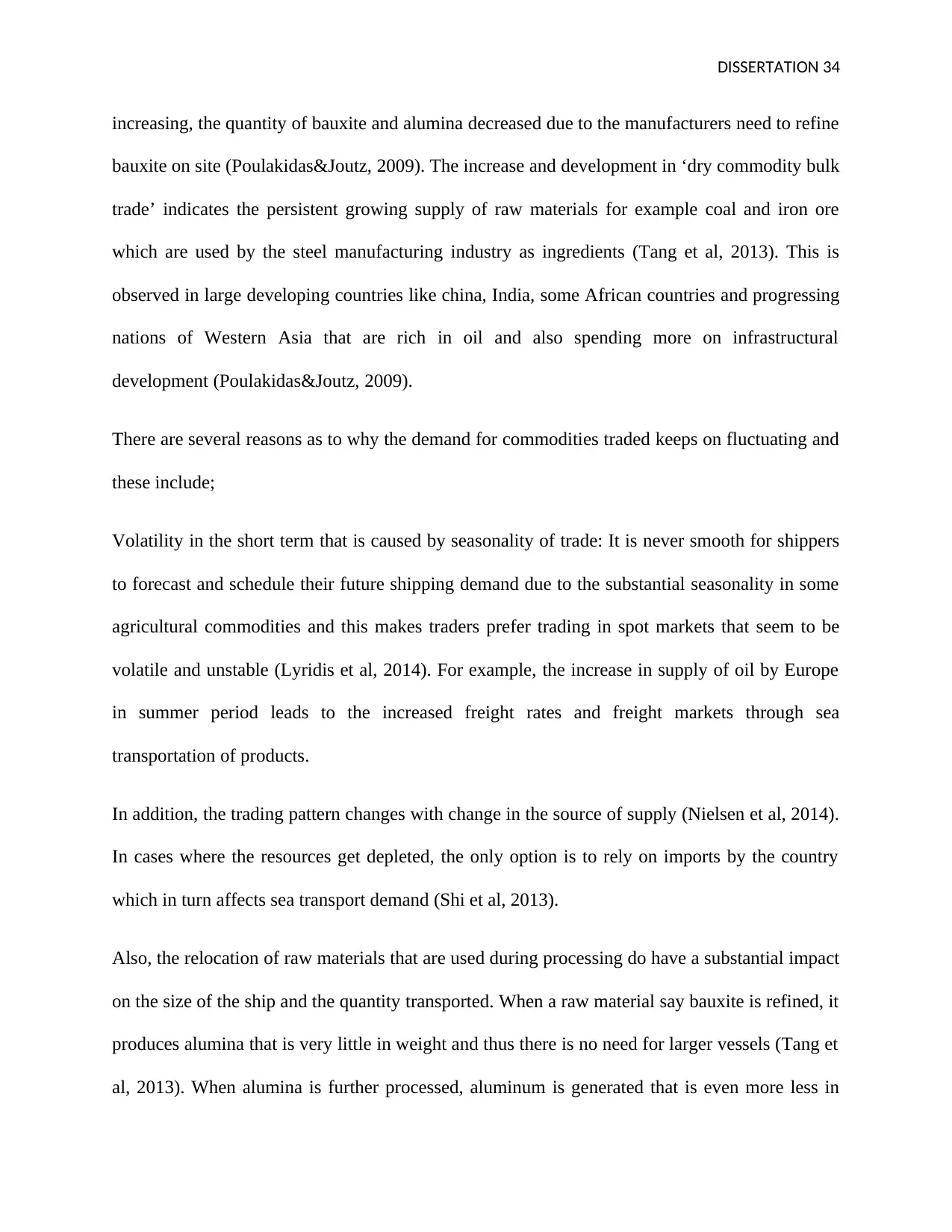
DISSERTATION 34
increasing, the quantity of bauxite and alumina decreased due to the manufacturers need to refine
bauxite on site (Poulakidas&Joutz, 2009). The increase and development in ‘dry commodity bulk
trade’ indicates the persistent growing supply of raw materials for example coal and iron ore
which are used by the steel manufacturing industry as ingredients (Tang et al, 2013). This is
observed in large developing countries like china, India, some African countries and progressing
nations of Western Asia that are rich in oil and also spending more on infrastructural
development (Poulakidas&Joutz, 2009).
There are several reasons as to why the demand for commodities traded keeps on fluctuating and
these include;
Volatility in the short term that is caused by seasonality of trade: It is never smooth for shippers
to forecast and schedule their future shipping demand due to the substantial seasonality in some
agricultural commodities and this makes traders prefer trading in spot markets that seem to be
volatile and unstable (Lyridis et al, 2014). For example, the increase in supply of oil by Europe
in summer period leads to the increased freight rates and freight markets through sea
transportation of products.
In addition, the trading pattern changes with change in the source of supply (Nielsen et al, 2014).
In cases where the resources get depleted, the only option is to rely on imports by the country
which in turn affects sea transport demand (Shi et al, 2013).
Also, the relocation of raw materials that are used during processing do have a substantial impact
on the size of the ship and the quantity transported. When a raw material say bauxite is refined, it
produces alumina that is very little in weight and thus there is no need for larger vessels (Tang et
al, 2013). When alumina is further processed, aluminum is generated that is even more less in
increasing, the quantity of bauxite and alumina decreased due to the manufacturers need to refine
bauxite on site (Poulakidas&Joutz, 2009). The increase and development in ‘dry commodity bulk
trade’ indicates the persistent growing supply of raw materials for example coal and iron ore
which are used by the steel manufacturing industry as ingredients (Tang et al, 2013). This is
observed in large developing countries like china, India, some African countries and progressing
nations of Western Asia that are rich in oil and also spending more on infrastructural
development (Poulakidas&Joutz, 2009).
There are several reasons as to why the demand for commodities traded keeps on fluctuating and
these include;
Volatility in the short term that is caused by seasonality of trade: It is never smooth for shippers
to forecast and schedule their future shipping demand due to the substantial seasonality in some
agricultural commodities and this makes traders prefer trading in spot markets that seem to be
volatile and unstable (Lyridis et al, 2014). For example, the increase in supply of oil by Europe
in summer period leads to the increased freight rates and freight markets through sea
transportation of products.
In addition, the trading pattern changes with change in the source of supply (Nielsen et al, 2014).
In cases where the resources get depleted, the only option is to rely on imports by the country
which in turn affects sea transport demand (Shi et al, 2013).
Also, the relocation of raw materials that are used during processing do have a substantial impact
on the size of the ship and the quantity transported. When a raw material say bauxite is refined, it
produces alumina that is very little in weight and thus there is no need for larger vessels (Tang et
al, 2013). When alumina is further processed, aluminum is generated that is even more less in
Secure Best Marks with AI Grader
Need help grading? Try our AI Grader for instant feedback on your assignments.

DISSERTATION 35
volume and thus it requires a smaller container than bauxite. Furthermore, the need for shipping
also depends on the shipper's transport policy. In the 1970s, oil majors in the U.S. rented long-
term tonnage or constructed vessels against long-term agreements in partnership with ship
owners (Shi et al, 2013). Although this happened, their policies failed after the crisis of oil in
1973 making them stay far from the long term contracts and participating in the spot market
(Lyridis et al, 2014). Finally, poor harvest due to drought, and floods brought about by bad
weather and climate may limit a country to import that raises the demand for shipping services.
Figure 6: World Seaborne trade in cargo ton-miles 2000-2018 (Billions of ton-miles)
Source: United Nations Conference on Trade (UNCTAD),2019
4.2 Stationarity and Normality Testing
Stationarity testingwas performed on the indicators of freight rates that determine
demand and supply factors. Normality test was obtained using the Augmented Dickey Fuller
tests whereas Shapiro Wilkson’s test for normality testing.
volume and thus it requires a smaller container than bauxite. Furthermore, the need for shipping
also depends on the shipper's transport policy. In the 1970s, oil majors in the U.S. rented long-
term tonnage or constructed vessels against long-term agreements in partnership with ship
owners (Shi et al, 2013). Although this happened, their policies failed after the crisis of oil in
1973 making them stay far from the long term contracts and participating in the spot market
(Lyridis et al, 2014). Finally, poor harvest due to drought, and floods brought about by bad
weather and climate may limit a country to import that raises the demand for shipping services.
Figure 6: World Seaborne trade in cargo ton-miles 2000-2018 (Billions of ton-miles)
Source: United Nations Conference on Trade (UNCTAD),2019
4.2 Stationarity and Normality Testing
Stationarity testingwas performed on the indicators of freight rates that determine
demand and supply factors. Normality test was obtained using the Augmented Dickey Fuller
tests whereas Shapiro Wilkson’s test for normality testing.
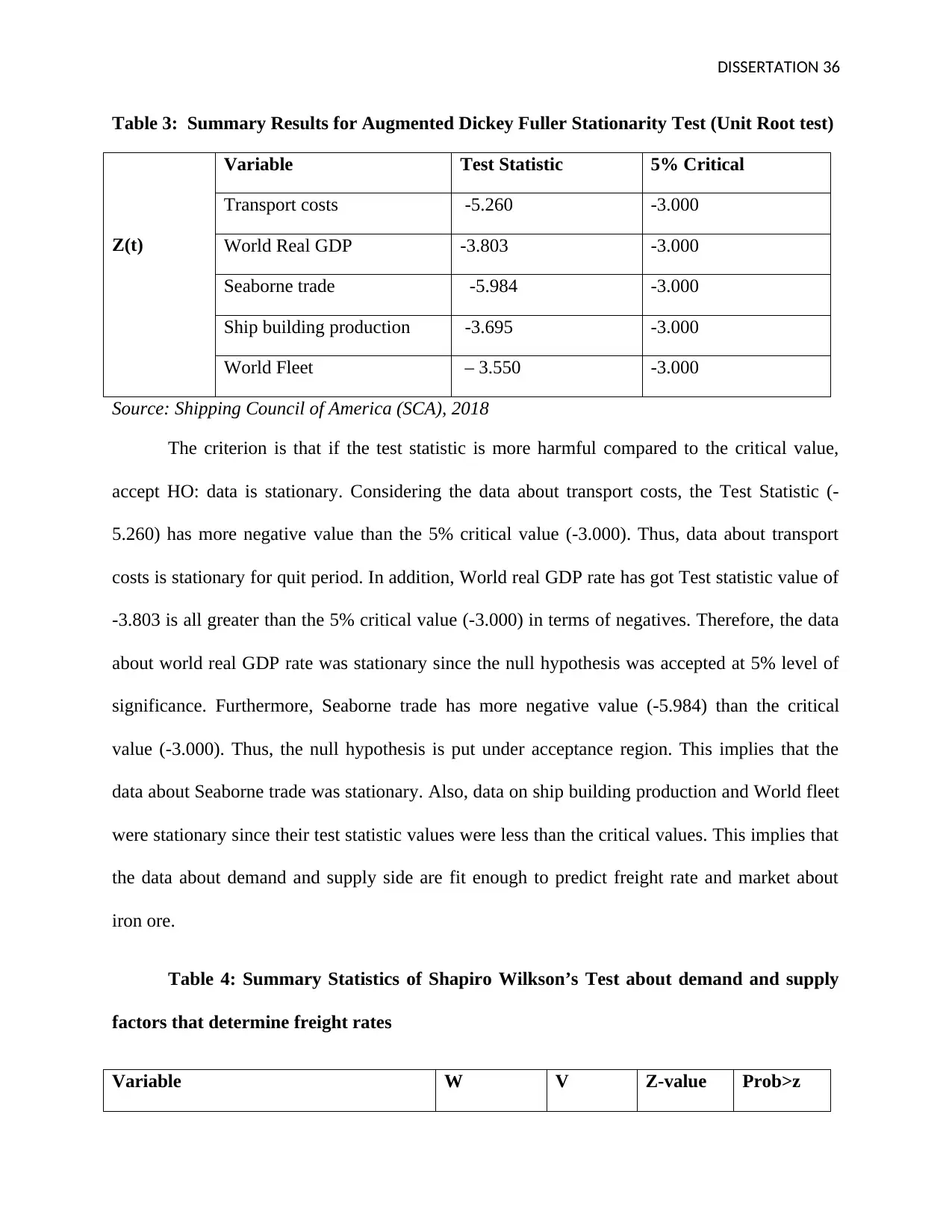
DISSERTATION 36
Table 3: Summary Results for Augmented Dickey Fuller Stationarity Test (Unit Root test)
Z(t)
Variable Test Statistic 5% Critical
Transport costs -5.260 -3.000
World Real GDP -3.803 -3.000
Seaborne trade -5.984 -3.000
Ship building production -3.695 -3.000
World Fleet – 3.550 -3.000
Source: Shipping Council of America (SCA), 2018
The criterion is that if the test statistic is more harmful compared to the critical value,
accept HO: data is stationary. Considering the data about transport costs, the Test Statistic (-
5.260) has more negative value than the 5% critical value (-3.000). Thus, data about transport
costs is stationary for quit period. In addition, World real GDP rate has got Test statistic value of
-3.803 is all greater than the 5% critical value (-3.000) in terms of negatives. Therefore, the data
about world real GDP rate was stationary since the null hypothesis was accepted at 5% level of
significance. Furthermore, Seaborne trade has more negative value (-5.984) than the critical
value (-3.000). Thus, the null hypothesis is put under acceptance region. This implies that the
data about Seaborne trade was stationary. Also, data on ship building production and World fleet
were stationary since their test statistic values were less than the critical values. This implies that
the data about demand and supply side are fit enough to predict freight rate and market about
iron ore.
Table 4: Summary Statistics of Shapiro Wilkson’s Test about demand and supply
factors that determine freight rates
Variable W V Z-value Prob>z
Table 3: Summary Results for Augmented Dickey Fuller Stationarity Test (Unit Root test)
Z(t)
Variable Test Statistic 5% Critical
Transport costs -5.260 -3.000
World Real GDP -3.803 -3.000
Seaborne trade -5.984 -3.000
Ship building production -3.695 -3.000
World Fleet – 3.550 -3.000
Source: Shipping Council of America (SCA), 2018
The criterion is that if the test statistic is more harmful compared to the critical value,
accept HO: data is stationary. Considering the data about transport costs, the Test Statistic (-
5.260) has more negative value than the 5% critical value (-3.000). Thus, data about transport
costs is stationary for quit period. In addition, World real GDP rate has got Test statistic value of
-3.803 is all greater than the 5% critical value (-3.000) in terms of negatives. Therefore, the data
about world real GDP rate was stationary since the null hypothesis was accepted at 5% level of
significance. Furthermore, Seaborne trade has more negative value (-5.984) than the critical
value (-3.000). Thus, the null hypothesis is put under acceptance region. This implies that the
data about Seaborne trade was stationary. Also, data on ship building production and World fleet
were stationary since their test statistic values were less than the critical values. This implies that
the data about demand and supply side are fit enough to predict freight rate and market about
iron ore.
Table 4: Summary Statistics of Shapiro Wilkson’s Test about demand and supply
factors that determine freight rates
Variable W V Z-value Prob>z
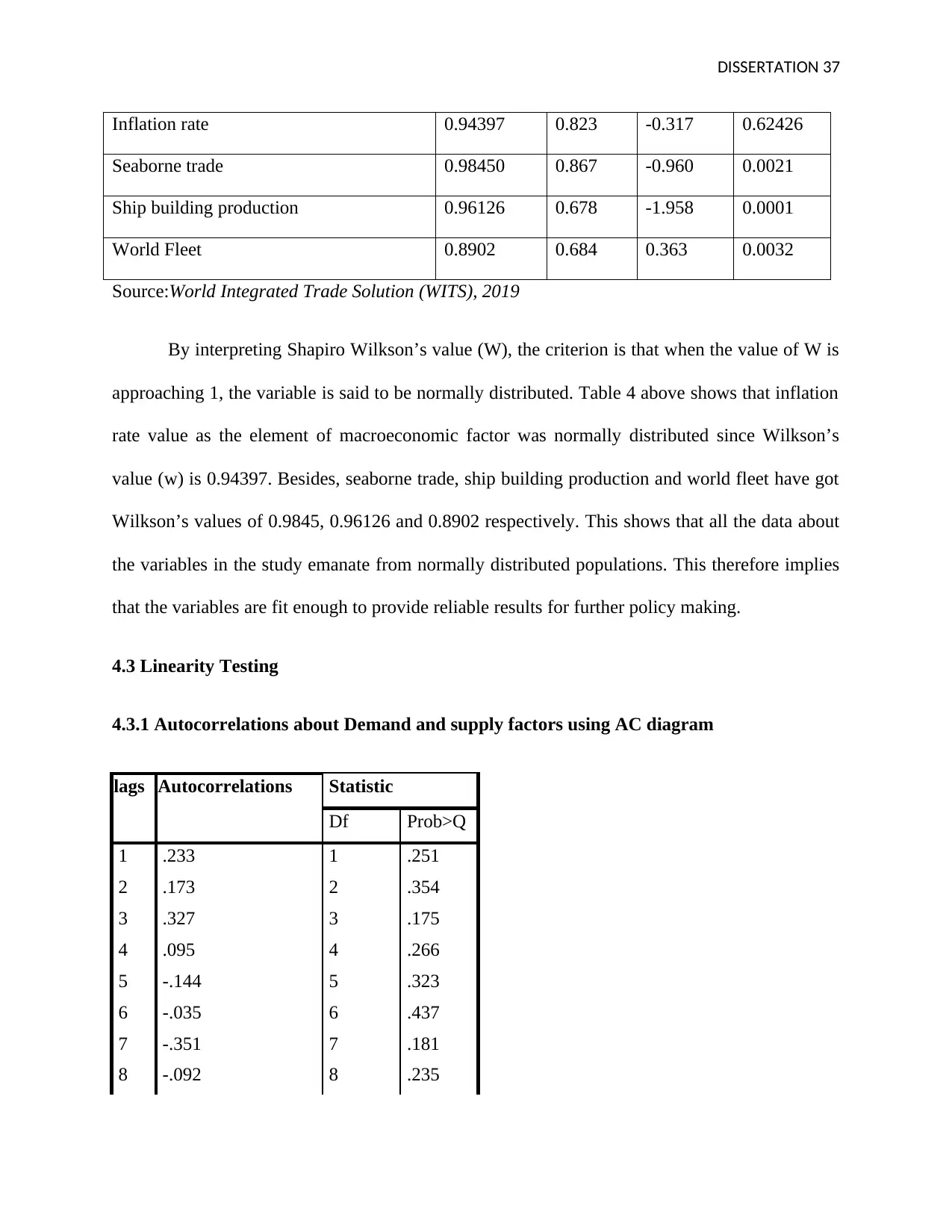
DISSERTATION 37
Inflation rate 0.94397 0.823 -0.317 0.62426
Seaborne trade 0.98450 0.867 -0.960 0.0021
Ship building production 0.96126 0.678 -1.958 0.0001
World Fleet 0.8902 0.684 0.363 0.0032
Source:World Integrated Trade Solution (WITS), 2019
By interpreting Shapiro Wilkson’s value (W), the criterion is that when the value of W is
approaching 1, the variable is said to be normally distributed. Table 4 above shows that inflation
rate value as the element of macroeconomic factor was normally distributed since Wilkson’s
value (w) is 0.94397. Besides, seaborne trade, ship building production and world fleet have got
Wilkson’s values of 0.9845, 0.96126 and 0.8902 respectively. This shows that all the data about
the variables in the study emanate from normally distributed populations. This therefore implies
that the variables are fit enough to provide reliable results for further policy making.
4.3 Linearity Testing
4.3.1 Autocorrelations about Demand and supply factors using AC diagram
lags Autocorrelations Statistic
Df Prob>Q
1 .233 1 .251
2 .173 2 .354
3 .327 3 .175
4 .095 4 .266
5 -.144 5 .323
6 -.035 6 .437
7 -.351 7 .181
8 -.092 8 .235
Inflation rate 0.94397 0.823 -0.317 0.62426
Seaborne trade 0.98450 0.867 -0.960 0.0021
Ship building production 0.96126 0.678 -1.958 0.0001
World Fleet 0.8902 0.684 0.363 0.0032
Source:World Integrated Trade Solution (WITS), 2019
By interpreting Shapiro Wilkson’s value (W), the criterion is that when the value of W is
approaching 1, the variable is said to be normally distributed. Table 4 above shows that inflation
rate value as the element of macroeconomic factor was normally distributed since Wilkson’s
value (w) is 0.94397. Besides, seaborne trade, ship building production and world fleet have got
Wilkson’s values of 0.9845, 0.96126 and 0.8902 respectively. This shows that all the data about
the variables in the study emanate from normally distributed populations. This therefore implies
that the variables are fit enough to provide reliable results for further policy making.
4.3 Linearity Testing
4.3.1 Autocorrelations about Demand and supply factors using AC diagram
lags Autocorrelations Statistic
Df Prob>Q
1 .233 1 .251
2 .173 2 .354
3 .327 3 .175
4 .095 4 .266
5 -.144 5 .323
6 -.035 6 .437
7 -.351 7 .181
8 -.092 8 .235
Paraphrase This Document
Need a fresh take? Get an instant paraphrase of this document with our AI Paraphraser
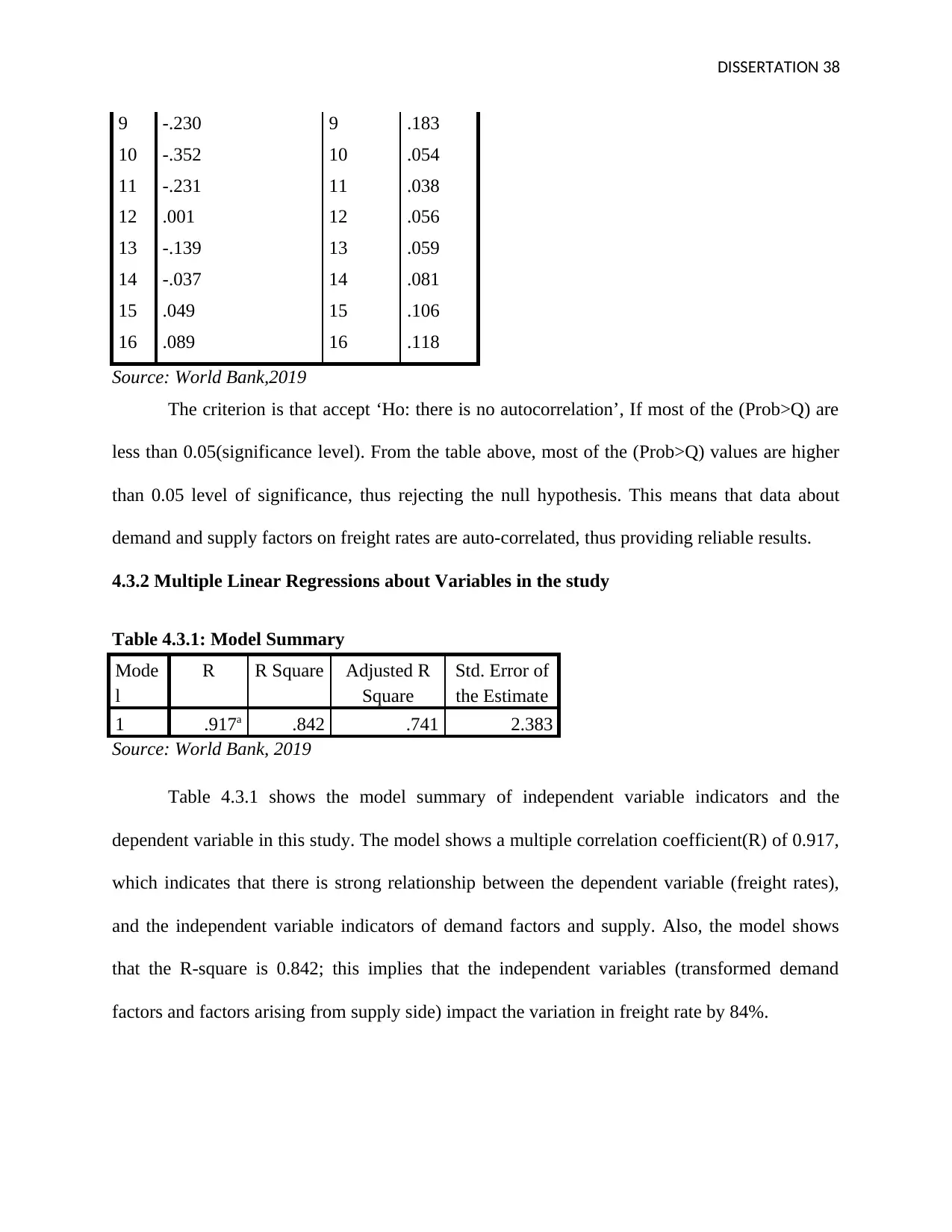
DISSERTATION 38
9 -.230 9 .183
10 -.352 10 .054
11 -.231 11 .038
12 .001 12 .056
13 -.139 13 .059
14 -.037 14 .081
15 .049 15 .106
16 .089 16 .118
Source: World Bank,2019
The criterion is that accept ‘Ho: there is no autocorrelation’, If most of the (Prob>Q) are
less than 0.05(significance level). From the table above, most of the (Prob>Q) values are higher
than 0.05 level of significance, thus rejecting the null hypothesis. This means that data about
demand and supply factors on freight rates are auto-correlated, thus providing reliable results.
4.3.2 Multiple Linear Regressions about Variables in the study
Table 4.3.1: Model Summary
Mode
l
R R Square Adjusted R
Square
Std. Error of
the Estimate
1 .917a .842 .741 2.383
Source: World Bank, 2019
Table 4.3.1 shows the model summary of independent variable indicators and the
dependent variable in this study. The model shows a multiple correlation coefficient(R) of 0.917,
which indicates that there is strong relationship between the dependent variable (freight rates),
and the independent variable indicators of demand factors and supply. Also, the model shows
that the R-square is 0.842; this implies that the independent variables (transformed demand
factors and factors arising from supply side) impact the variation in freight rate by 84%.
9 -.230 9 .183
10 -.352 10 .054
11 -.231 11 .038
12 .001 12 .056
13 -.139 13 .059
14 -.037 14 .081
15 .049 15 .106
16 .089 16 .118
Source: World Bank,2019
The criterion is that accept ‘Ho: there is no autocorrelation’, If most of the (Prob>Q) are
less than 0.05(significance level). From the table above, most of the (Prob>Q) values are higher
than 0.05 level of significance, thus rejecting the null hypothesis. This means that data about
demand and supply factors on freight rates are auto-correlated, thus providing reliable results.
4.3.2 Multiple Linear Regressions about Variables in the study
Table 4.3.1: Model Summary
Mode
l
R R Square Adjusted R
Square
Std. Error of
the Estimate
1 .917a .842 .741 2.383
Source: World Bank, 2019
Table 4.3.1 shows the model summary of independent variable indicators and the
dependent variable in this study. The model shows a multiple correlation coefficient(R) of 0.917,
which indicates that there is strong relationship between the dependent variable (freight rates),
and the independent variable indicators of demand factors and supply. Also, the model shows
that the R-square is 0.842; this implies that the independent variables (transformed demand
factors and factors arising from supply side) impact the variation in freight rate by 84%.

DISSERTATION 39
Table 4.3.2: Analysis of Variance
Model Sum of
Squares
df Mean
Square
F Sig.Valu
e
1
Regression 331.521 7 47.360 8.343 .001b
Residual 62.439 11 5.676
Total 393.960 18
Source: World Bank, 2019
Table 4.3.2 elaborates the ANOVA table. The null hypothesis is that the model is not
significant. The procedure is that when the critical value is less than 0.05 (level of significance),
reject the null hypothesis. From the above table 4.3.2, the Sig value is 0.001 which is less than
the level of significance (0.05) thus rejecting the null hypothesis. This implies that the model is
significant at 5% level of significance.
Table 4.3.3: Coefficients a
Model Unstandardized
Coefficients
Standardized
Coefficients
T Sig.
B Std. Error Beta
1
(Constant) 115.865 23.873 4.853 .000
World Economy .098 .165 -.224 -.595 .004
Seaborne Trade .170 .214 -.349 -.791 006
Transport Costs -.462 .114 -.605 -4.071 .002
Average Haul .096 .083 .161 1.157 .002
Ship building
production .465 .337 .226 1.379 .000
World fleet 2.832 .539 -1.123 -5.257 .000
Scrapping and losses -.547 .331 -.387 -1.652 .001
a-Dependent Variable: Freight rates
Source: World Bank, 2019
Table 4.3 .3 depicts the multiple linear relationships between the variables under the
study using the regression analysis. The linear regression model is stated as below;
Table 4.3.2: Analysis of Variance
Model Sum of
Squares
df Mean
Square
F Sig.Valu
e
1
Regression 331.521 7 47.360 8.343 .001b
Residual 62.439 11 5.676
Total 393.960 18
Source: World Bank, 2019
Table 4.3.2 elaborates the ANOVA table. The null hypothesis is that the model is not
significant. The procedure is that when the critical value is less than 0.05 (level of significance),
reject the null hypothesis. From the above table 4.3.2, the Sig value is 0.001 which is less than
the level of significance (0.05) thus rejecting the null hypothesis. This implies that the model is
significant at 5% level of significance.
Table 4.3.3: Coefficients a
Model Unstandardized
Coefficients
Standardized
Coefficients
T Sig.
B Std. Error Beta
1
(Constant) 115.865 23.873 4.853 .000
World Economy .098 .165 -.224 -.595 .004
Seaborne Trade .170 .214 -.349 -.791 006
Transport Costs -.462 .114 -.605 -4.071 .002
Average Haul .096 .083 .161 1.157 .002
Ship building
production .465 .337 .226 1.379 .000
World fleet 2.832 .539 -1.123 -5.257 .000
Scrapping and losses -.547 .331 -.387 -1.652 .001
a-Dependent Variable: Freight rates
Source: World Bank, 2019
Table 4.3 .3 depicts the multiple linear relationships between the variables under the
study using the regression analysis. The linear regression model is stated as below;
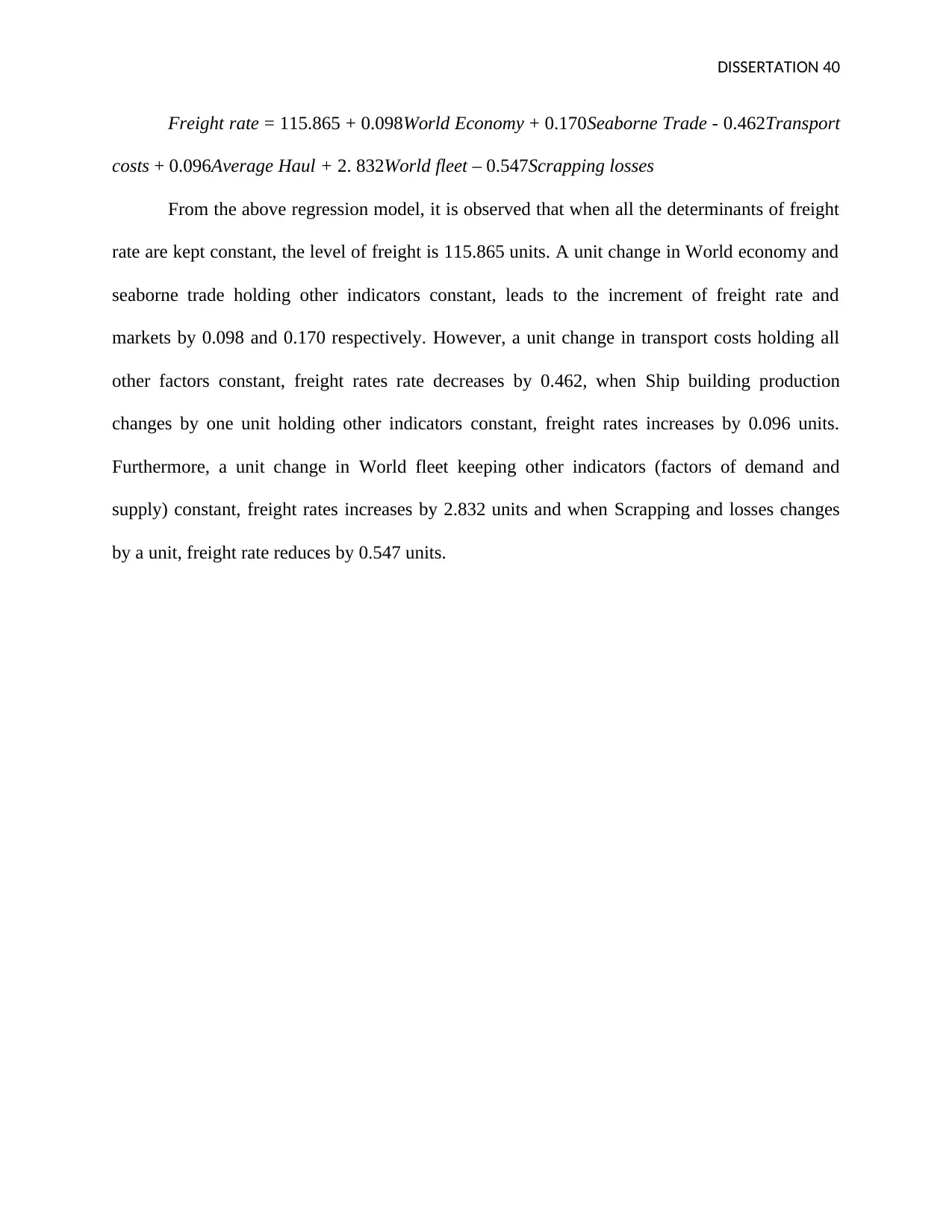
DISSERTATION 40
Freight rate = 115.865 + 0.098World Economy + 0.170Seaborne Trade - 0.462Transport
costs + 0.096Average Haul + 2. 832World fleet – 0.547Scrapping losses
From the above regression model, it is observed that when all the determinants of freight
rate are kept constant, the level of freight is 115.865 units. A unit change in World economy and
seaborne trade holding other indicators constant, leads to the increment of freight rate and
markets by 0.098 and 0.170 respectively. However, a unit change in transport costs holding all
other factors constant, freight rates rate decreases by 0.462, when Ship building production
changes by one unit holding other indicators constant, freight rates increases by 0.096 units.
Furthermore, a unit change in World fleet keeping other indicators (factors of demand and
supply) constant, freight rates increases by 2.832 units and when Scrapping and losses changes
by a unit, freight rate reduces by 0.547 units.
Freight rate = 115.865 + 0.098World Economy + 0.170Seaborne Trade - 0.462Transport
costs + 0.096Average Haul + 2. 832World fleet – 0.547Scrapping losses
From the above regression model, it is observed that when all the determinants of freight
rate are kept constant, the level of freight is 115.865 units. A unit change in World economy and
seaborne trade holding other indicators constant, leads to the increment of freight rate and
markets by 0.098 and 0.170 respectively. However, a unit change in transport costs holding all
other factors constant, freight rates rate decreases by 0.462, when Ship building production
changes by one unit holding other indicators constant, freight rates increases by 0.096 units.
Furthermore, a unit change in World fleet keeping other indicators (factors of demand and
supply) constant, freight rates increases by 2.832 units and when Scrapping and losses changes
by a unit, freight rate reduces by 0.547 units.
Secure Best Marks with AI Grader
Need help grading? Try our AI Grader for instant feedback on your assignments.
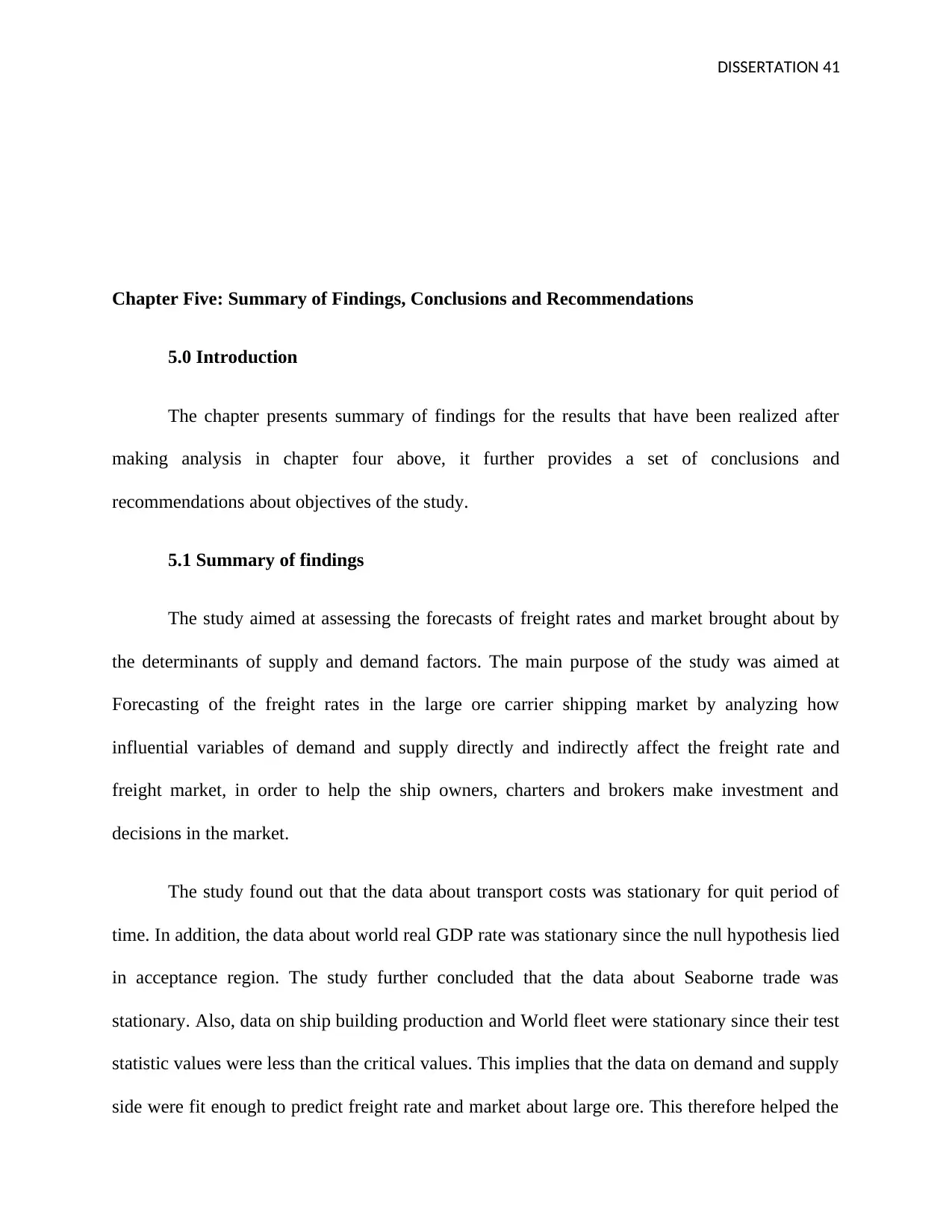
DISSERTATION 41
Chapter Five: Summary of Findings, Conclusions and Recommendations
5.0 Introduction
The chapter presents summary of findings for the results that have been realized after
making analysis in chapter four above, it further provides a set of conclusions and
recommendations about objectives of the study.
5.1 Summary of findings
The study aimed at assessing the forecasts of freight rates and market brought about by
the determinants of supply and demand factors. The main purpose of the study was aimed at
Forecasting of the freight rates in the large ore carrier shipping market by analyzing how
influential variables of demand and supply directly and indirectly affect the freight rate and
freight market, in order to help the ship owners, charters and brokers make investment and
decisions in the market.
The study found out that the data about transport costs was stationary for quit period of
time. In addition, the data about world real GDP rate was stationary since the null hypothesis lied
in acceptance region. The study further concluded that the data about Seaborne trade was
stationary. Also, data on ship building production and World fleet were stationary since their test
statistic values were less than the critical values. This implies that the data on demand and supply
side were fit enough to predict freight rate and market about large ore. This therefore helped the
Chapter Five: Summary of Findings, Conclusions and Recommendations
5.0 Introduction
The chapter presents summary of findings for the results that have been realized after
making analysis in chapter four above, it further provides a set of conclusions and
recommendations about objectives of the study.
5.1 Summary of findings
The study aimed at assessing the forecasts of freight rates and market brought about by
the determinants of supply and demand factors. The main purpose of the study was aimed at
Forecasting of the freight rates in the large ore carrier shipping market by analyzing how
influential variables of demand and supply directly and indirectly affect the freight rate and
freight market, in order to help the ship owners, charters and brokers make investment and
decisions in the market.
The study found out that the data about transport costs was stationary for quit period of
time. In addition, the data about world real GDP rate was stationary since the null hypothesis lied
in acceptance region. The study further concluded that the data about Seaborne trade was
stationary. Also, data on ship building production and World fleet were stationary since their test
statistic values were less than the critical values. This implies that the data on demand and supply
side were fit enough to predict freight rate and market about large ore. This therefore helped the

DISSERTATION 42
researcher to obtain reliable results about the variables. It is evident that data which is stationary
provides more reliable data especially when regressing the variables.
Furthermore, the findings showed that inflation rate value as the element of
macroeconomic factor was normally distributed. This was because the value of Shapiro Wilkson
was approximately equal to 1. Besides, Seaborne trade, ship building production and world fleet
originated from normally distributed population. When the variable is normally distributed,
consistency and unbiasedness between the variables in the study. Consistent and unbiased results
provide information which is reliable in order to aid decision making in organizations and other
beneficiaries.
In addition, study indicated strong relationship between independent variables and
dependent variable in the study. This is because the multiple correlation coefficient was very
high almost approaching to 1. This therefore implies that demand and supply factors affect
strongly the freight rates. Also, the study foundout that world economy status and seaborne trade
have got positive relationship towards the large ore freight rates and the entire market. This
implies that most of the factors arising from demand and supply side influenced the rates and
markets of freight as sea transportation is concerned. The study found out that when the transport
costs are high, the rate of freight reduces drastically due to the negative coefficient in the
regression equation.
5.2. Discussions
researcher to obtain reliable results about the variables. It is evident that data which is stationary
provides more reliable data especially when regressing the variables.
Furthermore, the findings showed that inflation rate value as the element of
macroeconomic factor was normally distributed. This was because the value of Shapiro Wilkson
was approximately equal to 1. Besides, Seaborne trade, ship building production and world fleet
originated from normally distributed population. When the variable is normally distributed,
consistency and unbiasedness between the variables in the study. Consistent and unbiased results
provide information which is reliable in order to aid decision making in organizations and other
beneficiaries.
In addition, study indicated strong relationship between independent variables and
dependent variable in the study. This is because the multiple correlation coefficient was very
high almost approaching to 1. This therefore implies that demand and supply factors affect
strongly the freight rates. Also, the study foundout that world economy status and seaborne trade
have got positive relationship towards the large ore freight rates and the entire market. This
implies that most of the factors arising from demand and supply side influenced the rates and
markets of freight as sea transportation is concerned. The study found out that when the transport
costs are high, the rate of freight reduces drastically due to the negative coefficient in the
regression equation.
5.2. Discussions
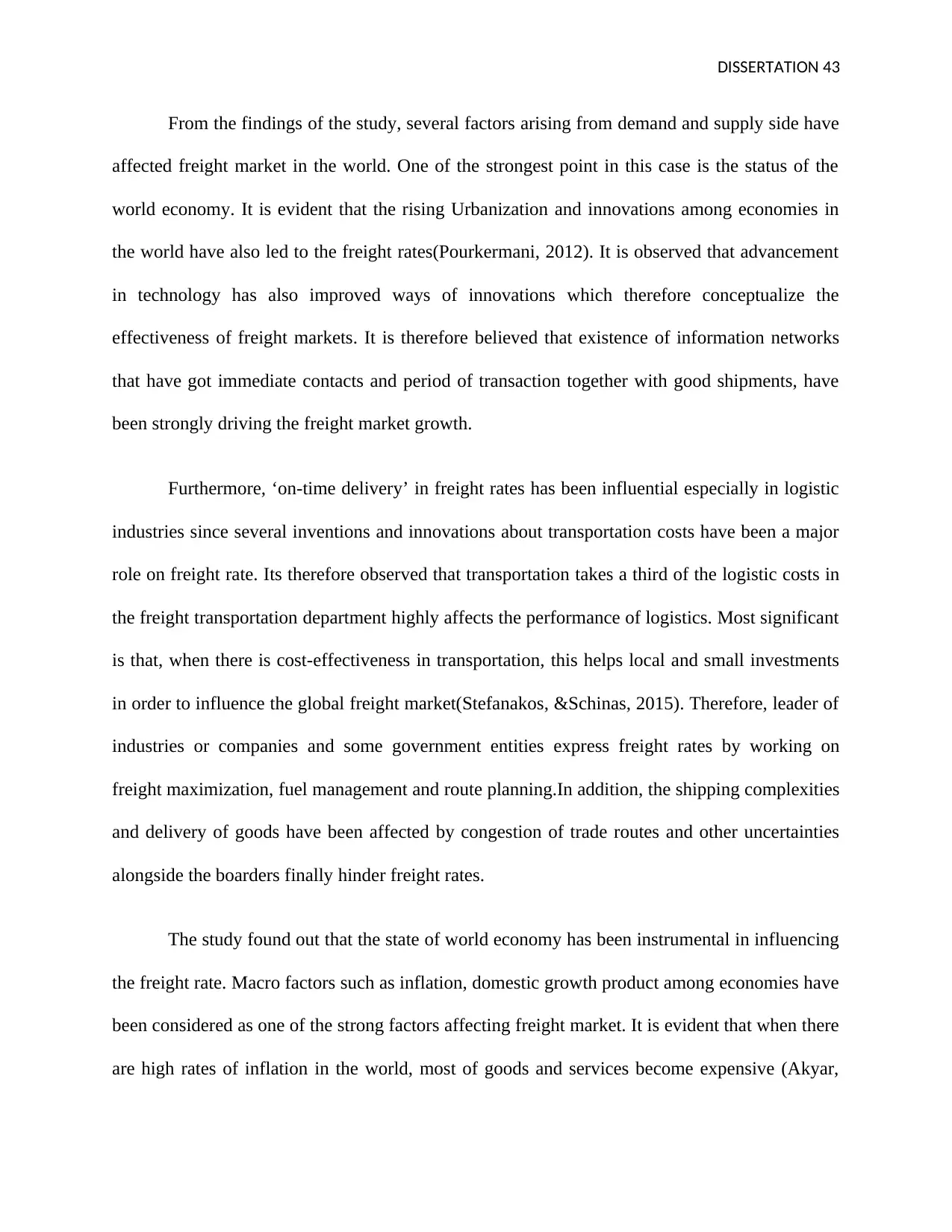
DISSERTATION 43
From the findings of the study, several factors arising from demand and supply side have
affected freight market in the world. One of the strongest point in this case is the status of the
world economy. It is evident that the rising Urbanization and innovations among economies in
the world have also led to the freight rates(Pourkermani, 2012). It is observed that advancement
in technology has also improved ways of innovations which therefore conceptualize the
effectiveness of freight markets. It is therefore believed that existence of information networks
that have got immediate contacts and period of transaction together with good shipments, have
been strongly driving the freight market growth.
Furthermore, ‘on-time delivery’ in freight rates has been influential especially in logistic
industries since several inventions and innovations about transportation costs have been a major
role on freight rate. Its therefore observed that transportation takes a third of the logistic costs in
the freight transportation department highly affects the performance of logistics. Most significant
is that, when there is cost-effectiveness in transportation, this helps local and small investments
in order to influence the global freight market(Stefanakos, &Schinas, 2015). Therefore, leader of
industries or companies and some government entities express freight rates by working on
freight maximization, fuel management and route planning.In addition, the shipping complexities
and delivery of goods have been affected by congestion of trade routes and other uncertainties
alongside the boarders finally hinder freight rates.
The study found out that the state of world economy has been instrumental in influencing
the freight rate. Macro factors such as inflation, domestic growth product among economies have
been considered as one of the strong factors affecting freight market. It is evident that when there
are high rates of inflation in the world, most of goods and services become expensive (Akyar,
From the findings of the study, several factors arising from demand and supply side have
affected freight market in the world. One of the strongest point in this case is the status of the
world economy. It is evident that the rising Urbanization and innovations among economies in
the world have also led to the freight rates(Pourkermani, 2012). It is observed that advancement
in technology has also improved ways of innovations which therefore conceptualize the
effectiveness of freight markets. It is therefore believed that existence of information networks
that have got immediate contacts and period of transaction together with good shipments, have
been strongly driving the freight market growth.
Furthermore, ‘on-time delivery’ in freight rates has been influential especially in logistic
industries since several inventions and innovations about transportation costs have been a major
role on freight rate. Its therefore observed that transportation takes a third of the logistic costs in
the freight transportation department highly affects the performance of logistics. Most significant
is that, when there is cost-effectiveness in transportation, this helps local and small investments
in order to influence the global freight market(Stefanakos, &Schinas, 2015). Therefore, leader of
industries or companies and some government entities express freight rates by working on
freight maximization, fuel management and route planning.In addition, the shipping complexities
and delivery of goods have been affected by congestion of trade routes and other uncertainties
alongside the boarders finally hinder freight rates.
The study found out that the state of world economy has been instrumental in influencing
the freight rate. Macro factors such as inflation, domestic growth product among economies have
been considered as one of the strong factors affecting freight market. It is evident that when there
are high rates of inflation in the world, most of goods and services become expensive (Akyar,
Paraphrase This Document
Need a fresh take? Get an instant paraphrase of this document with our AI Paraphraser
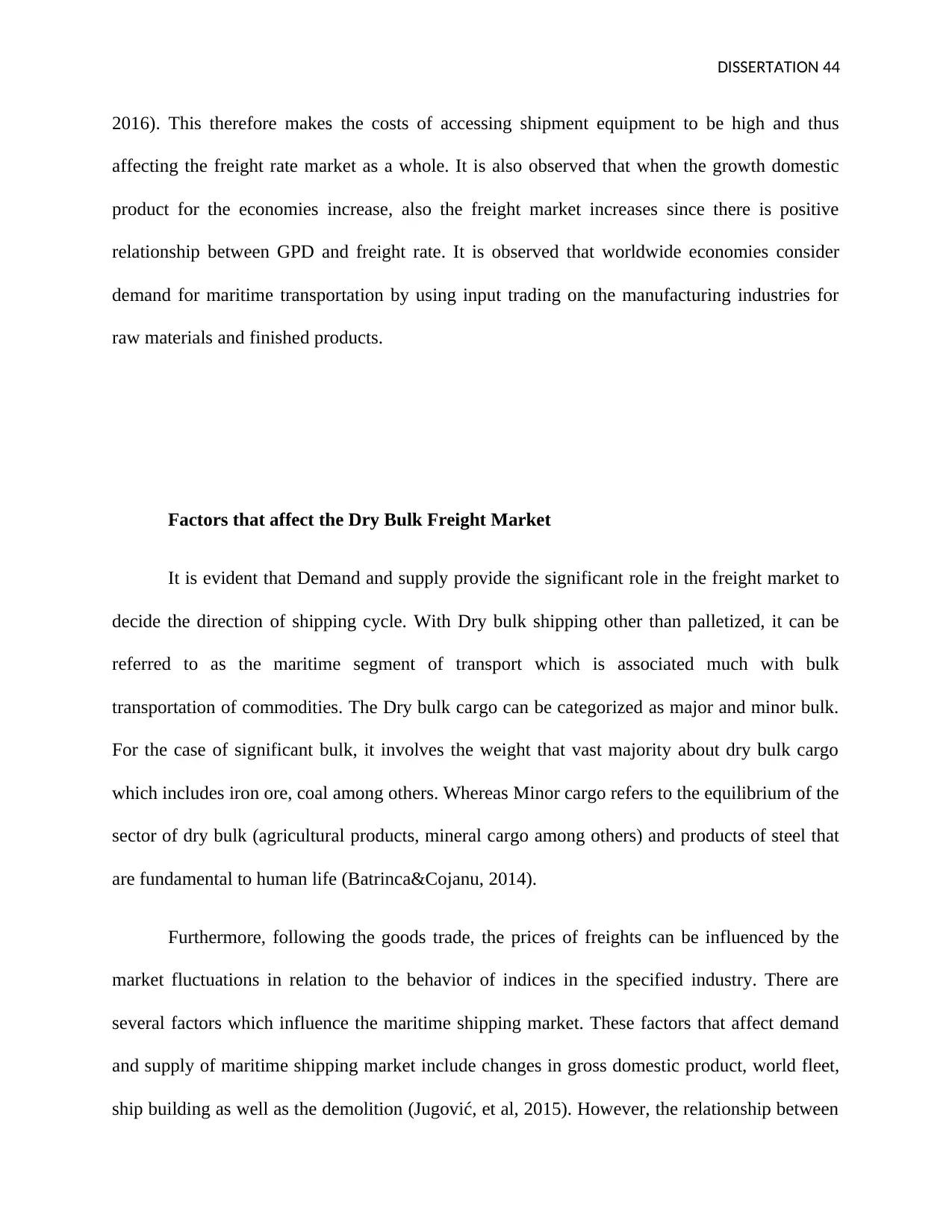
DISSERTATION 44
2016). This therefore makes the costs of accessing shipment equipment to be high and thus
affecting the freight rate market as a whole. It is also observed that when the growth domestic
product for the economies increase, also the freight market increases since there is positive
relationship between GPD and freight rate. It is observed that worldwide economies consider
demand for maritime transportation by using input trading on the manufacturing industries for
raw materials and finished products.
Factors that affect the Dry Bulk Freight Market
It is evident that Demand and supply provide the significant role in the freight market to
decide the direction of shipping cycle. With Dry bulk shipping other than palletized, it can be
referred to as the maritime segment of transport which is associated much with bulk
transportation of commodities. The Dry bulk cargo can be categorized as major and minor bulk.
For the case of significant bulk, it involves the weight that vast majority about dry bulk cargo
which includes iron ore, coal among others. Whereas Minor cargo refers to the equilibrium of the
sector of dry bulk (agricultural products, mineral cargo among others) and products of steel that
are fundamental to human life (Batrinca&Cojanu, 2014).
Furthermore, following the goods trade, the prices of freights can be influenced by the
market fluctuations in relation to the behavior of indices in the specified industry. There are
several factors which influence the maritime shipping market. These factors that affect demand
and supply of maritime shipping market include changes in gross domestic product, world fleet,
ship building as well as the demolition (Jugović, et al, 2015). However, the relationship between
2016). This therefore makes the costs of accessing shipment equipment to be high and thus
affecting the freight rate market as a whole. It is also observed that when the growth domestic
product for the economies increase, also the freight market increases since there is positive
relationship between GPD and freight rate. It is observed that worldwide economies consider
demand for maritime transportation by using input trading on the manufacturing industries for
raw materials and finished products.
Factors that affect the Dry Bulk Freight Market
It is evident that Demand and supply provide the significant role in the freight market to
decide the direction of shipping cycle. With Dry bulk shipping other than palletized, it can be
referred to as the maritime segment of transport which is associated much with bulk
transportation of commodities. The Dry bulk cargo can be categorized as major and minor bulk.
For the case of significant bulk, it involves the weight that vast majority about dry bulk cargo
which includes iron ore, coal among others. Whereas Minor cargo refers to the equilibrium of the
sector of dry bulk (agricultural products, mineral cargo among others) and products of steel that
are fundamental to human life (Batrinca&Cojanu, 2014).
Furthermore, following the goods trade, the prices of freights can be influenced by the
market fluctuations in relation to the behavior of indices in the specified industry. There are
several factors which influence the maritime shipping market. These factors that affect demand
and supply of maritime shipping market include changes in gross domestic product, world fleet,
ship building as well as the demolition (Jugović, et al, 2015). However, the relationship between
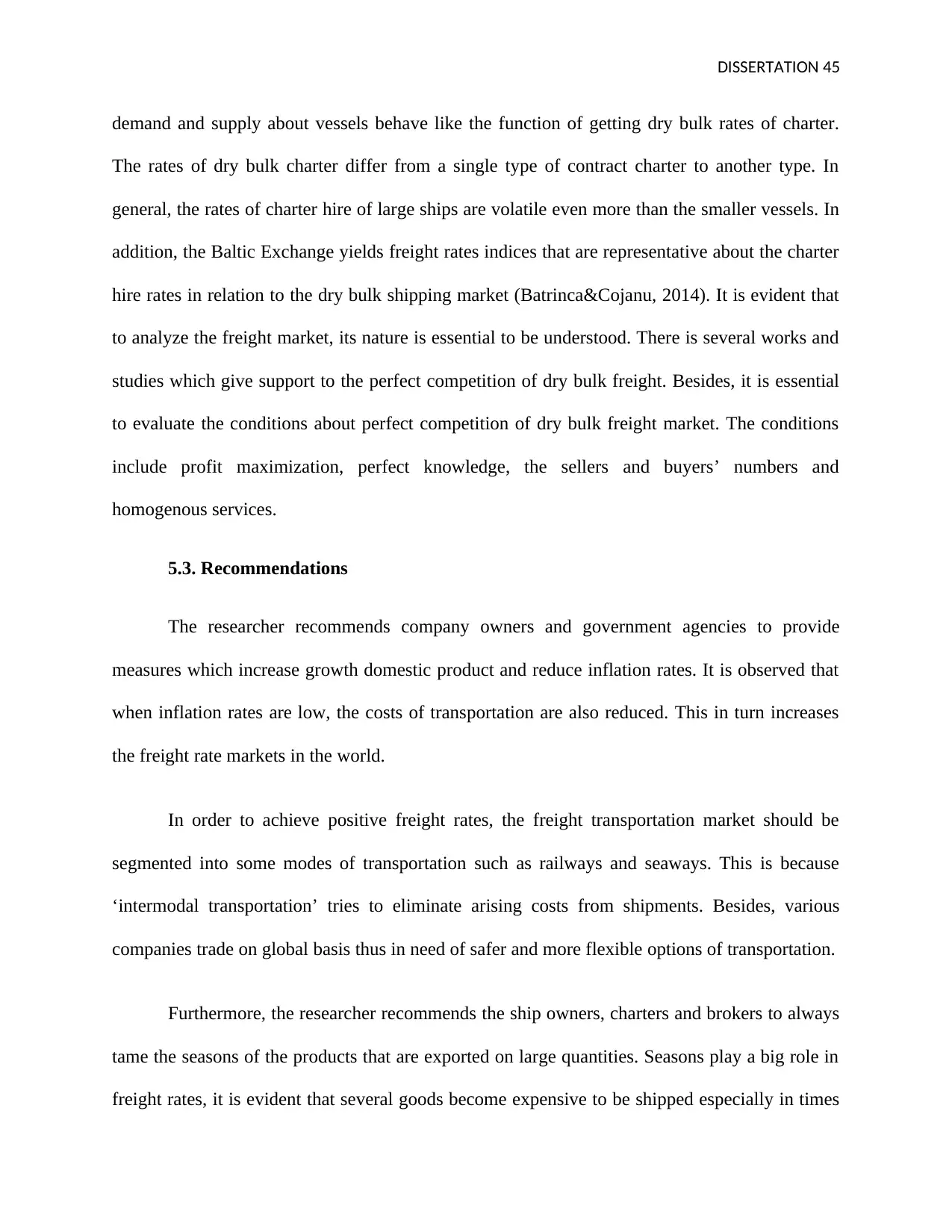
DISSERTATION 45
demand and supply about vessels behave like the function of getting dry bulk rates of charter.
The rates of dry bulk charter differ from a single type of contract charter to another type. In
general, the rates of charter hire of large ships are volatile even more than the smaller vessels. In
addition, the Baltic Exchange yields freight rates indices that are representative about the charter
hire rates in relation to the dry bulk shipping market (Batrinca&Cojanu, 2014). It is evident that
to analyze the freight market, its nature is essential to be understood. There is several works and
studies which give support to the perfect competition of dry bulk freight. Besides, it is essential
to evaluate the conditions about perfect competition of dry bulk freight market. The conditions
include profit maximization, perfect knowledge, the sellers and buyers’ numbers and
homogenous services.
5.3. Recommendations
The researcher recommends company owners and government agencies to provide
measures which increase growth domestic product and reduce inflation rates. It is observed that
when inflation rates are low, the costs of transportation are also reduced. This in turn increases
the freight rate markets in the world.
In order to achieve positive freight rates, the freight transportation market should be
segmented into some modes of transportation such as railways and seaways. This is because
‘intermodal transportation’ tries to eliminate arising costs from shipments. Besides, various
companies trade on global basis thus in need of safer and more flexible options of transportation.
Furthermore, the researcher recommends the ship owners, charters and brokers to always
tame the seasons of the products that are exported on large quantities. Seasons play a big role in
freight rates, it is evident that several goods become expensive to be shipped especially in times
demand and supply about vessels behave like the function of getting dry bulk rates of charter.
The rates of dry bulk charter differ from a single type of contract charter to another type. In
general, the rates of charter hire of large ships are volatile even more than the smaller vessels. In
addition, the Baltic Exchange yields freight rates indices that are representative about the charter
hire rates in relation to the dry bulk shipping market (Batrinca&Cojanu, 2014). It is evident that
to analyze the freight market, its nature is essential to be understood. There is several works and
studies which give support to the perfect competition of dry bulk freight. Besides, it is essential
to evaluate the conditions about perfect competition of dry bulk freight market. The conditions
include profit maximization, perfect knowledge, the sellers and buyers’ numbers and
homogenous services.
5.3. Recommendations
The researcher recommends company owners and government agencies to provide
measures which increase growth domestic product and reduce inflation rates. It is observed that
when inflation rates are low, the costs of transportation are also reduced. This in turn increases
the freight rate markets in the world.
In order to achieve positive freight rates, the freight transportation market should be
segmented into some modes of transportation such as railways and seaways. This is because
‘intermodal transportation’ tries to eliminate arising costs from shipments. Besides, various
companies trade on global basis thus in need of safer and more flexible options of transportation.
Furthermore, the researcher recommends the ship owners, charters and brokers to always
tame the seasons of the products that are exported on large quantities. Seasons play a big role in
freight rates, it is evident that several goods become expensive to be shipped especially in times
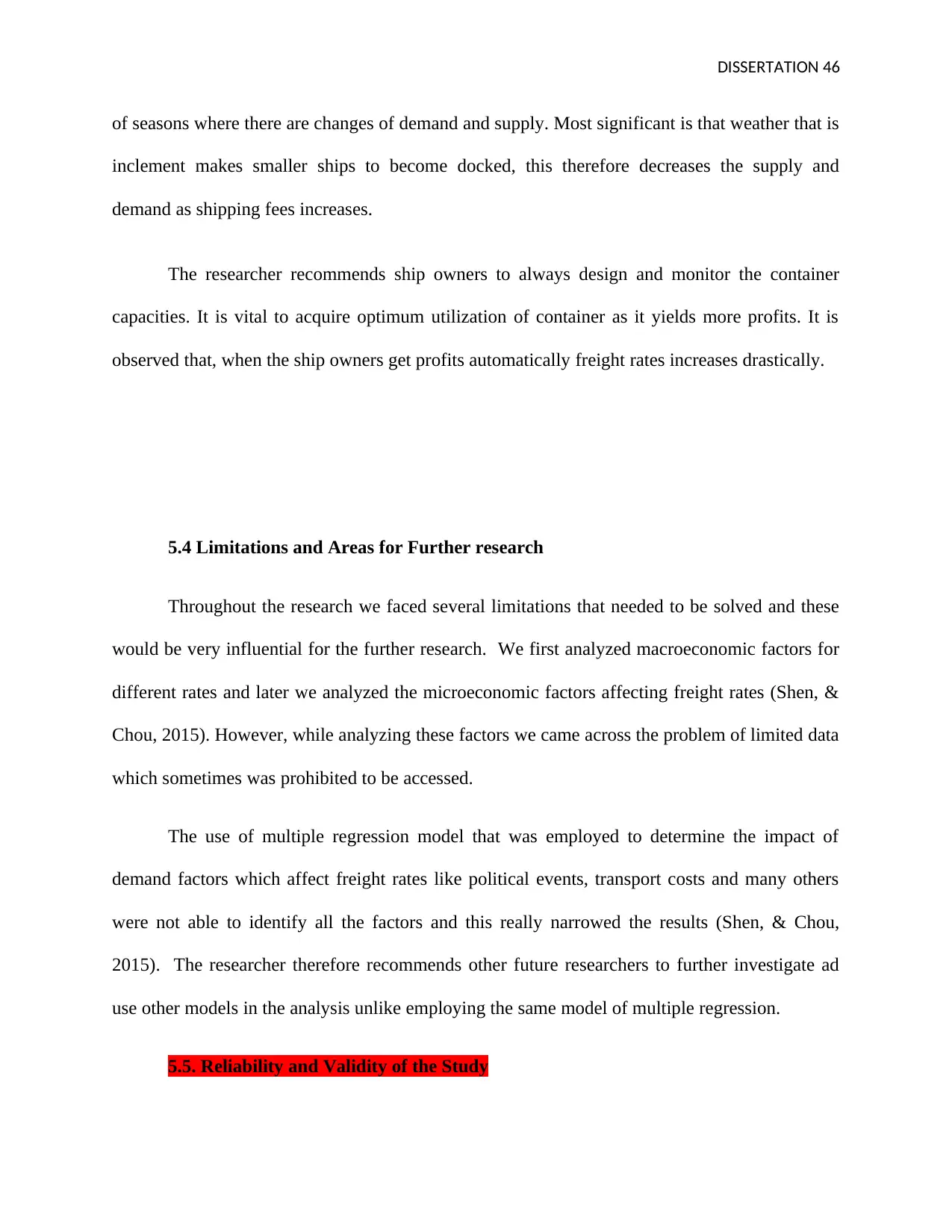
DISSERTATION 46
of seasons where there are changes of demand and supply. Most significant is that weather that is
inclement makes smaller ships to become docked, this therefore decreases the supply and
demand as shipping fees increases.
The researcher recommends ship owners to always design and monitor the container
capacities. It is vital to acquire optimum utilization of container as it yields more profits. It is
observed that, when the ship owners get profits automatically freight rates increases drastically.
5.4 Limitations and Areas for Further research
Throughout the research we faced several limitations that needed to be solved and these
would be very influential for the further research. We first analyzed macroeconomic factors for
different rates and later we analyzed the microeconomic factors affecting freight rates (Shen, &
Chou, 2015). However, while analyzing these factors we came across the problem of limited data
which sometimes was prohibited to be accessed.
The use of multiple regression model that was employed to determine the impact of
demand factors which affect freight rates like political events, transport costs and many others
were not able to identify all the factors and this really narrowed the results (Shen, & Chou,
2015). The researcher therefore recommends other future researchers to further investigate ad
use other models in the analysis unlike employing the same model of multiple regression.
5.5. Reliability and Validity of the Study
of seasons where there are changes of demand and supply. Most significant is that weather that is
inclement makes smaller ships to become docked, this therefore decreases the supply and
demand as shipping fees increases.
The researcher recommends ship owners to always design and monitor the container
capacities. It is vital to acquire optimum utilization of container as it yields more profits. It is
observed that, when the ship owners get profits automatically freight rates increases drastically.
5.4 Limitations and Areas for Further research
Throughout the research we faced several limitations that needed to be solved and these
would be very influential for the further research. We first analyzed macroeconomic factors for
different rates and later we analyzed the microeconomic factors affecting freight rates (Shen, &
Chou, 2015). However, while analyzing these factors we came across the problem of limited data
which sometimes was prohibited to be accessed.
The use of multiple regression model that was employed to determine the impact of
demand factors which affect freight rates like political events, transport costs and many others
were not able to identify all the factors and this really narrowed the results (Shen, & Chou,
2015). The researcher therefore recommends other future researchers to further investigate ad
use other models in the analysis unlike employing the same model of multiple regression.
5.5. Reliability and Validity of the Study
Secure Best Marks with AI Grader
Need help grading? Try our AI Grader for instant feedback on your assignments.
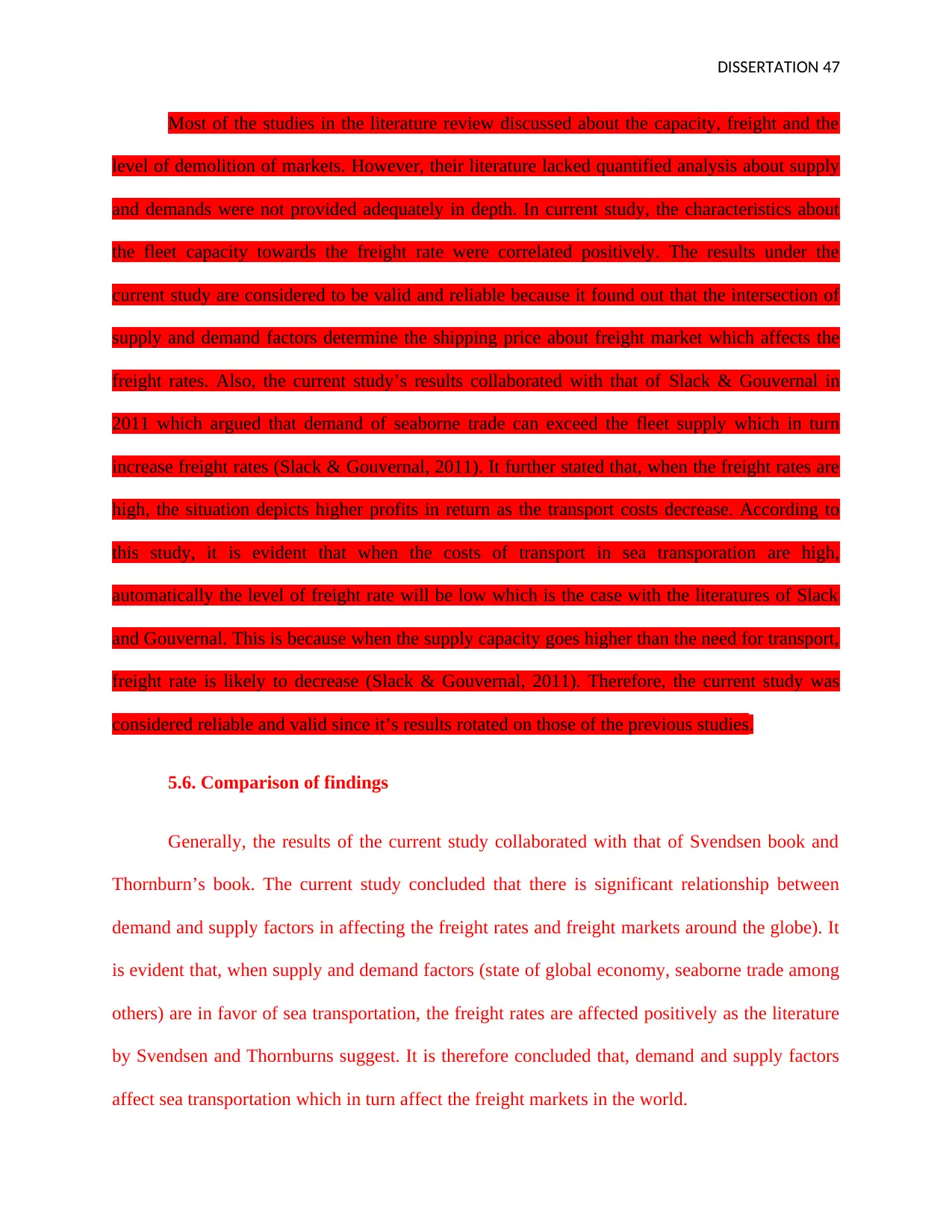
DISSERTATION 47
Most of the studies in the literature review discussed about the capacity, freight and the
level of demolition of markets. However, their literature lacked quantified analysis about supply
and demands were not provided adequately in depth. In current study, the characteristics about
the fleet capacity towards the freight rate were correlated positively. The results under the
current study are considered to be valid and reliable because it found out that the intersection of
supply and demand factors determine the shipping price about freight market which affects the
freight rates. Also, the current study’s results collaborated with that of Slack & Gouvernal in
2011 which argued that demand of seaborne trade can exceed the fleet supply which in turn
increase freight rates (Slack & Gouvernal, 2011). It further stated that, when the freight rates are
high, the situation depicts higher profits in return as the transport costs decrease. According to
this study, it is evident that when the costs of transport in sea transporation are high,
automatically the level of freight rate will be low which is the case with the literatures of Slack
and Gouvernal. This is because when the supply capacity goes higher than the need for transport,
freight rate is likely to decrease (Slack & Gouvernal, 2011). Therefore, the current study was
considered reliable and valid since it’s results rotated on those of the previous studies.
5.6. Comparison of findings
Generally, the results of the current study collaborated with that of Svendsen book and
Thornburn’s book. The current study concluded that there is significant relationship between
demand and supply factors in affecting the freight rates and freight markets around the globe). It
is evident that, when supply and demand factors (state of global economy, seaborne trade among
others) are in favor of sea transportation, the freight rates are affected positively as the literature
by Svendsen and Thornburns suggest. It is therefore concluded that, demand and supply factors
affect sea transportation which in turn affect the freight markets in the world.
Most of the studies in the literature review discussed about the capacity, freight and the
level of demolition of markets. However, their literature lacked quantified analysis about supply
and demands were not provided adequately in depth. In current study, the characteristics about
the fleet capacity towards the freight rate were correlated positively. The results under the
current study are considered to be valid and reliable because it found out that the intersection of
supply and demand factors determine the shipping price about freight market which affects the
freight rates. Also, the current study’s results collaborated with that of Slack & Gouvernal in
2011 which argued that demand of seaborne trade can exceed the fleet supply which in turn
increase freight rates (Slack & Gouvernal, 2011). It further stated that, when the freight rates are
high, the situation depicts higher profits in return as the transport costs decrease. According to
this study, it is evident that when the costs of transport in sea transporation are high,
automatically the level of freight rate will be low which is the case with the literatures of Slack
and Gouvernal. This is because when the supply capacity goes higher than the need for transport,
freight rate is likely to decrease (Slack & Gouvernal, 2011). Therefore, the current study was
considered reliable and valid since it’s results rotated on those of the previous studies.
5.6. Comparison of findings
Generally, the results of the current study collaborated with that of Svendsen book and
Thornburn’s book. The current study concluded that there is significant relationship between
demand and supply factors in affecting the freight rates and freight markets around the globe). It
is evident that, when supply and demand factors (state of global economy, seaborne trade among
others) are in favor of sea transportation, the freight rates are affected positively as the literature
by Svendsen and Thornburns suggest. It is therefore concluded that, demand and supply factors
affect sea transportation which in turn affect the freight markets in the world.

DISSERTATION 48
References
Acik, A., Baser, O.2017. The Relationship between Freight Revenues and Vessel Disposal
Decisions. Retrieved from file:///C:/Users/CLIENT/Downloads/Documents/10.30784-
epfad.363721-398867.pdf
Alizadeh, A. H., & Talley, W. K. (2011a). Microeconomic determinants of dry bulk shipping
freight rates and contract times. Transportation, 38(3), 561-579.
Alizadeh, A. H., & Talley, W. K. (2011b). Vessel and voyage determinants of tanker freight
rates and contract times. Transport Policy, 18(5), 665-675.
Allassignmenthelp. 2017. Research onion-made easy to understand and follow. Retrieved from
https://www.allassignmenthelp.co.uk/blog/research-onion-made-easy-to-understand-and-follow/
Akyar, D. 2016. The Effects of Global Economic Growth On Dry Bulk Shipping Markets and
Freight Rates
Batrinca, G. &Cojanu, G. (2014). The determining factors of the dry bulk market freight rates.
International Conference on Economics, Management and Development.
Dai, L., Hu, H., Zhang, D. 2015.An Empirical Analysis of Freight Rate and Vessel Price
Volatility Transmission in Global Dry Bulk Shipping Market. retrieved from
file:///C:/Users/CLIENT/Downloads/Documents/1-s2.0-S2095756415000719-main.pdf
Goulielmos, A. M., &Psifia, M. E. 2009. Forecasting weekly freight rates for one-year time
charter 65 000 dwt bulk carrier, 1989–2008, using nonlinear methods. Maritime Policy &
Management, 36(5), 411-436.
References
Acik, A., Baser, O.2017. The Relationship between Freight Revenues and Vessel Disposal
Decisions. Retrieved from file:///C:/Users/CLIENT/Downloads/Documents/10.30784-
epfad.363721-398867.pdf
Alizadeh, A. H., & Talley, W. K. (2011a). Microeconomic determinants of dry bulk shipping
freight rates and contract times. Transportation, 38(3), 561-579.
Alizadeh, A. H., & Talley, W. K. (2011b). Vessel and voyage determinants of tanker freight
rates and contract times. Transport Policy, 18(5), 665-675.
Allassignmenthelp. 2017. Research onion-made easy to understand and follow. Retrieved from
https://www.allassignmenthelp.co.uk/blog/research-onion-made-easy-to-understand-and-follow/
Akyar, D. 2016. The Effects of Global Economic Growth On Dry Bulk Shipping Markets and
Freight Rates
Batrinca, G. &Cojanu, G. (2014). The determining factors of the dry bulk market freight rates.
International Conference on Economics, Management and Development.
Dai, L., Hu, H., Zhang, D. 2015.An Empirical Analysis of Freight Rate and Vessel Price
Volatility Transmission in Global Dry Bulk Shipping Market. retrieved from
file:///C:/Users/CLIENT/Downloads/Documents/1-s2.0-S2095756415000719-main.pdf
Goulielmos, A. M., &Psifia, M. E. 2009. Forecasting weekly freight rates for one-year time
charter 65 000 dwt bulk carrier, 1989–2008, using nonlinear methods. Maritime Policy &
Management, 36(5), 411-436.
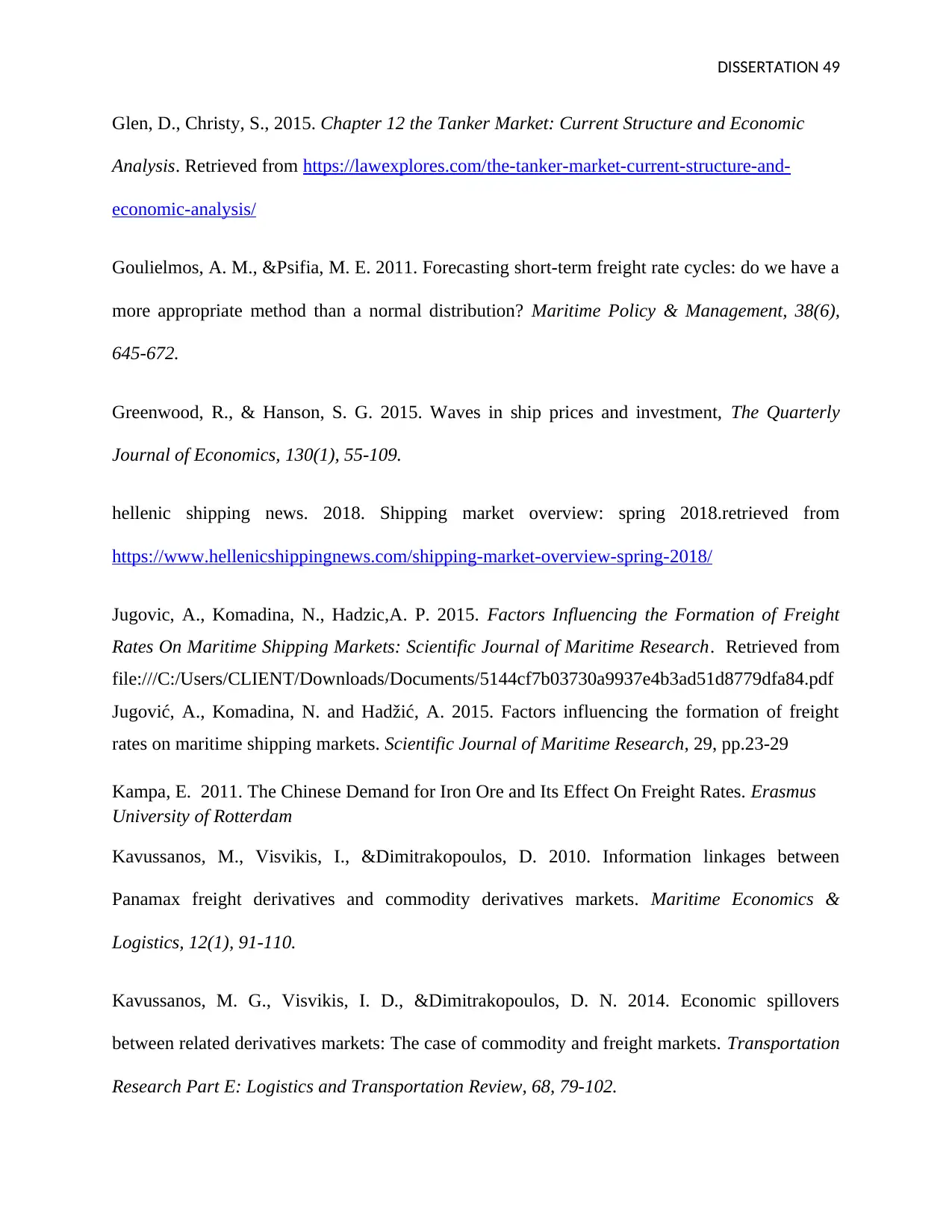
DISSERTATION 49
Glen, D., Christy, S., 2015. Chapter 12 the Tanker Market: Current Structure and Economic
Analysis. Retrieved from https://lawexplores.com/the-tanker-market-current-structure-and-
economic-analysis/
Goulielmos, A. M., &Psifia, M. E. 2011. Forecasting short-term freight rate cycles: do we have a
more appropriate method than a normal distribution? Maritime Policy & Management, 38(6),
645-672.
Greenwood, R., & Hanson, S. G. 2015. Waves in ship prices and investment, The Quarterly
Journal of Economics, 130(1), 55-109.
hellenic shipping news. 2018. Shipping market overview: spring 2018.retrieved from
https://www.hellenicshippingnews.com/shipping-market-overview-spring-2018/
Jugovic, A., Komadina, N., Hadzic,A. P. 2015. Factors Influencing the Formation of Freight
Rates On Maritime Shipping Markets: Scientific Journal of Maritime Research. Retrieved from
file:///C:/Users/CLIENT/Downloads/Documents/5144cf7b03730a9937e4b3ad51d8779dfa84.pdf
Jugović, A., Komadina, N. and Hadžić, A. 2015. Factors influencing the formation of freight
rates on maritime shipping markets. Scientific Journal of Maritime Research, 29, pp.23-29
Kampa, E. 2011. The Chinese Demand for Iron Ore and Its Effect On Freight Rates. Erasmus
University of Rotterdam
Kavussanos, M., Visvikis, I., &Dimitrakopoulos, D. 2010. Information linkages between
Panamax freight derivatives and commodity derivatives markets. Maritime Economics &
Logistics, 12(1), 91-110.
Kavussanos, M. G., Visvikis, I. D., &Dimitrakopoulos, D. N. 2014. Economic spillovers
between related derivatives markets: The case of commodity and freight markets. Transportation
Research Part E: Logistics and Transportation Review, 68, 79-102.
Glen, D., Christy, S., 2015. Chapter 12 the Tanker Market: Current Structure and Economic
Analysis. Retrieved from https://lawexplores.com/the-tanker-market-current-structure-and-
economic-analysis/
Goulielmos, A. M., &Psifia, M. E. 2011. Forecasting short-term freight rate cycles: do we have a
more appropriate method than a normal distribution? Maritime Policy & Management, 38(6),
645-672.
Greenwood, R., & Hanson, S. G. 2015. Waves in ship prices and investment, The Quarterly
Journal of Economics, 130(1), 55-109.
hellenic shipping news. 2018. Shipping market overview: spring 2018.retrieved from
https://www.hellenicshippingnews.com/shipping-market-overview-spring-2018/
Jugovic, A., Komadina, N., Hadzic,A. P. 2015. Factors Influencing the Formation of Freight
Rates On Maritime Shipping Markets: Scientific Journal of Maritime Research. Retrieved from
file:///C:/Users/CLIENT/Downloads/Documents/5144cf7b03730a9937e4b3ad51d8779dfa84.pdf
Jugović, A., Komadina, N. and Hadžić, A. 2015. Factors influencing the formation of freight
rates on maritime shipping markets. Scientific Journal of Maritime Research, 29, pp.23-29
Kampa, E. 2011. The Chinese Demand for Iron Ore and Its Effect On Freight Rates. Erasmus
University of Rotterdam
Kavussanos, M., Visvikis, I., &Dimitrakopoulos, D. 2010. Information linkages between
Panamax freight derivatives and commodity derivatives markets. Maritime Economics &
Logistics, 12(1), 91-110.
Kavussanos, M. G., Visvikis, I. D., &Dimitrakopoulos, D. N. 2014. Economic spillovers
between related derivatives markets: The case of commodity and freight markets. Transportation
Research Part E: Logistics and Transportation Review, 68, 79-102.
Paraphrase This Document
Need a fresh take? Get an instant paraphrase of this document with our AI Paraphraser
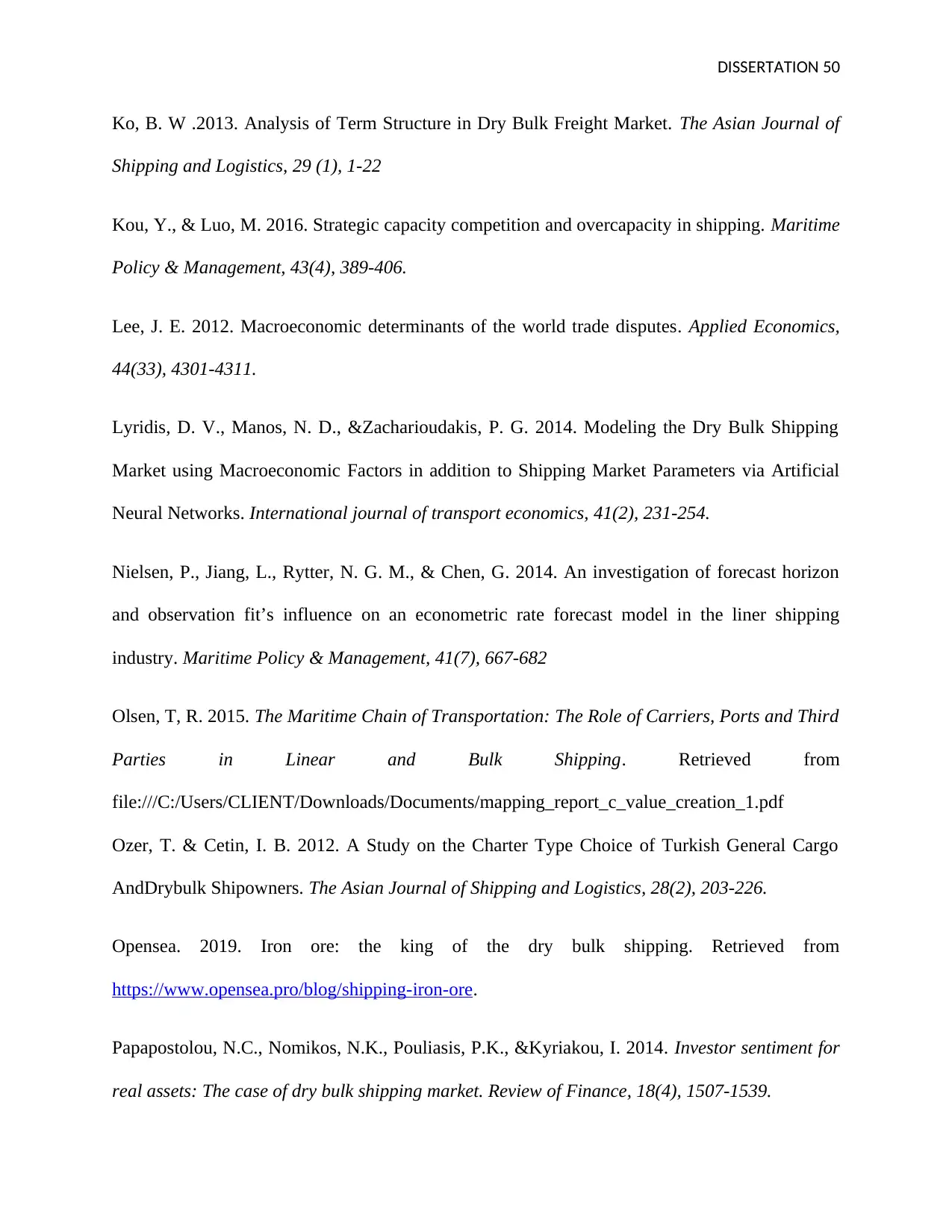
DISSERTATION 50
Ko, B. W .2013. Analysis of Term Structure in Dry Bulk Freight Market. The Asian Journal of
Shipping and Logistics, 29 (1), 1-22
Kou, Y., & Luo, M. 2016. Strategic capacity competition and overcapacity in shipping. Maritime
Policy & Management, 43(4), 389-406.
Lee, J. E. 2012. Macroeconomic determinants of the world trade disputes. Applied Economics,
44(33), 4301-4311.
Lyridis, D. V., Manos, N. D., &Zacharioudakis, P. G. 2014. Modeling the Dry Bulk Shipping
Market using Macroeconomic Factors in addition to Shipping Market Parameters via Artificial
Neural Networks. International journal of transport economics, 41(2), 231-254.
Nielsen, P., Jiang, L., Rytter, N. G. M., & Chen, G. 2014. An investigation of forecast horizon
and observation fit’s influence on an econometric rate forecast model in the liner shipping
industry. Maritime Policy & Management, 41(7), 667-682
Olsen, T, R. 2015. The Maritime Chain of Transportation: The Role of Carriers, Ports and Third
Parties in Linear and Bulk Shipping. Retrieved from
file:///C:/Users/CLIENT/Downloads/Documents/mapping_report_c_value_creation_1.pdf
Ozer, T. & Cetin, I. B. 2012. A Study on the Charter Type Choice of Turkish General Cargo
AndDrybulk Shipowners. The Asian Journal of Shipping and Logistics, 28(2), 203-226.
Opensea. 2019. Iron ore: the king of the dry bulk shipping. Retrieved from
https://www.opensea.pro/blog/shipping-iron-ore.
Papapostolou, N.C., Nomikos, N.K., Pouliasis, P.K., &Kyriakou, I. 2014. Investor sentiment for
real assets: The case of dry bulk shipping market. Review of Finance, 18(4), 1507-1539.
Ko, B. W .2013. Analysis of Term Structure in Dry Bulk Freight Market. The Asian Journal of
Shipping and Logistics, 29 (1), 1-22
Kou, Y., & Luo, M. 2016. Strategic capacity competition and overcapacity in shipping. Maritime
Policy & Management, 43(4), 389-406.
Lee, J. E. 2012. Macroeconomic determinants of the world trade disputes. Applied Economics,
44(33), 4301-4311.
Lyridis, D. V., Manos, N. D., &Zacharioudakis, P. G. 2014. Modeling the Dry Bulk Shipping
Market using Macroeconomic Factors in addition to Shipping Market Parameters via Artificial
Neural Networks. International journal of transport economics, 41(2), 231-254.
Nielsen, P., Jiang, L., Rytter, N. G. M., & Chen, G. 2014. An investigation of forecast horizon
and observation fit’s influence on an econometric rate forecast model in the liner shipping
industry. Maritime Policy & Management, 41(7), 667-682
Olsen, T, R. 2015. The Maritime Chain of Transportation: The Role of Carriers, Ports and Third
Parties in Linear and Bulk Shipping. Retrieved from
file:///C:/Users/CLIENT/Downloads/Documents/mapping_report_c_value_creation_1.pdf
Ozer, T. & Cetin, I. B. 2012. A Study on the Charter Type Choice of Turkish General Cargo
AndDrybulk Shipowners. The Asian Journal of Shipping and Logistics, 28(2), 203-226.
Opensea. 2019. Iron ore: the king of the dry bulk shipping. Retrieved from
https://www.opensea.pro/blog/shipping-iron-ore.
Papapostolou, N.C., Nomikos, N.K., Pouliasis, P.K., &Kyriakou, I. 2014. Investor sentiment for
real assets: The case of dry bulk shipping market. Review of Finance, 18(4), 1507-1539.
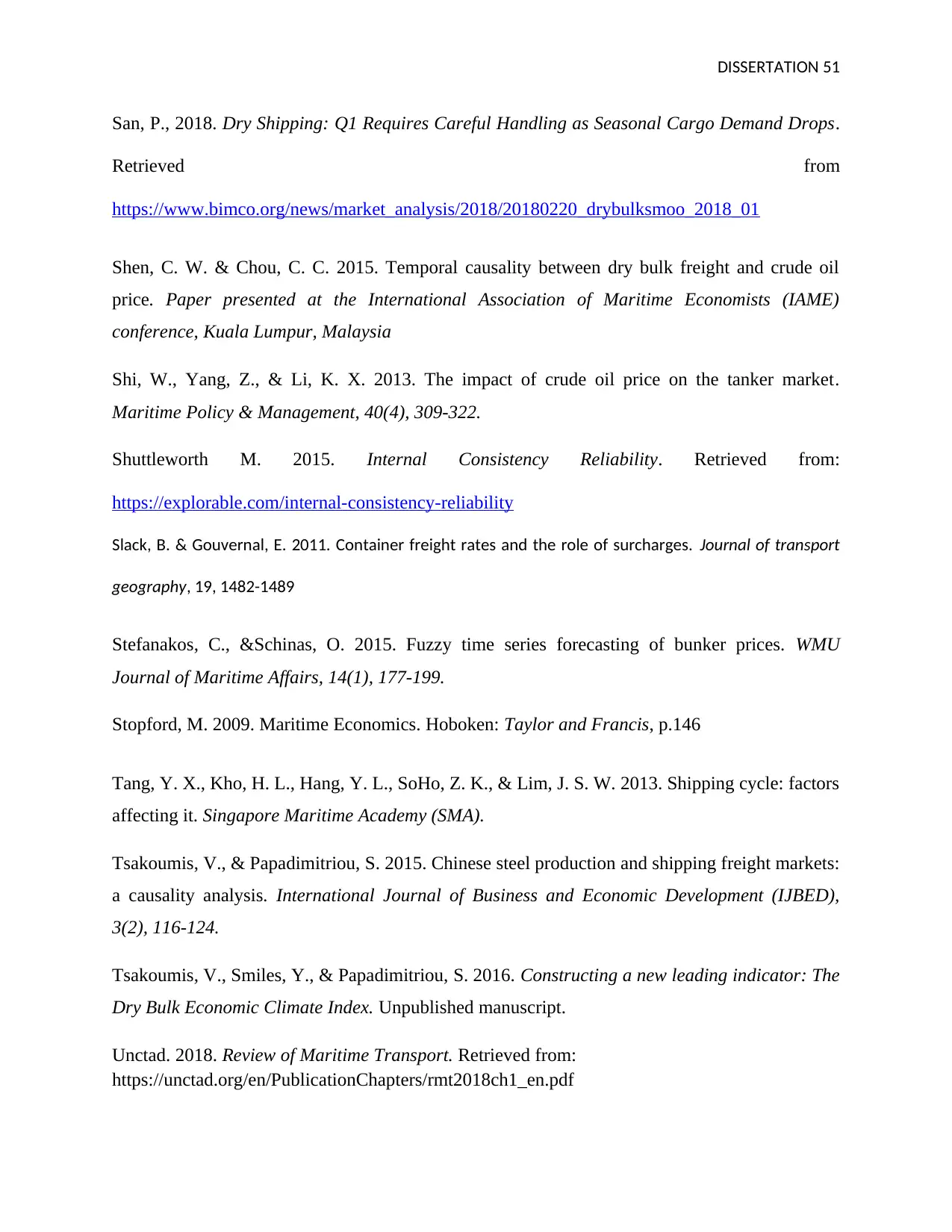
DISSERTATION 51
San, P., 2018. Dry Shipping: Q1 Requires Careful Handling as Seasonal Cargo Demand Drops.
Retrieved from
https://www.bimco.org/news/market_analysis/2018/20180220_drybulksmoo_2018_01
Shen, C. W. & Chou, C. C. 2015. Temporal causality between dry bulk freight and crude oil
price. Paper presented at the International Association of Maritime Economists (IAME)
conference, Kuala Lumpur, Malaysia
Shi, W., Yang, Z., & Li, K. X. 2013. The impact of crude oil price on the tanker market.
Maritime Policy & Management, 40(4), 309-322.
Shuttleworth M. 2015. Internal Consistency Reliability. Retrieved from:
https://explorable.com/internal-consistency-reliability
Slack, B. & Gouvernal, E. 2011. Container freight rates and the role of surcharges. Journal of transport
geography, 19, 1482-1489
Stefanakos, C., &Schinas, O. 2015. Fuzzy time series forecasting of bunker prices. WMU
Journal of Maritime Affairs, 14(1), 177-199.
Stopford, M. 2009. Maritime Economics. Hoboken: Taylor and Francis, p.146
Tang, Y. X., Kho, H. L., Hang, Y. L., SoHo, Z. K., & Lim, J. S. W. 2013. Shipping cycle: factors
affecting it. Singapore Maritime Academy (SMA).
Tsakoumis, V., & Papadimitriou, S. 2015. Chinese steel production and shipping freight markets:
a causality analysis. International Journal of Business and Economic Development (IJBED),
3(2), 116-124.
Tsakoumis, V., Smiles, Y., & Papadimitriou, S. 2016. Constructing a new leading indicator: The
Dry Bulk Economic Climate Index. Unpublished manuscript.
Unctad. 2018. Review of Maritime Transport. Retrieved from:
https://unctad.org/en/PublicationChapters/rmt2018ch1_en.pdf
San, P., 2018. Dry Shipping: Q1 Requires Careful Handling as Seasonal Cargo Demand Drops.
Retrieved from
https://www.bimco.org/news/market_analysis/2018/20180220_drybulksmoo_2018_01
Shen, C. W. & Chou, C. C. 2015. Temporal causality between dry bulk freight and crude oil
price. Paper presented at the International Association of Maritime Economists (IAME)
conference, Kuala Lumpur, Malaysia
Shi, W., Yang, Z., & Li, K. X. 2013. The impact of crude oil price on the tanker market.
Maritime Policy & Management, 40(4), 309-322.
Shuttleworth M. 2015. Internal Consistency Reliability. Retrieved from:
https://explorable.com/internal-consistency-reliability
Slack, B. & Gouvernal, E. 2011. Container freight rates and the role of surcharges. Journal of transport
geography, 19, 1482-1489
Stefanakos, C., &Schinas, O. 2015. Fuzzy time series forecasting of bunker prices. WMU
Journal of Maritime Affairs, 14(1), 177-199.
Stopford, M. 2009. Maritime Economics. Hoboken: Taylor and Francis, p.146
Tang, Y. X., Kho, H. L., Hang, Y. L., SoHo, Z. K., & Lim, J. S. W. 2013. Shipping cycle: factors
affecting it. Singapore Maritime Academy (SMA).
Tsakoumis, V., & Papadimitriou, S. 2015. Chinese steel production and shipping freight markets:
a causality analysis. International Journal of Business and Economic Development (IJBED),
3(2), 116-124.
Tsakoumis, V., Smiles, Y., & Papadimitriou, S. 2016. Constructing a new leading indicator: The
Dry Bulk Economic Climate Index. Unpublished manuscript.
Unctad. 2018. Review of Maritime Transport. Retrieved from:
https://unctad.org/en/PublicationChapters/rmt2018ch1_en.pdf
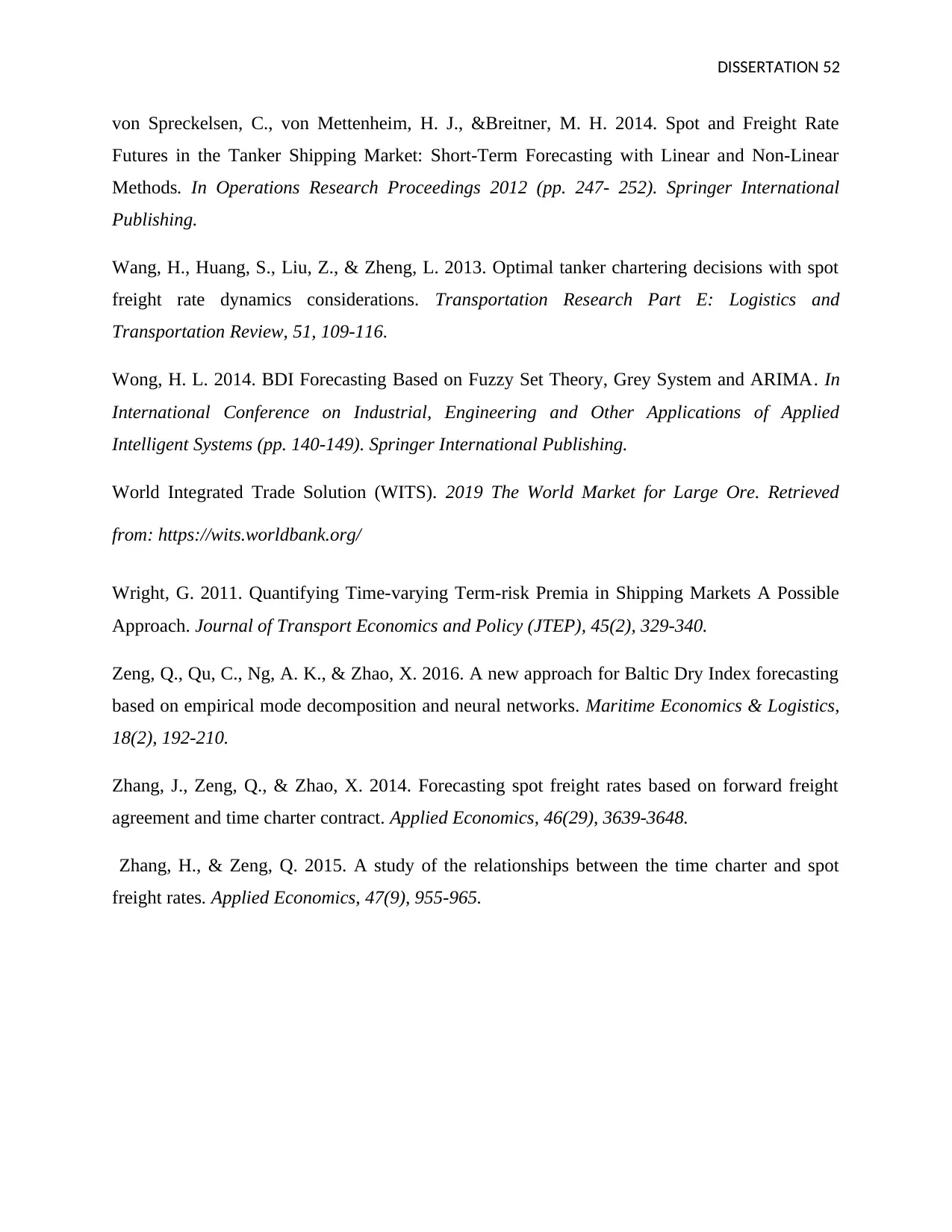
DISSERTATION 52
von Spreckelsen, C., von Mettenheim, H. J., &Breitner, M. H. 2014. Spot and Freight Rate
Futures in the Tanker Shipping Market: Short-Term Forecasting with Linear and Non-Linear
Methods. In Operations Research Proceedings 2012 (pp. 247- 252). Springer International
Publishing.
Wang, H., Huang, S., Liu, Z., & Zheng, L. 2013. Optimal tanker chartering decisions with spot
freight rate dynamics considerations. Transportation Research Part E: Logistics and
Transportation Review, 51, 109-116.
Wong, H. L. 2014. BDI Forecasting Based on Fuzzy Set Theory, Grey System and ARIMA. In
International Conference on Industrial, Engineering and Other Applications of Applied
Intelligent Systems (pp. 140-149). Springer International Publishing.
World Integrated Trade Solution (WITS). 2019 The World Market for Large Ore. Retrieved
from: https://wits.worldbank.org/
Wright, G. 2011. Quantifying Time-varying Term-risk Premia in Shipping Markets A Possible
Approach. Journal of Transport Economics and Policy (JTEP), 45(2), 329-340.
Zeng, Q., Qu, C., Ng, A. K., & Zhao, X. 2016. A new approach for Baltic Dry Index forecasting
based on empirical mode decomposition and neural networks. Maritime Economics & Logistics,
18(2), 192-210.
Zhang, J., Zeng, Q., & Zhao, X. 2014. Forecasting spot freight rates based on forward freight
agreement and time charter contract. Applied Economics, 46(29), 3639-3648.
Zhang, H., & Zeng, Q. 2015. A study of the relationships between the time charter and spot
freight rates. Applied Economics, 47(9), 955-965.
von Spreckelsen, C., von Mettenheim, H. J., &Breitner, M. H. 2014. Spot and Freight Rate
Futures in the Tanker Shipping Market: Short-Term Forecasting with Linear and Non-Linear
Methods. In Operations Research Proceedings 2012 (pp. 247- 252). Springer International
Publishing.
Wang, H., Huang, S., Liu, Z., & Zheng, L. 2013. Optimal tanker chartering decisions with spot
freight rate dynamics considerations. Transportation Research Part E: Logistics and
Transportation Review, 51, 109-116.
Wong, H. L. 2014. BDI Forecasting Based on Fuzzy Set Theory, Grey System and ARIMA. In
International Conference on Industrial, Engineering and Other Applications of Applied
Intelligent Systems (pp. 140-149). Springer International Publishing.
World Integrated Trade Solution (WITS). 2019 The World Market for Large Ore. Retrieved
from: https://wits.worldbank.org/
Wright, G. 2011. Quantifying Time-varying Term-risk Premia in Shipping Markets A Possible
Approach. Journal of Transport Economics and Policy (JTEP), 45(2), 329-340.
Zeng, Q., Qu, C., Ng, A. K., & Zhao, X. 2016. A new approach for Baltic Dry Index forecasting
based on empirical mode decomposition and neural networks. Maritime Economics & Logistics,
18(2), 192-210.
Zhang, J., Zeng, Q., & Zhao, X. 2014. Forecasting spot freight rates based on forward freight
agreement and time charter contract. Applied Economics, 46(29), 3639-3648.
Zhang, H., & Zeng, Q. 2015. A study of the relationships between the time charter and spot
freight rates. Applied Economics, 47(9), 955-965.
Secure Best Marks with AI Grader
Need help grading? Try our AI Grader for instant feedback on your assignments.
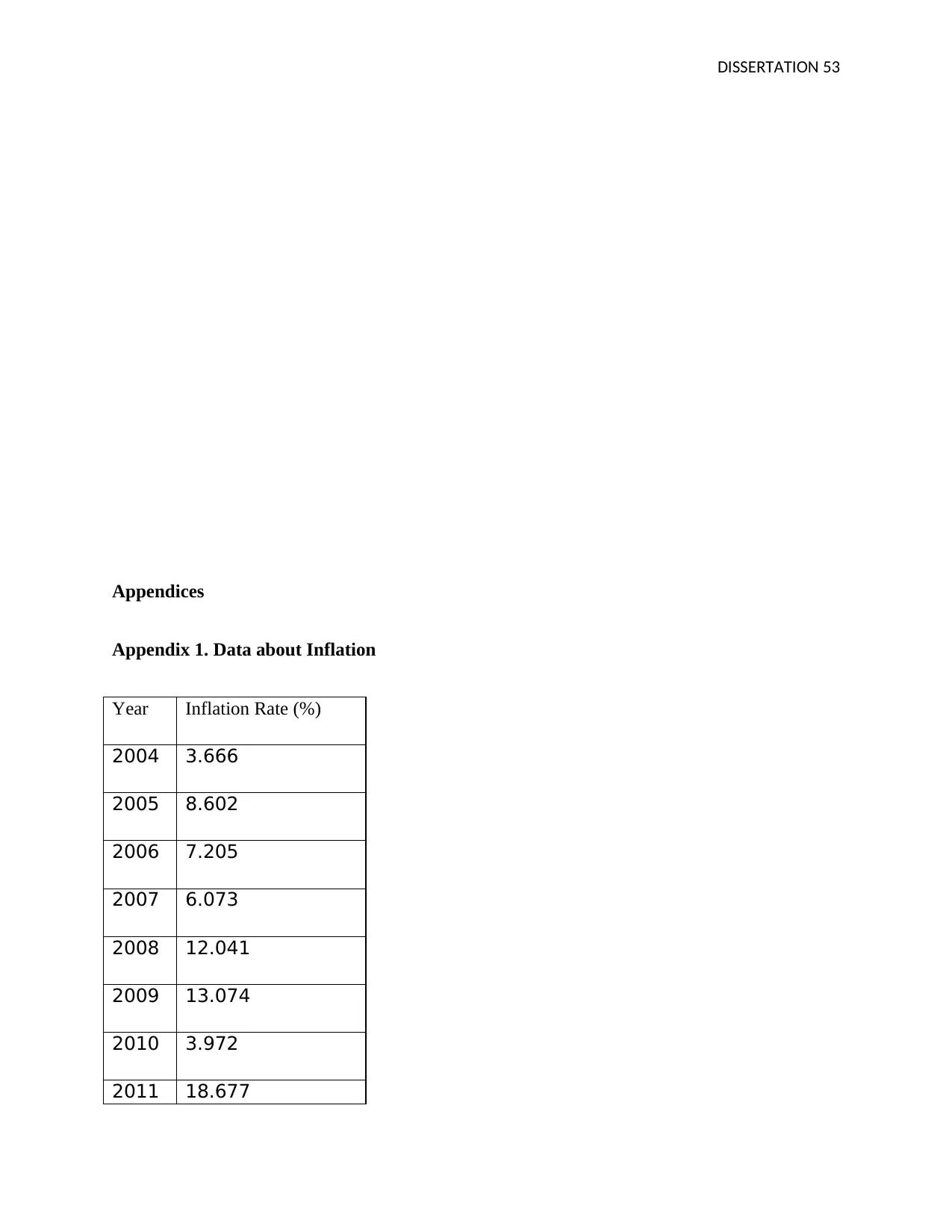
DISSERTATION 53
Appendices
Appendix 1. Data about Inflation
Year Inflation Rate (%)
2004 3.666
2005 8.602
2006 7.205
2007 6.073
2008 12.041
2009 13.074
2010 3.972
2011 18.677
Appendices
Appendix 1. Data about Inflation
Year Inflation Rate (%)
2004 3.666
2005 8.602
2006 7.205
2007 6.073
2008 12.041
2009 13.074
2010 3.972
2011 18.677

DISSERTATION 54
2012 14.017
2013 4.779
2014 4.668
2015 5.59
2016 5.21
2017 5.63
2018 3.83
Source: World Integrated Trade Solution (WITS), 2019
Appendix 2: Shapiro Wilkson’s test Using STATA Package about Inflation rate
2012 14.017
2013 4.779
2014 4.668
2015 5.59
2016 5.21
2017 5.63
2018 3.83
Source: World Integrated Trade Solution (WITS), 2019
Appendix 2: Shapiro Wilkson’s test Using STATA Package about Inflation rate
1 out of 54
Related Documents
Your All-in-One AI-Powered Toolkit for Academic Success.
+13062052269
info@desklib.com
Available 24*7 on WhatsApp / Email
![[object Object]](/_next/static/media/star-bottom.7253800d.svg)
Unlock your academic potential
© 2024 | Zucol Services PVT LTD | All rights reserved.




